


MANAGEMENT

RESILIENCE
How to prepare for increasing uncertainty
MULTIMODAL TRANSPORT
The opportunities and risks
ARTIFICIAL INTELLIGENCE
Training our robots – and people – to improve efficiencies







www.businessmediamags.co.za
2024
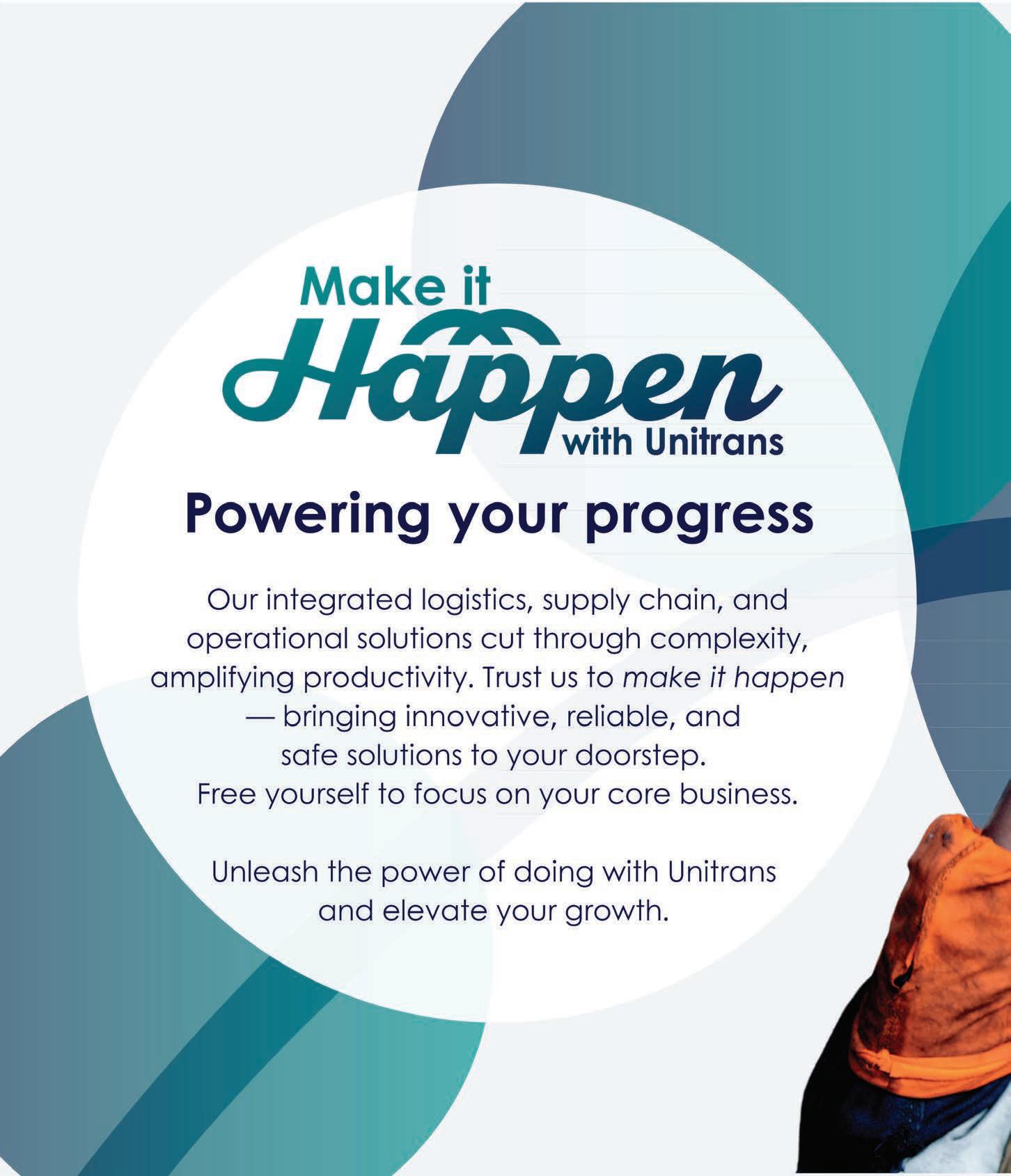
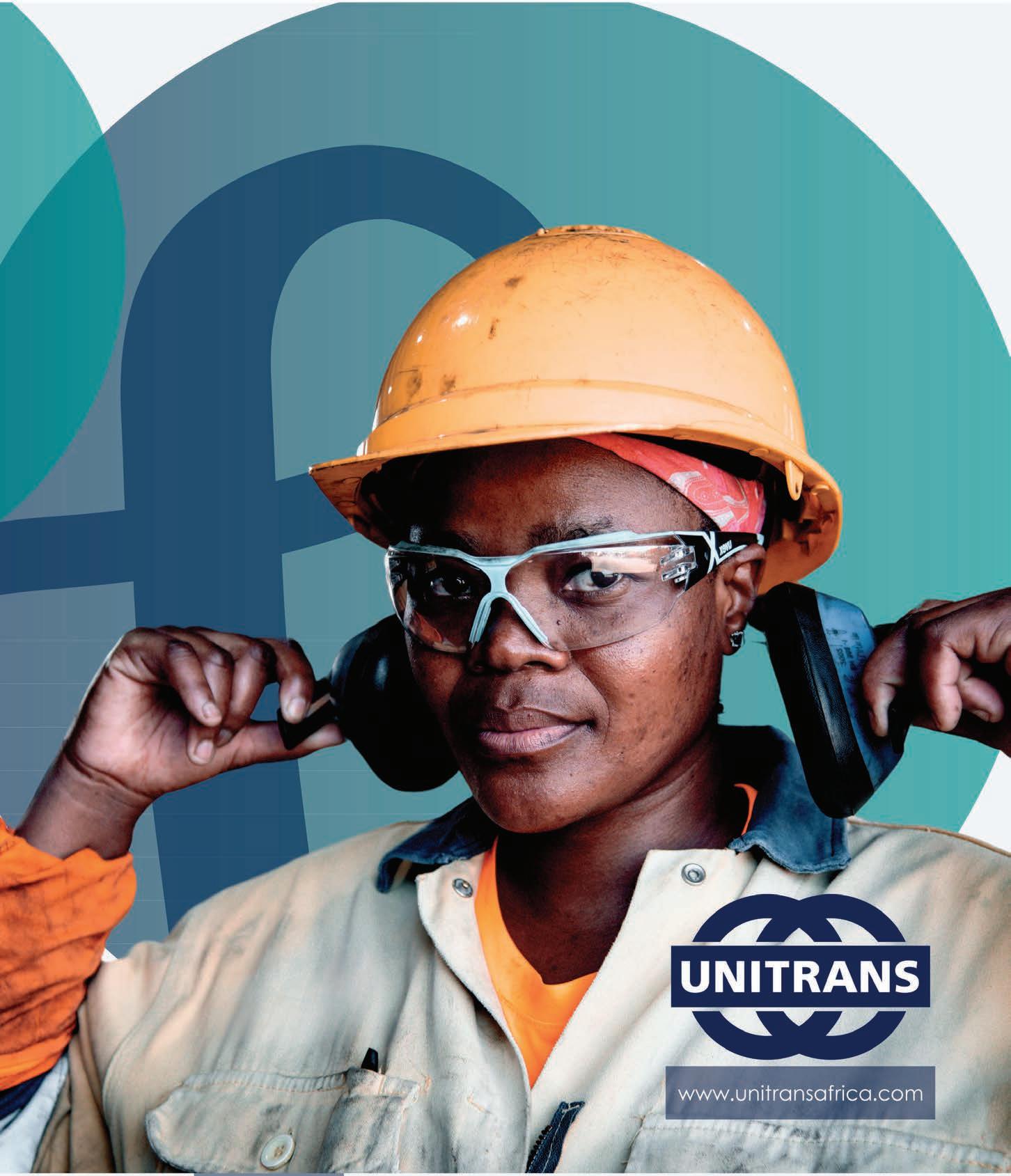

PUBLISHED BY
Picasso Headline, A proud division of Arena Holdings (Pty) Ltd, Hill on Empire, 16 Empire Road (cnr Hillside Road), Parktown, Johannesburg, 2193 PO Box 12500, Mill Street, Cape Town, 8010 www.businessmediamags.co.za
EDITORIAL
Editor: Anthony Sharpe
Content Manager: Raina Julies rainaj@picasso.co.za
Contributors: Keith Bain, Lindi Botha, Mike Brandon, Trevor Crighton, Renier du Preez, Junaid Ebrahim, James Francis, Neil Gouveia, Jacques Greeff, Stephen Howe, Jerome James, Richard King, Itumeleng Mogaki, Elvis Mutseura, Oliver Naidoo, Henry Smith, Rodney Weidemann
Copy Editor: Brenda Bryden
Content Co-ordinator: Natasha Maneveldt
Digital Editor: Stacey Visser
DESIGN
Head of Design: Jayne Macé-Ferguson
Senior Designer: Mfundo Archie Ndzo
Advert Designer: Bulelwa Sotashe
Cover Image: Shutter2U/istockphoto.com
SALES
Project Manager: Tarin-Lee Watts wattst@picasso.co.za | +27 87 379 7119 I +27 79 504 7729
PRODUCTION
Production Editor: Shamiela Brenner
Advertising Co-ordinator: Johan Labuschagne
Subscriptions and Distribution: Fatima Dramat, fatimad@picasso.co.za
Printer: CTP Printers, Cape Town
MANAGEMENT
Management Accountant: Deidre Musha
Business Manager: Lodewyk van der Walt
General Manager, Magazines: Jocelyne Bayer



It’s VUCA time
VUCA. If there was an acronym for our age, this is it. Volatility, uncertainty, complexity and ambiguity have all been on the rise since the introduction of the concept in 1987. While the term itself is a deceptively simple one to describe four discrete challenges, which require discrete responses, it’s a useful starting point for preparing to do business in our increasingly unpredictable world –particularly if you work in supply chain management.
Preparation lies at the heart of resilience – the capacity to withstand, recover from and adapt to challenges. It’s a capacity severely tested in supply chains over the past few years. Thus, it’s apt that we kick off this issue of Supply Chain Management by examining what it takes to build resilience into your supply chain. In a world of increasing VUCA, there are no easy solutions. The best we can do is prepare well, respond quickly and adapt continuously.
Anthony Sharpe, Editor
Contents
9 RESILIENCE
Building and reshaping supply chains.
16
FLEET MANAGEMENT
Integrating fleet management technology to remain competitive.
17 MULTIMODAL
TRANSPORT
The opportunities and risks of transporting goods across various modes.
20 SUSTAINABILITY
Addressing scope 3 emissions – creating greater visibility and capturing data.
27 VISIBILITY
A digital solution is helping to map social and environmental risks across the fragmented rubber supply chain.
28 FOOD AND BEVERAGES
The global food system is in for uninterrupted and unprecedented disruptions.
31 PERISHABLES
Embracing eco-friendly practices.
36 DATA
How do companies corral and prioritise big data?; Transport operators are increasingly turning to collaboration and technology.
42 TECHNOLOGY
Managing supply chains in the cloud.
45 TRANSPORT
Technological advances require a good helping of common sense to unlock their full potential.
46 ARTIFICIAL INTELLIGENCE
Why operators must be careful to train their robots – and their people – carefully.
51 OMNICHANNEL
The multiplying complexities of the omnichannel landscape.
52 E-COMMERCE
Leveraging advanced technologies to cater to personalised demands.
59 COURIER SERVICES
Can the operational challenges of the South African Post Office be solved?
64 RATES
Transport costs remain a source of pressure for manufacturers and freight movers.
67 FINANCE
Organisations need innovative strategies to navigate economic challenges.
71 ENTERPRISE RESOURCE PLANNING
Better planning for better supply chains.
72 SECURITY
Security measures to mitigate risks and protect vehicles and drivers from criminal activities.
76 STANDARDS
Implementing ISO standards improves product quality and ensures sustainability.
81 PORTS
Poor maintenance and a lack of equipment investment have taken their toll on South Africa’s ports.
EDITORIAL COMMENT SUPPLY CHAIN MANAGEMENT 3
COPYRIGHT: No portion of this magazine may be reproduced in any form without written consent of the publisher. The publisher is not responsible for unsolicited material. Supply Chain Management is published by Picasso Headline. The opinions expressed are not necessarily those of Picasso Headline. All advertisements/advertorials have been paid for and therefore do not carry any endorsement by the publisher.
www.businessmediamags.co.za
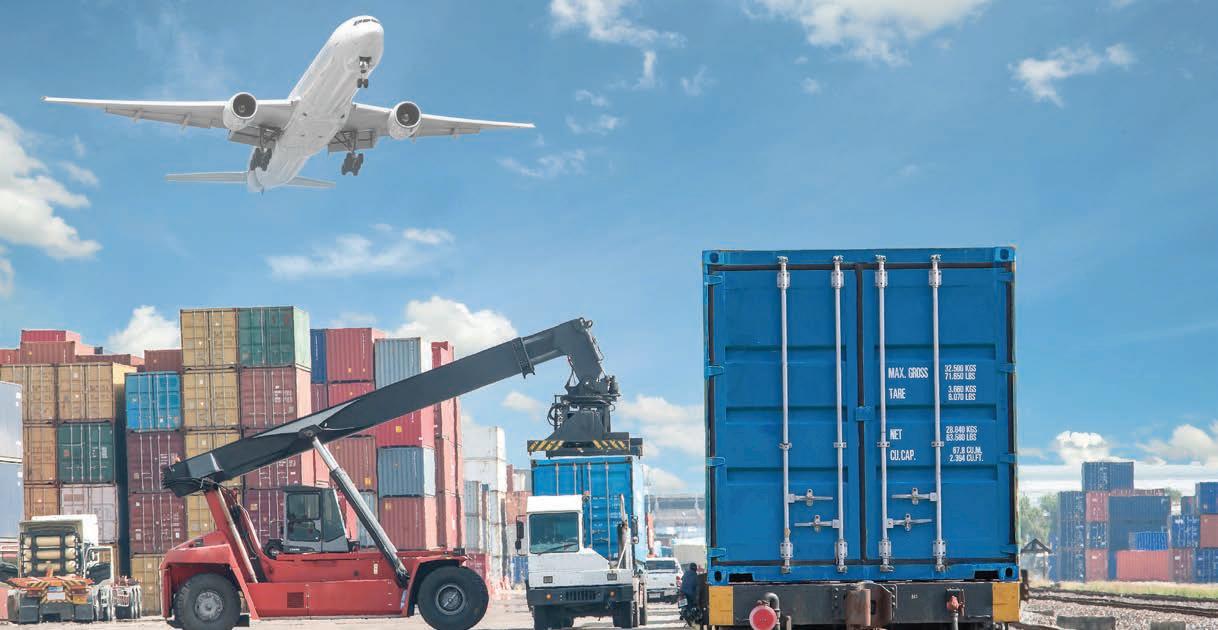




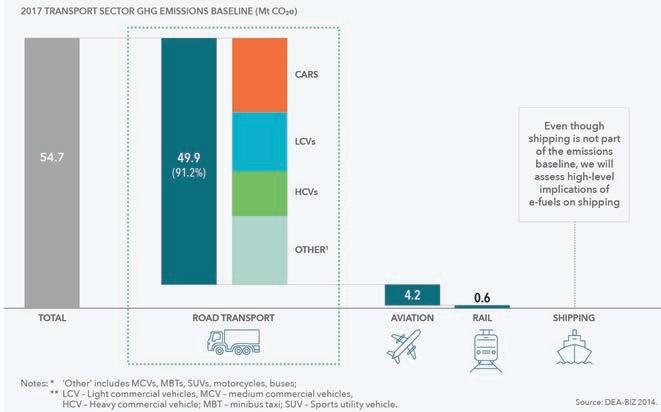



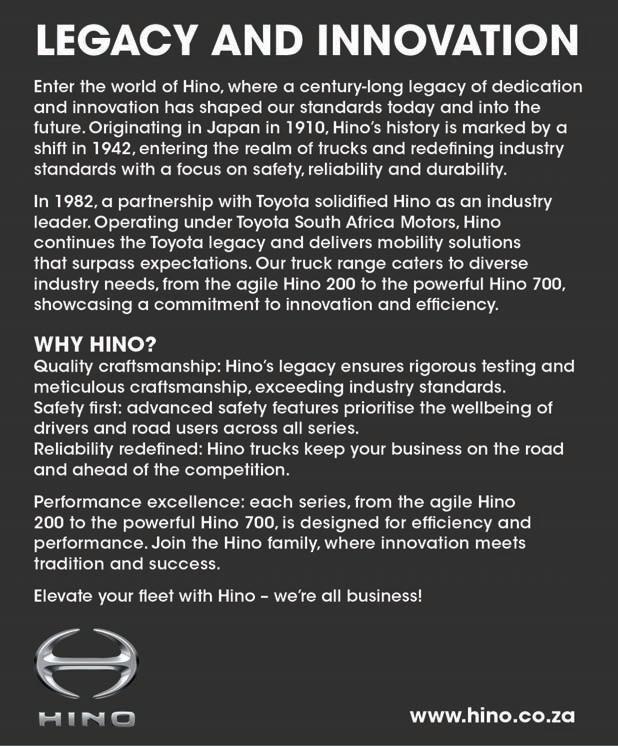




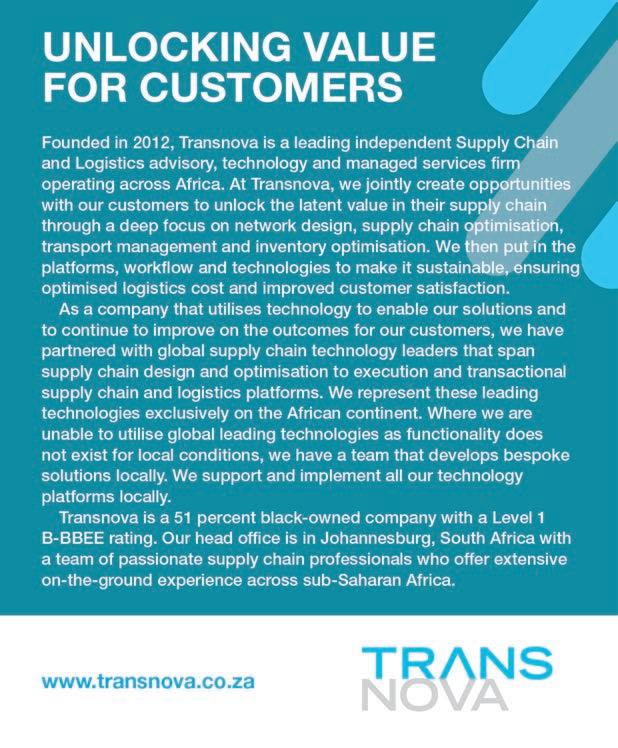
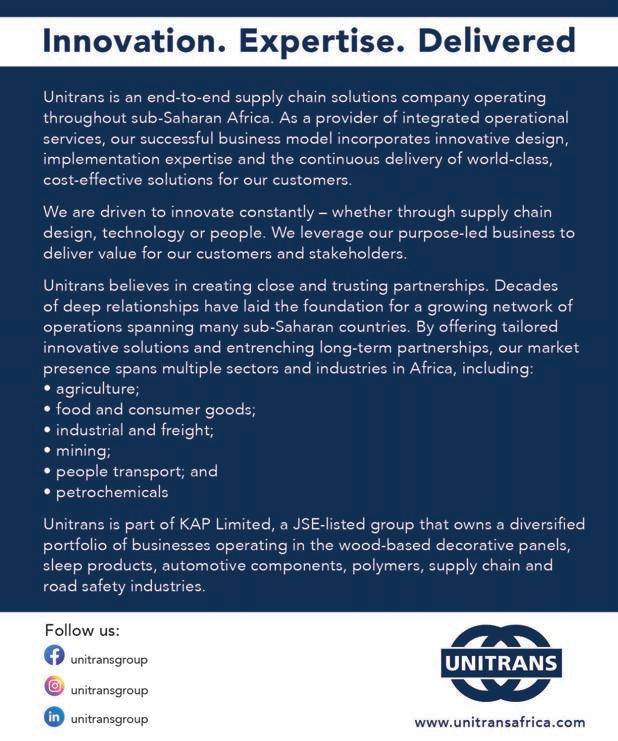
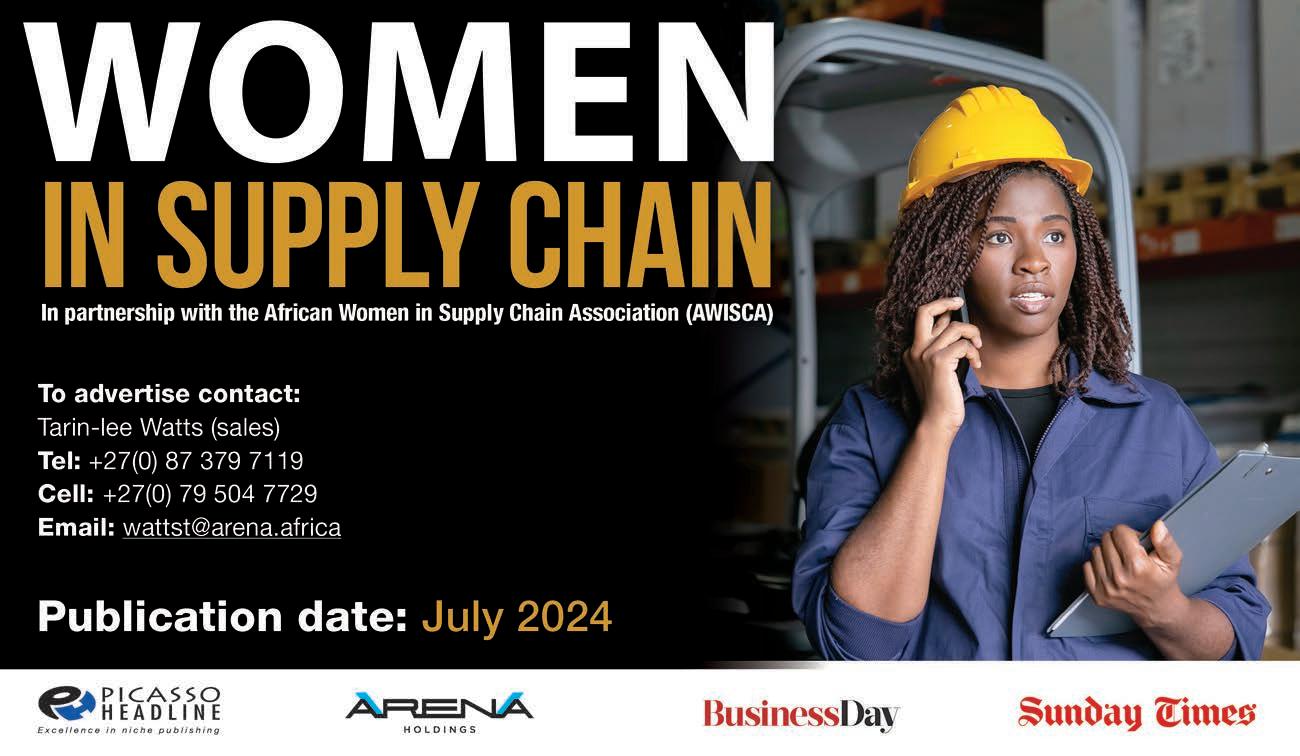

BUILDING SUPPLY CHAIN STRENGTH
With volatility and uncertainty only set to increase, organisations must work to build and reshape supply chains into ones that can withstand and recover from disruption. By
ANTHONY SHARPE
The COVID-19 pandemic demonstrated how susceptible supply chains are to disruption, with the effect of interruptions in one region rippling across the globe to impact others in unpredictable ways for which almost no one was prepared. An EY survey of 200 senior supply chain executives found that more than half experienced serious disruptions and almost three-quarters were negatively affected.
The pandemic may have receded, but supply chains face continued threats from geopolitical instability, climate change, economic upheaval, materials shortages, cyberattacks, environmental, social and governance (ESG) concerns, and more. McKinsey reports that, across industries, companies are likely to be hit by disruptions to their supply chains that last at least a month every 3.7 years.
To cope with an increasingly volatile and unpredictable world, businesses need to
build more resilient supply chains – capable of adapting to change and resisting and recovering from disruption.
SUPPLY CHAIN AUDITS
To build a stronger supply chain, you need to understand what needs to change. That means identifying its potential risks, weaknesses and vulnerabilities through a supply chain audit, says Nisha Singh, sustainable and resilient supply chain lead at Deloitte Africa. “When auditing supply chains for potential risks, weaknesses and vulnerabilities, we consider the applicable regulatory requirements and industry good practices and evaluate the effectiveness of
supply chain processes. The audit’s primary goal is to identify weaknesses, including bottlenecks, disruptions, unmet customer expectations and any other inefficiencies, and help show the diversity and flexibility – or lack thereof – in an organisation’s supply chain.”
Organisations can use the insights from an audit to guide an analysis of the current challenges and identify key priorities for improvement, says Singh. They then need to address those weaknesses by preparing a robust action and improvement plan and executing it with intention. “Moreover, organisations should look to embed sustainability and resilience in their supply chains by tackling challenges that straddle functions and capabilities, such as operational complexity, regulatory attention, geopolitical and macroeconomic issues, changing customer and investor demands and internal capacity challenges.”
“ORGANISATIONS SHOULD LOOK TO EMBED SUSTAINABILITY AND RESILIENCE IN THEIR SUPPLY CHAINS BY TACKLING CHALLENGES THAT STRADDLE FUNCTIONS AND CAPABILITIES.” – NISHA SINGH
SUPPLY CHAIN MANAGEMENT 9 RESILIENCE

THE ESG EFFECT
ESG concerns are coming to the fore in a big way, with an increased focus on scope 3 emissions demanding greater visibility into the supply chain, while regulatory developments, such as the European Union’s Corporate Sustainability Reporting Directive and the Securities and Exchange Commission’s proposed rules on climate-related disclosures, are compelling thousands more companies to delve into and report on their activities.
“Organisations should focus more on ESG as it relates to resilience,” says Singh. “ESG encompasses many issues, each of which can differ significantly for a given organisation. Regarding environmental resilience, organisations must both defend and enhance value in the face of environmental changes.
From a social perspective, they must understand and monitor their reputations, stakeholders’ expectations and the impact of social change on their business. In terms of governance, organisations often need more robust board practices, governance mechanisms, and education of the board and its committees to achieve organisational resilience.”
Singh explains that this calls for clarifying ESG policies and practices in terms of the organisation’s values, business and stakeholder expectations, while also ascertaining that the organisation maintains resilience in the face of ESG-related risks and events. “Given the nature of ESG – particularly the environmental and social elements, which can appear to lack immediacy – the time to act is now rather than ‘some time’ in the future.”
ADAPTING TO CLIMATE CHANGE
From increasingly powerful storms and flooding to heatwaves and wildfires, supply chains are increasingly threatened by extreme weather-related disasters. Climate change is introducing a range of risks, including more frequent and longer-lasting disruptions, more geographical locations in which these occur, structural changes to supply chains and potential reconsideration of contractual terms around force majeure.
Singh says we can expect to see the physical attributes of supply chains change in light of climate change. “The types of products that need moving, how they are moved and
TO BUILD A STRONGER SUPPLY CHAIN, YOU NEED TO UNDERSTAND WHAT NEEDS TO CHANGE. THAT MEANS IDENTIFYING ITS POTENTIAL RISKS, WEAKNESSES AND VULNERABILITIES THROUGH A SUPPLY CHAIN AUDIT.
FAST FACT
A PwC survey of more than 300 business leaders found that only a third saw increasing resilience as a top priority when investing in supply chain technology, but 86 per cent felt their company should invest more in technology to identify, track and measure supply chain risk.
the volumes required will change. Managing exposure to disruptions in supply chains will be critical for organisations. Disruptions will come in the form of supply-demand imbalances and the physical impacts of climate change.”
Singh adds that not only is South Africa exposed to an increase in severe weather events locally, but climate-related disruptions offshore can drastically impact global supply chains upon which companies rely.
Anthony Diack, MD of DSV: Healthcare, says that despite the risks, from the perspective of withstanding extreme weather events, freight companies can’t do much. “There’s no freight mover that can withstand these massive storms. We don’t choose to ship with a given company because their vessels are more
10 SUPPLY CHAIN MANAGEMENT
“SUSTAINABILITY IS AT THE FOREFRONT OF CLIENT NEGOTIATIONS TODAY. PROSPECTIVE CLIENTS ARE LOOKING TO ENGAGE WITH PARTNERS WHO UNDERSTAND THE ENVIRONMENTAL CONCERNS AND ARE WILLING TO DO SOMETHING ABOUT IT.” – ANTHONY DIACK
robust, but we do ship with them because they have a better attitude to the environment.”
This is the crux of building resilience against climate change: organisations must change the way they operate with a view towards long-term environmental health. Diack says that sustainability is at the forefront of client negotiations today. “Prospective clients are looking to engage with partners who understand the environmental concerns and are willing to do something about it. A few years ago, people were talking about it but not actually doing anything, but now we’re seeing a lot more action. And people are willing to put their money where their mouths are. The realisation is dawning that if we’re serious about addressing the climate crisis, it’s not going to come for free.”
Singh says that in a climate-disrupted era, every business must be sustainable or working towards that goal. “Organisations should aim to turn climate risks into opportunities, creating long-term, sustainable impact in the marketplace. Supply chains are at the heart of the climate crisis so they are both critical to the climate change response, by delivering the climate solutions we need to mitigate and adapt, and extremely vulnerable to the impacts of climate change.”
RESILIENCE THROUGH RELATIONSHIPS
The pandemic shone a light on another key issue: capacity shortages, which saw some businesses simply unable to move their goods.
One only has to look at the ongoing operational disruptions at South African ports to understand that this problem isn’t going away any time soon.
Diack says that DSV’s buying power helped it move freight at a time when a lot of containers were sitting at air and sea ports. While he acknowledges that scale helps to build the relationships necessary to keep things moving, it’s also about developing a partnership mentality. “In supply chain, procurement can dictate that you buy cheap and go wherever there’s a deal. But sometimes you need to look at it from a longer-term perspective and build a partnership with service providers. Then if the going gets tough, you know you have a partner on whom you can rely. COVID-19 taught everyone a big lesson. We’re definitely seeing a different discussion in procurement, one focused less purely on price and more on protecting business continuity.”
MANAGING GEOPOLITICAL INSTABILITY
The invasion of Ukraine triggered shortages of fuel and food, the effects of which rippled around the world. Diack says it’s hard to plan for war, but any organisation’s risk analysis needs to involve looking at different sources of supply. “It’s important to be aware of your alternatives. If a supplier is constrained, you need other options, even if they’re more expensive. Better to pay a premium than not have anything at all.”

DEALING WITH MATERIAL SCARCITY
Material shortages can seriously disrupt an organisation’s operations and can be expected to be exacerbated by other risks, such as climate change and geopolitical instability. Nisha Singh of Deloitte Africa recommends the following initiatives to mitigate the risk of materials scarcity, accelerate performance, embrace complexity and build resilience in the supply chain.
• Understand data and employ risk analytics.
• Manage compliance internally and with suppliers.
• Stay agile through diversification of your supplier base.
• Take the time to develop and implement contingency plans in the event that external or internal conditions necessitate a change in supplier.
• Assess suppliers continuously – these assessments must be ongoing and structured to obtain meaningful data.
• Optimise your inventory management.
• Implement lean manufacturing to optimise your resource utilisation.
• Educate suppliers and supply chain professionals.
• Monitor and mitigate risk during the life of a contract. Once you have identified your risks, transform processes to help manage and mitigate those risks. Consider everything from initial due diligence in selecting vendors to offboarding after terminating them.
• Finally, through risk sensing, you can leverage external data to gauge the likelihood of future disruptions –whether expected or emerging as unknowns
Singh says that while it’s difficult for any single entity to address these threats, they must nevertheless plan for them. “This means that organisational leaders should acknowledge that geopolitical forces, such as income inequality, political opportunism and degradation of institutions, threaten economic and cultural structures that have long been taken for granted. Those realities should be factored into strategies, plans and capabilities related to resilience.”
SUPPLY CHAIN MANAGEMENT 11 RESILIENCE
IMAGES: THITIVONG/ISTOCKPHOTO.COM, THITIVONG/ISTOCKPHOTO.COM, SUPHANAT KHUMSAP/ISTOCKPHOTO.COM

cLOSER CONNECTIONS FOR A SMOOTHER SUPPLY CHAIN
Transnova is a privately owned supply chain and logistics solutions company with technology at its heart.
By ANTHONY SHARPE
With a customer base that includes leading local blue chip companies and global players, Transnova is accustomed to creating solutions to complex supply chain challenges. And as supply chains become more complex, so too those challenges.
“The South African supply chain and logistics industry is quite traditional in a way, but there are signs of this changing,” says Transnova CEO Eric Gower-Winter. “As our customer base’s world gets more complex, they transfer that complexity to their service providers in the logistics and supply chain ecosystem. As the world becomes more digitalised, the pressure for fast service and immediate response grows, putting more time and cost pressure on these service providers.”
Gower-Winter says Transnova is positioned as an organisation that helps connect entities in this ecosystem digitally, making it easier for them to interact and removing inefficiencies – thus ultimately trying to reduce the complexities all stakeholders face.
“We blend capabilities in supply chain consulting, technology solutions and operational management to help companies unlock the latent value in their supply chain. We seek to understand a client’s business strategy first, and then design a supply chain strategy and business processes to enable the strategy. We then configure the appropriate IT systems to drive workflow and optimisation to support the business processes.”
A DEEPER UNDERSTANDING
Understanding a client goes beyond just their strategy, however, and encompasses their broader business context. “Our operating model
is crafted with the customer’s context in mind and can be from pure advisory or software provision right through to outsourced managed service,” Gower-Winter explains. “It may be adapted or extended over time to the customer’s changing environment and circumstances.”
It also extends to Transnova’s service provider network, Gower-Winter says. “We often find there are well-established local players in their region who really know their market. We tend to deal with the senior management of these companies and find that these small to medium-sized companies actually provide more cost-effective service in their operating areas. It’s about choosing the providers in the supply chain that align best with the strategy of the customer, not just for a particular asset class.”
KEEPING UP WITH TECH
developed long-standing
Technology lies at the heart of Transnova, says Gower-Winter, so everyone in the business is constantly learning and adapting to external and internal challenges as they relate to its approach. The company partners with large technology companies that offer core platforms, which provide leading technology solutions to base and complex problems. “We have developed long-standing partnerships with leading global technology players for the exclusive use, distribution and local support of these solutions on the continent. We’re

“OUR OPERATING MODEL IS CRAFTED WITH THE CUSTOMER’S CONTEXT IN MIND AND CAN BE FROM PURE ADVISORY OR SOFTWARE PROVISION RIGHT THROUGH TO OUTSOURCED MANAGED SERVICE.” – ERIC GOWER-WINTER
 Eric Gower-Winter
Eric Gower-Winter
as rigorous about choosing our technology partners as we are about hiring employees.”
Gower-Winter stresses that forming relationships with these technology partners is crucial too. “We’re on their respective development roadmaps. We provide them with our marketplace requirements and insights, and they let us know if and when that particular solution will be available.”
If a customer cannot wait or requires something unique, Transnova will build it themselves. “Building and refreshing technology is a never-ending pursuit, however,” says Gower-Winter. “Because we’re practitioners at heart, we want to make sure our customers use the technology properly, so a lot of our focus is on usage behaviour and education.” This comes back to that understanding of a customer’s context, explains Gower-Winter. “When you understand where a customer is going, you can map their future technology needs against that. Once we understand that, we design a solution, implement it side-by-side with their people, have a stabilisation period and ensure our customers are proficient in our technologies and processes before we extract our team. But we always stay behind with our customers in one way or another, providing analytics on how they use the system and refreshing knowledge if needed.”

VALUES BREED VALUE
Ultimately, this drive to understand and connect with clients, technology partners and service providers informs the sort of business Transnova is, says Gower-Winter. “We’re a group of people who share the same values – a group with a deep drive to serve our customers first and foremost. We love solving our customers’ problems and finding solutions to their everyday issues and future challenges. We believe in turning these issues into opportunities with mutual benefit.”

PROFILE Images: Supplied

UNLOCK THE LATENT VALUE IN YOUR SUPPLY CHAIN


Digital transformation in the supply chain and logistics sector is accelerating at a rapid pace. Leading organisations are using the latest technology tools to drive operational efficiencies across their supply chains, writes TRANSNOVA


Digital solutions are automating repeatable tasks to boost effi ciency and promote faster and better decision-making and early adopters are enjoying a competitive advantage in their chosen markets.
THE DRIVE FOR DIGITISATION
Leading companies are focusing their time and resources on developing their core businesses while engaging supply chain experts to deliver technology solutions and support services. However, companies outsourcing their noncore supply chain activities still want to retain a degree of visibility and control. This means having
real-time visibility through interconnected logistics platforms and systems that talk to each other.
Cloud-based supply chain technology platforms leveraging artificial intelligence, big data, blockchain, and the internet of things (IoT) enhance efficiency, transparency and end-to-end visibility. They provide fast, flexible connectivity to multiple partner systems across the supply chain. The automation of processes from order placement through inventory management to delivery confirmation helps reduce manual errors and accelerate operations, improving efficiency. In a data-driven society and the supply chain industry, in particular, technology is the key enabler to optimise performance and reduce costs.


THE DATA REVOLUTION – THE SEARCH FOR A SINGLE VERSION OF THE TRUTH
Data is vital to your business for planning, proactive decision-making, real-time visibility and reporting insights. Supply chain leaders are now prioritising data projects to drive improved operational efficiency and cost reduction.

A recent Gartner survey highlighted that data analysis is the leading priority in supply chain, closely followed by IOT and cloud computing. Through 2024, 50 per cent of supply chain organisations will invest in applications that support artificial intelligence and advanced analytics capabilities.
Integrating artificial intelligence (AI), machine learning (ML) and data analytics is a game-changer. AI and ML advanced analytics models are used to understand complex and hidden relationships in data to predict what will happen and how best to respond to these future scenarios. Leading global companies are using digital twin platforms to create a virtual model of their supply chain to run what-if scenarios, test for resiliency and quantify key trade-offs across growth, profi tability and service levels. This type of platform helps companies assess end-to-end scenarios to solve complex, cross-functional trade-off decisions across the company’s value chain.
14 SUPPLY CHAIN MANAGEMENT
ADVERTORIAL TRANSNOVA

REAL-TIME VISIBILITY
Real-time visibility across the supply chain not only provides valuable insights into the status of inventory, orders and deliveries, but also enables accurate forecasting and proactive decision-making. Real-time integration of data feeds, such as telemetry, real-time pricing and demand signals, enriches existing business processes.
Technologies, such as wearable devices, mobile phones and sensors, are increasingly used to provide live monitoring and visibility across the supply chain. Blockchain technology promises enhanced transparency and traceability in the supply chain through its secure and verifiable record of transactions, reducing the risk of fraud. This type of visibility allows you to respond promptly to disruptions, delays, or changes in demand and keep your customers informed.
Real-time visibility means knowing what has happened, what is happening now, what is likely or going to happen, and what next best possible alternatives are available.
TYPES OF INTERCONNECTED LOGISTICS PLATFORMS AVAILABLE NOW
Integrated interconnected platforms deliver accurate, verifiable and auditable data in the procurement of goods and services, order management, inventory management, transport planning and execution and final settlement. They provide reliable, real-time and actionable information in visible and easy-to-navigate formats.
TRANSPORT MANAGEMENT SYSTEM
A transport management system (TMS) is used to plan freight movements, perform freight rating and
shopping across all modes, select the appropriate route and carrier and manage all associated transport costs, documentation, communication and payments. The TMS facilitates interactions between a company’s order management or warehouse management system and the logistics activities thereafter to ensure ontime delivery to the correct destination at the lowest achievable cost.
At Transnova, we integrate, implement, configure and support the e2open TMS platform for our customers to ensure an automated, auditable systematic allocation of loads to transporters as per the client’s logistics strategy and contracted rates with its transport service providers. This guarantees that the lowest-cost transporter with capacity is always allocated the load where possible to achieve sustainable, system-driven transport savings. With more than 9 million tons managed via our platform each year, we are fortunate to work with over 350 carriers across 6000 lanes, giving us the ability to understand rates for our customers and provide deep transport insights.
Implementing our TMS platform in your organisation gives stakeholders the peace of mind that the lowest cost transport plan is always deployed daily, based on the available resources, while the logistics team has access to more information and data than ever before. Equipped with this intelligence, the logistics team can focus on continuous improvement and look for further opportunities to optimise the logistics network and drive costs out of the business.
INVENTORY OPTIMISATION
Inventory-holding businesses face various challenges that directly impact working capital, product availability, warehousing requirements, cash flow and risk mitigation. Factors, such as

shifting consumer behaviours, constrained shipping services and black swan events, are driving the nearshoring movement and, subsequently, the ability to optimise inventory is now more critical than ever.
Transnova has partnered with Netstock to provide customers with a leading AI-driven inventory optimisation platform to help make better inventory decisions and save working capital. Netstock is a supply chain planning software that uses AI technology to forecast demand, along with easy-tounderstand and adjustable inventory policies, to place orders faster, reduce stockouts, minimise excess inventory and optimise capacity planning. Delivering immediate ROI, our inventory optimisation solution provides customers the visibility to free up working capital, adapt to changes and deliver outstanding customer service.
DIGITAL TWIN
A digital planning twin is an advanced platform that creates an end-to-end replica of a company’s value chain, including financials in a virtual environment. A digital twin provides a fast and easy way to visualise and interact with a company’s value chain and assess the impact of different scenarios on product portfolio mix, capex projects, sustainability goals and profitability.
Transnova is proud to represent River Logic’s industry-leading Digital Twin planning platform in the Middle East and Africa region. We have worked closely with leading companies, such as Philip Morris International, to optimise the blending and manufacturing process and help solve complex, cross-functional trade-off decisions to optimise key objectives, such as growth, margin and service levels.



SUPPLY CHAIN MANAGEMENT 15 ADVERTORIAL TRANSNOVA TRANSNOVA For more information: +27 82 902 5958 www.transnova.co.za Scan to go directly to the Transnova website
Images: Supplied
NAVIGATING THE CYBERSECURITY SEAS
In the dynamic world of supply chain management, where efficiency and real-time decision-making are paramount, integrating sophisticated fleet management hardware and software has become essential for companies to remain competitive. By
HENRY SMITH
, fleet sales director at MiX Telematics Africa

Data, in the ever-evolving landscape of the digital age, has become the lifeblood of technological advancements, shaping our daily experiences. At the forefront of dataintensive technologies is telematics – where telecommunications and informatics are combined to monitor, collect and transmit data. Telematics has found its applications in diverse sectors, including automotive, insurance and logistics, and can help fleet managers save money, improve efficiency and make better decisions.
However, as it opens new frontiers of possibilities, it also raises ethical concerns regarding the vast amounts of data it collects and processes. The potential threats of hacking, malware and data breaches pose a significant risk to the integrity, confidentiality and availability of data and devices within fleet operations.
SECURITY IS VITAL
Telematics solutions are designed to capture a myriad of data, ranging from vehicle speed and location to driver behaviour and fuel usage. While this wealth of information offers unparalleled insights, it also brings potential risks, such as unauthorised access, data breaches and misuse of sensitive information.
This is why data security plays a vital role when choosing a telematics provider. Before implementing fleet management systems, companies should conduct a comprehensive risk assessment and threat modelling exercise. Identifying potential vulnerabilities and understanding the threat landscape will enable them to tailor their cybersecurity measures to specific risks.
In the South African context, where the convergence of physical and cybercrime is on the rise, ensuring the security of fleet management systems is even more critical. Additionally, ethical and legal concerns loom large with issues of privacy and consent for drivers, customers and other stakeholders becoming increasingly prominent. It’s vital to stay abreast of global data protection regulations to ensure ethical practice. A risk assessment should also include a clear scope of which local, national and global data-sharing and privacy laws affect the data collected and shared by respective systems. Legislation, such as the Protection of Personal Information Act, is key to note.
SAFEGUARDING DATA
To further address any security challenges, companies must proactively establish and invest in robust cybersecurity measures and reliable, tamper-proof storage solutions from the outset, adopting best practices that not only safeguard their systems, but also adhere to ethical and legal standards. Cloud-based storage systems are often preferred because they offer scalability, accessibility and protection against data loss or tampering.
Beyond collection and storage, access restrictions are essential to protect privacy rights.
It’s important to clarify with whom the collected data is shared. Whether third-party service providers, business partners or affiliates, transparency in data-sharing practices is non-negotiable. Keeping software and hardware up to date to address known vulnerabilities and conducting regular updates and patch management help close security gaps that could be exploited by cyberthreats. This practice is especially important in a climate where cybercriminals actively exploit outdated systems.
Human error remains a significant factor in cybersecurity incidents. Regular training programmes and awareness campaigns for employees, drivers and stakeholders help build a security-conscious culture.
Recognising and reporting potential security threats can significantly reduce the risk of successful cyberattacks.
SOFTWARE-AS-A-SERVICE
Using the Software-as-a-service delivery model, MiX Telematics actively manages over 959 000 mobile assets in more than 120 countries. However, striking the right balance between user agency and the functionality of telematics systems is an ongoing challenge. The integration of sophisticated fleet management technology is indispensable for companies aiming to thrive in the competitive supply chain landscape.
Potential cybersecurity risks necessitate a proactive and multifaceted approach to ensure the security of systems, particularly in the face of rising physical and cybercrime in South Africa. By following best practices, addressing ethical concerns and complying with relevant standards, companies can navigate the cybersecurity seas and secure the integrity, confidentiality, and availability of their fleet management systems and data.
16 SUPPLY CHAIN MANAGEMENT FLEET MANAGEMENT
COMPANIES MUST PROACTIVELY ESTABLISH AND INVEST IN ROBUST CYBERSECURITY MEASURES AND RELIABLE, TAMPER-PROOF STORAGE SOLUTIONS FROM THE OUTSET.
IMAGES: SEVENTYFOUR/ISTOCKPHOTO.COM

OVERCOMING THE CHALLENGES OF MULTIMODAL TRANSPORT
Multimodal transport offers efficiency and economies of scale, but faces challenges such as poor visibility, extensive documentation, co-ordination issues and increased risk. How can logistics providers conquer these hurdles?
By JEROME JAMES, director of Scan Global Logistics South Africa
Multimodal transportation presents a fantastic opportunity to leverage economies of scale, enhancing delivery to end customers. As many companies off-shore production to cut costs, reduce domestic taxes and boost output abroad, efficient logistics, including multimodal transportation, are essential for getting these goods to market.
IMPACT OF THE JAPAN-EU TRADE PARTNERSHIP
Trade between Europe and Asia has been growing at a rapid rate, aided by the many options now available to customers. In February 2019, the Japan-EU Economic Partnership went live, increasing the competitiveness of Japan’s export products by providing greater access to the lucrative European market via reduced tariffs.
This trade agreement has benefitted industries, such as automotive, electronics and meat, mainly by exporting Japanese Wagyu cattle. The European Union’s released figures underscore the agreement’s impact, which hinges on logistical efficiency. Multimodal transport is increasingly preferred for shipments from Japan to Europe. Cargo is first sent by ocean freight to Chinese ports, then transferred onto trains to Duisburg, Germany and finally delivered by truck to the destination. This method offers faster transit times than
traditional ocean and road routes and is more environmentally friendly due to rail transport. It is a viable alternative to longer routes via the Red Sea or the Cape of Good Hope, reducing journey times between Europe and Asia.
MULTIMODAL TRANSPORT IN THE SOUTH AFRICAN CONTEXT

In South Africa, the country’s geography necessitates multimodal transportation. With production and the primary consumer market located over 500km from the main port in Durban, containers arriving there have two options to reach Gauteng: rail (when operational) or road.
While road transport is currently favoured, the rail network was competitive before the 1980s. However, the deregulation of the freight industry in 1989 increased the maximum road tonnage from 22 to 56 tonnes, shifting the balance.
The reduction in rail investment, both before and after 1994, has led to the growth of road freight corridors. Transnet Rail’s current challenges are worsened by continued underinvestment, resulting in ageing and inefficient rail infrastructure. Rail is the most efficient mode of long-distance cargo transport.
THE TAMBO SPRINGS LOGISTICS GATEWAY NEAR JOHANNESBURG IS SET TO REVOLUTIONISE THE LOGISTICS INDUSTRY, PROVIDING AN ALTERNATIVE TO CITY DEEP AND ENABLING GREATER private-sector INVOLVEMENT.
According to a 2023 BCG report, Decarbonising the South African Transport Sector, the sector contributes 55 million tonnes of CO2 emissions annually, comprising 11 per cent of the nation’s total emissions, making it the third-largest emitting industry. Prioritising rail for a greener economy is thus crucial.
Scan Global Logistics prioritises ESG (environment, social and governance) performance, guided by the principles of environment, people, society, and responsible business. Through its annual Sustainability Report, the company promotes low-emissions transport and CO2 reduction concepts where feasible.
ADVANCING SOUTH AFRICA’S MULTIMODAL SHIFT
Scan Global Logistics is keen on exploring multimodal opportunities, such as the proposed Estcourt Intermodal Terminal. This initiative aims to enhance the efficiency of the JHB–DBN container route by leveraging trains for the less efficient road segment leading to the Durban port. This segment spans approximately 180km and is hindered by topographical challenges, resulting in prolonged dwell times. Therefore, transitioning to train transport for this section would be more advantageous, offering a smoother and more reliable route into the Durban port.
The Tambo Springs Logistics Gateway near Johannesburg is set to revolutionise the logistics industry, providing an alternative to City Deep and enabling greater private-sector involvement. Both terminals integrate road and rail to enhance efficiencies, reduce carbon emissions and disrupt the logistics landscape. Despite the long-standing presence of multimodal concepts in South Africa, the current investment in national logistics improvements presents an exciting opportunity for us to contribute.
SUPPLY CHAIN MANAGEMENT 17
IMAGES: SEVENTYFOUR/ISTOCKPHOTO.COM
Jerome James
MULTIMODAL TRANSPORT
THE VALUE OF WOMEN IN TR ANSPORT AND LOGISTICS
The transport and logistics industry is transforming by recognising the potential that women bring. What traditionally was a male-dominated sector is now embracing the contributions of women to ensure a more diverse and inclusive future, shares IVECO SOUTH AFRICA
Historically, the transport and logistics industry has been associated with a predominantly male workforce because of its positioning as a masculine sector, but that’s no longer the case. Times are changing, and women are breaking restrictive boundaries, making significant strides and claiming their place in the industry as drivers, logistics managers, engineers and leaders. This presents a unique opportunity for fresh perspectives and a different kind of dedication to the field.
A prime example of this is Nicci Scott-Anderson, founder of SaferStops Association, an organisation dedicated to enhancing the facilities and resources truck drivers rely on for their overall wellbeing. Scott-Anderson has more than two decades of industry experience and, after conducting her own research in 2019, found that women were heavily under-represented, making up less than 1.2 per cent of employees in the transport sector.
CHALLENGES AND B A RRIE RS TO ENT RY FACED BY WOMEN
Although there have been some significant advancements since then, women in the industry still face numerous challenges and barriers to entry. For example, the widely populated narrative is that women can only do local routes, which makes employers relatively more reluctant to hire female truckers. Their male counterparts are also often not open to letting them take on cross-border routes for safety reasons, especially because of their lived experiences. They also feel compelled to protect women and avoid putting them in potentially dangerous situations.
Scott-Anderson says: “We have had to educate and reaffirm that women are not a risk. Unfortunately, because the entrance of female drivers is so new, operators are still unsure of how

to incorporate them fully into their operations leading to career-limiting decisions as these capable women are not fully utilised. So, they don’t send them on specific routes that they consider high-risk.”
Beyond the workplace, barriers also exist within families and communities. “Women, historically, are unlikely to get their families to give them the R10 000–R12 000 it costs to get an extra heavy duty driver’s licence. That money is more likely to go to a man,” Scott Anderson explains.
However, the growing interest in ensuring inclusivity in the industry has led to the development of several initiatives aimed at funding women and upskilling them with industry knowledge. This is reflective of a broader shift in the industry towards
recognising and valuing the role of women and their contribution to the industry.
PUTTING SA F ETY F IR ST
For long-haul drivers, both male and female, safety is a key concern. Responses to a commercial driver survey provided by Scott-Anderson revealed that of the 713 respondents to a question on the top three factors when considering a truck stop, 90.3 per cent prioritised safety. Women in transport and logistics are known to exhibit strong attention to detail and a meticulous approach to their work, qualities that are crucial in ensuring safety on the road. The emphasis on safety is not just limited to the physical wellbeing of drivers, but also extends to the overall efficiency of logistics operations, preventing accidents, delays and disruptions.
EX TEN DE D VEHICLE LI FE AND L OW ER ACCI D ENT RATE
Based on local and international studies, data is confirming that women show higher levels of vehicle sympathy, improving bottom line earnings. Additionally, fuel consumption in women-driven vehicles tends to be better, and the accident rate is lower. In cases where an accident does occur, the cost of the damage is usually lower, suggesting that it might have been a minor incident.
EMPATHY AND CUST O MER RELATI O NS FOR A CO MPETITI VE A DVANTAGE
Contrary to popular belief, the transport and logistics industry is about more than just moving goods from point A to point B; it is also about maintaining relationships with clients and other stakeholders. Women’s natural inclination towards empathy and effective communication means they often
ADVERTORIAL IVECO SOUTH AFRICA 18 SUPPLY CHAIN MANAGEMENT
Nicci Scott-Anderson
excel in building and maintaining strong customer relations. This can be a competitive advantage for any company employing female truckers and other personnel.
DRIVING THE ROAD TO INCLUSIVITY WITH #THANKYOUTRUCKER
IVECO is also doing its part in ensuring the industry embraces diversity and inclusivity. In May 2023, IVECO South Africa announced the return of its famed #ThankYouTrucker initiative for a third consecutive year, in association with the Road Freight Association (RFA). The initiative is just one way IVECO recognises the expertise of outstanding truck drivers who go above and beyond the call of duty in their daily activities. #ThankYouTrucker celebrates and honours the hardworking truckers who play a pivotal role in the country’s logistics industry.
In October 2023, Cynthia Noneka Thala (40) was announced as the winner after a public voting round. She started her career as a bus driver and was first employed within Unitrans Total Alrode Operations in 2019. Thala’s win was monumental – not only was she the first female winner of the #ThankYouTrucker initiative, but she is also an African female, a minority in the sector.
Commenting on history being made with Thala as the first female winner, IVECO South

Africa’s product marketing manager, Elvis Mutseura, said: “We couldn’t be happier to hand this award to Cynthia, who epitomises the drive, character and commitment we look to reward via the #ThankYouTrucker initiative. In a short trucking career, she has already made her mark on the industry, and her appreciation for the open road, transportation and logistics is clear for everyone to see.”

THE JOURNEY AHEAD
As the automotive and transport industry moves towards a more inclusive and innovative future, women have a role in driving the industry forward. Embracing diversity and empowering women in the workforce not only nurtures individual careers, but also contributes to the overall success and resilience of the industry. Throughout 2023, IVECO South Africa has been using social media to shine a light on the women it employs and acknowledge their invaluable role in driving progress internally, on the roads and beyond. We firmly believe that embracing diversity and empowering women in
the overall success and resilience of the transport and logistics sector. Now, more than ever, it is important to celebrate the value of women and the role they play in advancing progress.
Over and above inclusivity, IVECO is invested in a greener, more progressive future for the industry with various initiatives and an expansive network in place to achieve this. If you’re interested in adding an IVECO vehicle to your fleet to operate your business more profitably and sustainably, contact us.


SUPPLY CHAIN MANAGEMENT 19 ADVERTORIAL IVECO SOUTH AFRICA IVECOSOUTH AFRICA For more information: +27 11 243 6065 www.iveco.com/southafrica IVECO SA (PTY) LTD 5 Slate Avenue N1 Business Park Kosmosdal, Centurion Scan to go directly to the IVECO South Africa website
the workforce enhances
Members of the IVECO SOUTH AFRICA team with Cynthia Thala at the #ThankYouTrucker handover event.
#ThankYouTrucker winner Cynthia Noneka Thala.

WHAT’S MINE IS YOURS
The day when carbon footprints are displayed on product labels alongside ingredients is nearing as consumers worldwide grow more concerned over their environmental impact. From a business point of view, those with high-carbon emissions will feel the impact on the global trading floor as climate-conscious countries implement a carbon border adjustment mechanism to equal the playing field between carbon-heavy and -light products.
Those investigating their carbon footprint for the first time might be aghast to realise that every step and ingredient that goes into producing anything comes with a host of individual carbon emissions. While greening processes on your doorstep might be feasible, controlling the emissions that come with critical bought-in inputs is less so. These scope 3 emissions, as they are termed, are notoriously complicated to measure and even more difficult to control since adhering to environmentally friendly production methods is mostly up to individual value systems.
AN INCREASE IN AWARENESS
Karlien Heyns, sustainability consultant at Blue North Sustainability, says supply chain emissions are very daunting to address. “Most companies don’t have the kind of transparency in their supply chains that would provide the required data. Often, the information required to measure scope 3 emissions is not even there since no one is measuring.”
Awareness is increasing, however, and with that record-keeping. The global Science Based Targets initiative (SBTi) has led over 1 000 companies to set emissions targets, 33 of which are in South Africa. Heyns believes that the pressure that comes with setting a target publicly will be a wake-up call for businesses across supply chains to do proper data collection and measure emissions.
DID YOU KNOW?
• The average consumer buys 60 per cent more pieces of clothing than 15 years ago.
• Each item is now kept half as long, giving rise to the term “fast fashion”.
• The fashion industry produces four per cent of the world’s total carbon emissions.
• Fashion’s carbon emissions are projected to grow by more than 50 per cent by 2030.
• Every second of the day, the equivalent of a garbage truck full of textiles is burned or added to landfills.
Source: The United Nations Economic Commission for Europe and the United Nations Environment Programme
THE GLOBAL SCIENCE BASED TARGETS INITIATIVE HAS LED OVER 1 000 COMPANIES TO SET EMISSIONS TARGETS, 33 OF WHICH ARE IN SOUTH AFRICA.
20 SUPPLY CHAIN MANAGEMENT
LINDI BOTHA explores the tricky landscape of scope 3 emissions
WINE CARBON: IT’S ALL IN THE BOTTLE
The wine grape industry in South Africa is one of the most progressive in the agricultural industry in terms of measuring its carbon footprints and identifying hotspots that need attention. Analysis of wine’s carbon footprint shows that at the grape production level:
• 20 per cent of emissions can be attributed to the use of synthetic fertilisers;
• 47 per cent to electricity usage;
• 28 per cent to fuel; and
• 5 per cent to agro-chemicals.
On the wine production side, emissions are:
• 66 per cent electricity (for processing and cooling); and
• 23 per cent packaging and bins. Virgin packaging materials, such as glass and corrugated cardboard boxes, are one of the carbon hotspots for wineries. These packaging materials form large portions of the supply-chain carbon emissions and are therefore a priority area when looking at reducing scope 3 emissions.
Source: Confronting Climate Change benchmark report 2019
COLLECTING The Right Data
One such company with a SBTi target is local retailer Woolworths. Clothing has a particularly large scope 3 emissions base, making it a key area to focus emission reduction efforts. Tackling such a long line of emitters within a supply chain requires considerable collaboration, transparency and traceability.
Feroz Koor, sustainability officer at Woolworths, says the biggest challenge in reducing scope 3 emissions in its clothing division is collecting data from its suppliers.
“Some have not yet begun collecting emissions data themselves, while others lack the capabilities or resources to do this work. Since this is an issue faced by businesses globally, we have developed our own internal survey, the Green Factories Assessment, to streamline data collection. We are also investigating a platform that will enable our suppliers to provide the emissions data we need on a regular basis.”

As a retailer of primarily private label products, Woolworths’ emissions largely relate to the manufacture and transport of clothing products generated by third-party suppliers. The retailer has, however, made headway in this new arena and offers much insight for other companies looking to reduce scope 3 emissions.
Although getting suppliers on board requires good relationships between stakeholders, the threat of losing business will ultimately mean that suppliers will need to comply or lose out. Koor says that Woolworths engages suppliers on its climate goals and does business with those committed to helping Woolworths achieve those goals.
NEW THREADS
Clothing as it has historically been produced has a set of emissions that is difficult to address. Manufacturers are therefore looking at alternative fibres to not only decrease production emissions, but also use those that come from landfills where discarded clothing ends up.
Koor notes that fibres, such as recycled polyester, recycled natural fibres, such as
wool and cotton, and vegan leather from plant-based sources, will play a bigger role in Woolworths’ clothing offering in future. However, this is an area requiring significant development as the technology is still in its infancy.
Looking at the production side, Koor points to new technology used in producing Woolworths’ RE: denim range, which reduces energy and water usage. Another core supplier for their menswear has a fully solar-powered factory.
Evaluating producing processes can provide valuable insights into where emissions “wins” can be gained. Woolworths’ Country Road label, for example, has a Towards Circularity collection, which includes products made using 30 per cent recycled cotton fibres sourced from its production runs. “Unlike regular recycled yarns, this pioneering process means we use leftover Country Road fabrics to create new garments, which limits the need for new fabrics and reduces the carbon footprint of the items, among other environmental benefits,” explains Koor.
“WOOLWORTHS ENGAGES SUPPLIERS ON its CLIMATE GOALS AND DOES BUSINESS WITH THOSE COMMITTED TO HELPING WOOLWORTHS ACHIEVE THOSE GOALS.” – FEROZ KOOR
SUPPLY CHAIN MANAGEMENT 21 SUSTAINABILITY

PACKING IT IN
While the clothing industry is seeing much innovation to reduce emissions, another vital sector is struggling to find solutions: packaging. The obvious solution for the environmentally conscious is to switch from plastic to paper. But this is deceptive, says Heyns. “Looking at the carbon footprint alone, paper and cardboard packaging has a higher footprint than plastic. This is because of the process involved in making and disposing of the two. Cutting down trees to make paper creates carbon, as does burning or disposing of the paper after use. Plastic, on the other hand, has negative consequences for the environment since it infiltrates our oceans and soils, but doesn’t necessarily create carbon.”
The solution, albeit a mediocre one, is to use recycled materials in making the packaging and then recycle it again after use. Incidentally, Heyns does not believe that simply using packaging that can be recycled is the answer as the onus is placed on the user to recycle it, relinquishing responsibility to the next person down the line. Instead,
THE ROAD AHEAD IS LIKELY TO PRODUCE WINNERS AND LOSERS AS PRODUCTION HOTSPOTS AROUND THE WORLD EITHER RUSH TO COMPLY WITH EMISSION REFORMS OR FALL BY THE WAYSIDE.
producers should start with using recycled materials to have a greater impact.
The road ahead is likely to produce winners and losers as production hotspots around the world either rush to comply with emission reforms or fall by the wayside. For clothing retailers serious about scope 3 emissions, supply chains will inevitably shift away from countries, such as Bangladesh and India, where Koor says emissions data is lacking, to Mauritius, which has proper reporting systems in place.
THE SOLAR SOLUTION FOR FRUIT
To reduce clothing’s contribution to global carbon emissions, systemic change will need to be made across a host of complex value chains. Koor believes that the biggest wins will come from changing the traditional approach of doing business and redesigning the systems underpinning the clothing industry. This includes how and where raw material is sourced and how it is used and reused. “We have a fantastic opportunity to make bold changes to the benefit of society at large,” Koor concludes.
Food production is an area that is showing remarkable promise in achieving net-zero status. Farmers who have started measuring carbon-creating activities on their farms as part of Blue North Sustainability’s Confronting Climate Change initiative have quickly been able to recognise hotspots and implement change.
Carbon calculations done on citrus farm Komati Fruit and packhouse Naranja Packers in Mpumalanga, for example, show that electricity (48 per cent), fertiliser (28 per cent) and fuel (24 per cent) make up the emissions for fruit production. On the packing side, packaging (58 per cent), electricity (31 per cent) and fuel (8 per cent) contribute the most to emissions.
On both the farm and packhouse side, scope 3 emissions from electricity and packaging therefore represent the biggest culprits in citrus production. While packaging is a tricky area to address, the ever-present threat of load shedding is forcing fruit producers to inadvertently address dirty energy emissions by resorting to solar power. Although the switch to renewable energy is yet to be quantified in the agricultural industry, Karlien Heyns of Blue North Sustainability says there is an increasing trend of packhouses and irrigation systems being run on solar power. “Any reduction of Eskom power makes a huge impact on scope 3 emissions, and this trend will certainly increase in the coming years.”
22 SUPPLY CHAIN MANAGEMENT
IMAGES: KYRYL GORLOV/ISTOCKPHOTO.COM, BOY WIRAT/ISTOCKPHOTO.COM, NIKITA BURDENKOV/ISTOCKPHOTO.COM,
SUSTAINABILITY
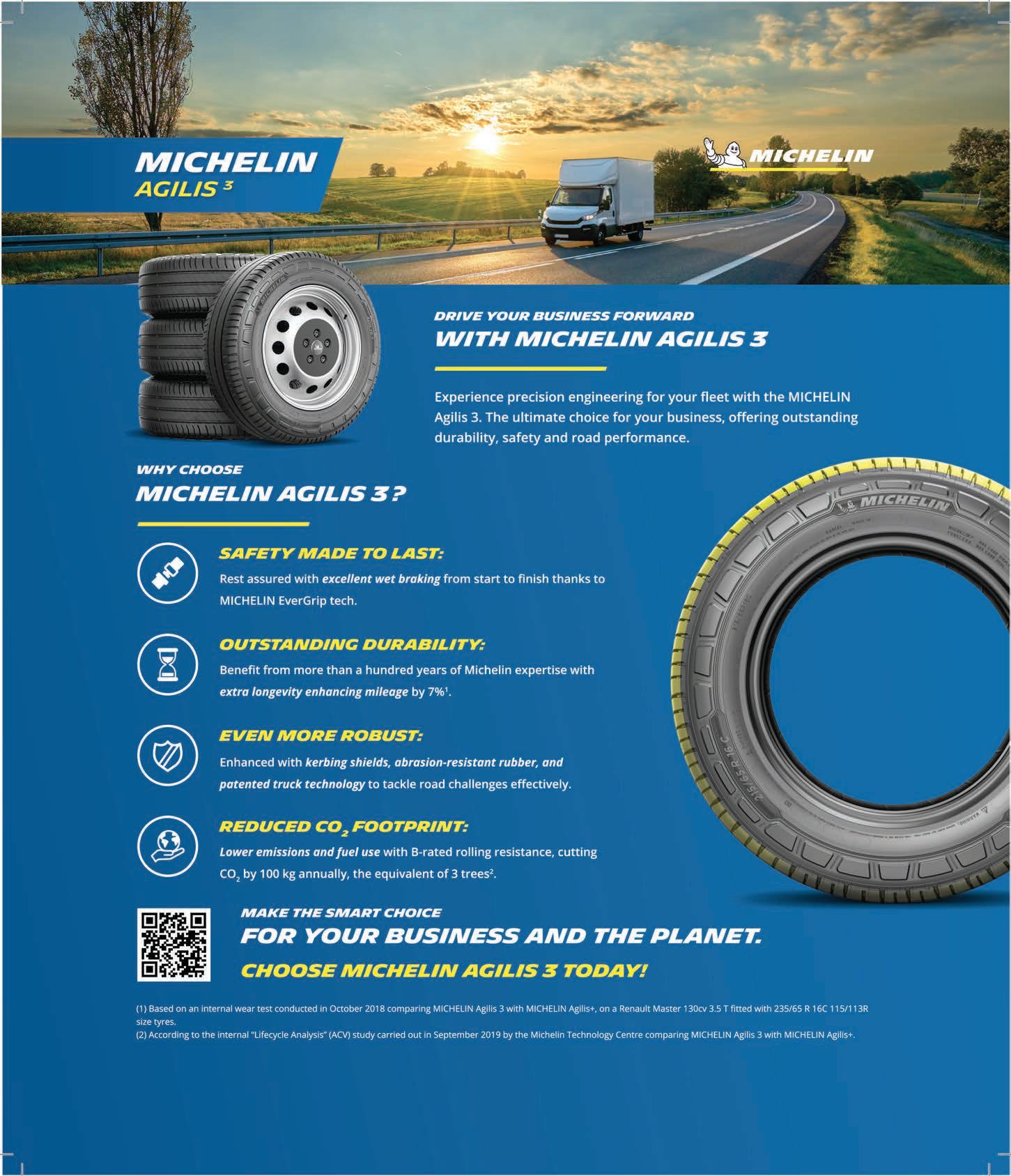



THE RIGHT APPROACH AND PLATFORM ARE ESSENTIAL
Unpacking the benefits of Ctrack’s Comprehensive Crystal Platform for optimal supply chain efficiency
In the rapidly evolving landscape of supply chain management, achieving operational excellence demands not just innovation, but also a comprehensive approach that integrates routing, scheduling, electronic proof of delivery (EPOD) and planning.
Crystal, powered by Ctrack, offers such a solution, revolutionising how businesses navigate the complexities of logistics and delivery operations.
Ctrack, an innovative leader in asset management solutions, leverages advanced technology to provide comprehensive insights and control over fleet operations. Its offerings, designed to enhance efficiency, safety and productivity, cater to a wide range of industries. Ctrack’s solutions integrate real-time monitoring, detailed analytics and operational optimisation, supporting businesses in achieving superior fleet performance and compliance.
THE FOUNDATION OF MODERN LOGISTICS
Crystal’s modular system is the foundation for logistical innovation. It is designed to provide businesses with a scalable, flexible solution that adapts to their evolving needs. Ctrack’s core offering consists of a robust and comprehensive fleet and asset management platform, however, its true power lies in its optional plugin modules, such as routing and scheduling, data analytics and camera/video capabilities. These modules enable businesses to tailor the solution precisely, adding functionalities that enhance operational efficiency, safety and decision-making processes. This modular architecture not only supports businesses
as they grow and evolve, but also ensures they can leverage advanced telematics and sophisticated data analysis tailored to their specific sector needs.
OPTIMISING ROUTES AND SCHEDULES FOR PEAK EFFICIENCY
The routing and scheduling module utilises advanced algorithms to determine the most efficient routes, significantly minimising operational costs and environmental impact. Coupled with real-time execution monitoring, it allows businesses to adapt in real-time to unforeseen challenges, ensuring seamless operations and maintaining the resilience of supply chains.
ENHANCED DELIVERY VERIFICATION
Integrating EPOD adds a crucial layer of efficiency and customer satisfaction to the logistics process. By providing instant, electronic confirmation of deliveries, it streamlines operations and offers real-time verification, thus enhancing the accuracy and reliability of the supply chain. This digital approach reduces paperwork, minimises disputes over delivery discrepancies and accelerates the billing cycle, leading to improved cash flow. Furthermore, EPOD facilitates a transparent communication channel between drivers, dispatchers and customers, improving service levels and fostering trust through visible accountability and traceability in delivery operations.
RETURN ON INVESTMENT
Crystal by Ctrack is a pivotal investment for businesses seeking to maximise their
ACHIEVING OPERATIONAL EXCELLENCE DEMANDS NOT JUST INNOVATION, BUT ALSO A COMPREHENSIVE APPROACH THAT INTEGRATES ROUTING, SCHEDULING, ELECTRONIC PROOF OF DELIVERY AND PLANNING.
EPOD facilitates a transparent communication channel between drivers, dispatchers and customers, improving service levels and fostering trust through visible accountability and traceability
return on investment (ROI) in fleet and asset management. The platform’s ability to provide detailed insights into vehicle performance, driver behaviour and fuel consumption leads to direct savings and optimised resource allocation. This targeted approach to fleet management not only improves safety and compliance, but also contributes to substantial reductions in operational costs, directly impacting the bottom line and delivering a compelling ROI to customers across various sectors.
HARNESSING PREDICTIVE POWER THROUGH DATA
With the integration of Crystal’s advanced solutions, companies are positioned to leverage vast amounts of data for predictive analytics. This capability allows businesses to forecast trends, anticipate market changes and make informed decisions that drive strategic advantage. By harnessing this data-driven insight, companies can proactively address potential challenges and seize opportunities, truly embodying the predictive power within their operations.
A STRATEGIC ASSET FOR THE FUTURE OF SUPPLY CHAIN MANAGEMENT
As businesses navigate the complexities of modern supply chains, the need for innovative, integrated solutions has never been greater. Crystal, with its modular approach and comprehensive suite of features, stands ready to transform supply chain management, driving efficiency, sustainability and growth for businesses around the globe.
SUPPLY CHAIN MANAGEMENT 27 SPONSORED CONTENT: CTRACK
SUSTAINABILITY: THE FOOD SECTOR’S MAGIC BULLET
Food supply chains are much more than logistics and the straightforward satisfying of supply and demand. They are our lifeblood, vital for global food security.
By KEITH BAIN

Marmite may seem like a trite and vaguely irrelevant product in the context of mounting global food insecurity, but it’s a surprisingly emotional issue for many people, as was proven during the mid-pandemic panic when the black, sludgy, vegan sandwich spread ran afoul of shortages.
At one point there was no Marmite. Other times, supermarkets limited the number of jars customers could buy. The freak shortage was a direct result of lockdown. Marmite’s primary ingredient, spent yeast, was suddenly in short supply thanks to the government’s ban on alcohol distribution that curtailed brewing, which produces the yeast as a byproduct.
Shortages continued into 2022, by which stage the “crisis” had attracted international attention. Even The Economist ran a feature on it. When supplies returned to shelves in May 2022,
shoppers clamoured to get their hands on the precious jars.
It wasn’t just the booze ban that interrupted production, though. The 2022 flooding in KwaZulu-Natal prevented yeast supplies getting from SAB’s Prospecton brewery to Pioneer Foods, Marmite’s local manufacturer. Meanwhile, food-grade soda ash, a neutralising agent used in Marmite production, was in short supply because Chinese factories were closed. For a time, we sourced soda ash from Turkey, but a global lag in availability curbed supplies to South Africa.
BY THE TIME RUSSIA INVADED UKRAINE IN FEBRUARY 2022, FOOD PRICES WERE ALREADY IN FLUX THANKS TO THE KNOCK-ON CONSEQUENCES OF THE PANDEMIC AND BECAUSE OF REGIONAL WEATHER EVENTS IMPACTING VARIOUS AGRICULTURAL SECTORS.
FAST FACT
Ukraine and Russia together contribute to almost a third of all wheat exports. In 2021, just over 55 per cent of Ukrainian wheat went to Asia and just under 41 per cent to Africa. Egypt, Indonesia, Bangladesh, Turkey and Yemen are among the world’s biggest importers of wheat.
Significant percentages of global corn and barley exports are also from Ukraine and Russia, which is why the price of these commodities spiked as the war began and presaged a rise in world hunger.
Source: Earth.org
28 SUPPLY CHAIN MANAGEMENT

Marmite is by no means essential, but the outcry surrounding its prolonged absence from supermarkets hints at the complexity of food supply chains and the consequences of even the slightest disruptions.
For those managing the delicate business of ensuring food gets to market, such disruptions can be a real headache. However, analysts believe such headaches are nothing compared to the coming uninterrupted hangover that will befall the global food system if something is not done to shake up the entire industry.
KNOCK-ON EFFECTS
While South African Marmite lovers were sulking in supermarket food aisles, there were far more pressing concerns over food happening elsewhere. By the time Russia invaded Ukraine in February 2022, food prices were already in flux thanks to the knock-on consequences of the pandemic and because of regional weather events impacting various agricultural sectors.
Russia’s invasion not only threatened a sovereign nation, but also destabilised one of the world’s six breadbasket regions. Ukraine and Russia jointly produce roughly 28 per cent of all wheat and 15 per cent of corn exported globally, reports research firm McKinsey.
As a consequence of a blockade imposed by Russia as the war began, some 20 million tonnes of grain was stuck in Black Sea ports for several months. It took substantial diplomacy and political wrangling to sign a July 2022 deal to allow the release of those commodities.
In a paper on the impact of the Black Sea port blockade, McKinsey reports that the war in Ukraine is indicative of “how local catastrophe can have global consequences”, and that to prevent disaster in the future, unprecedented rewiring of the global food system is required. “While thinking about how to mitigate the current crisis, stakeholders should plan for how to avoid the next one,” says the report. “Both governments and players in the food agriculture value chain need to improve how they manage supply-demand shocks. Resilience in the face of the multiple risks we face is essential, particularly in an era when climate change is provoking more extreme events.”
A major concern is that food system disruptions aren’t only coming from bad actors who can ultimately be brought around the table to negotiate. They are coming from the planet itself.
Compounded climate-related disasters are having sustained and recurring impacts on food availability. From widespread floods in China in 2021 and escalating numbers of droughts and wildfires that have decimated farmlands and diminished water supplies required for irrigation to heatwaves in India and an extremely dry summer across Western Europe, climate change is making its impact felt.
BUILDING RESILIENCE THROUGH INNOVATION
Many believe that as these events have offered a glimpse at the coming food emergency, the entire farm-to-fork circuit needs to be redesigned with new relationships forged
“SUPPLY CHAINS NEED TO PAY GREATER ATTENTION TO THE MEANS OF PRODUCTION AND BETTER UNDERSTAND THE IMPACT OF PRODUCTS AND THEIR COST TO THE ENVIRONMENT.” – ANNE-MARIE BUTLER
FAST FACT
Following Russia’s invasion of Ukraine in March 2022, wheat prices increased by 21 per cent, while barley went up 33 per cent. Given the war’s timing, while the world still reeled from the pandemic, the United Nations warned that an additional 7.6 to 13.1 million people would likely be impacted by hunger as the war persisted.
Source: The New York Times
with suppliers and retailers and at every step along the supply chain. To build resilience, say experts, the trick is to create food and distribute it without further straining the planet.
Experiments across supply chains are underway, from new farming technologies and production methods that are less energy-consuming and harmful to the soil to distribution strategies that use artificial intelligence or innovative packaging to increase shelf life and reduce energy used during transportation.
Food scientist Anne-Marie Butler is global director of strategy and innovation at Edlong, a trailblazing food flavour company. She believes that across the entire food supply chain a “coalition of the willing” must drive the industry’s transition towards sustainability. Failing that, she says, there will be no food industry left.
“If you are in this industry, you need to be willing to be the biggest driving factor of change. If sustainability is going to be adopted properly
How local catastrophe can have global consequences.

SUPPLY CHAIN MANAGEMENT 29 FOOD AND BEVERAGE
MCKINSE Y REPORT

across the whole food industry, it’s going to require collaboration. Sustainability has to involve every part of the food system, from production through to governance.”
Butler says it’s about supporting businesses
transportation costs. Even making products that retain flavour better so they’re viable for longer, resulting in less wastage, or making more durable products that require less packaging during shipping and are better for consumers.”

SUSTAINABILITY THROUGH PARTNERSHIPS
While technologies are emerging to give supply chains an edge, it is generally agreed that supply chain businesses can impact how food is produced by vertically integrating backwards into agricultural production.
As supply chains work more closely with contracted farmers, experts believe they can and should leverage these partnerships to insist on more sustainable agricultural practices. Supply chain companies should be supporting organic farming and regenerative agriculture to enhance soil health, conserve water resources and mitigate climate change impacts.
Kayhan Atalay, marketing head of Anglo American Crop Nutrients, which is in the business of developing alternative fertilisers that enrich the soil rather than depleting it, believes that companies “should be collaborating to encourage farmers to use more sustainable products”. He says more can be done at the leadership level to push back down the supply chain. “It’s about collaboration, partnering with the right people downstream throughout the supply chain, from farm to supermarket shelf, who share
BACK TO BASICS
LA Farms is an organic, sustainable, nonpolluting food company producing what many of its fans consider the best meat in the country, raised on a healthy diet on the Cape West Coast. Harun Moreira, the company’s MD, believes farming can – and should – be done differently.
This is why the entire operation showcases sustainable methodologies that start with caring for the soil, eliminating chemicals from any part of the food chain and growing flour that is not genetically modified and high-protein feed for the animals. It also operates a tight farm-to-table supply chain, all in-house. Many customers who buy meats and other niche food products from its Green Point deli-cum-restaurant or its other handpicked outlets report that they heard talk of the LA Farms brand overseas – as far away as Canada.
Alongside its in-house products, LA Farms collaborates with a limited number of similarly eco-conscious food artisans who are principally connected by their focus on sustainability. By bringing these small-scale producers together, Moreira says LA Farms is achieving a sustainable business model, small but viable.
Keeping it within the operation’s control eliminates “middle-man” costs, Moreira says, and reduces risks. It’s a tougher approach and keeps him on his toes, but enables the brand to maintain its integrity. Moreira believes this way of localising, personalising and shortening supply chains is one way of restructuring food systems, restoring them to health by going back to basics – and being pedantic about every step of the supply process.
the same sustainability goals and convey the same message to the farmers.”
That message is simple: to ensure food security on a rapidly changing planet, every inch of the food supply chain must build resilience by adopting more sustainable practices.
“IT’S ABOUT COLLABORATION, PARTNERING WITH THE RIGHT PEOPLE DOWNSTREAM THROUGHOUT THE SUPPLY CHAIN, FROM FARM TO SUPERMARKET SHELF, WHO SHARE THE SAME SUSTAINABILITY GOALS AND CONVEY THE SAME MESSAGE TO THE FARMERS.” – KAYHAN ATALAY
FOOD AND BEVERAGE 30 SUPPLY CHAIN MANAGEMENT
IMAGES: DARKSITE/ISTOCKPHOTO.COM, METAMORWORKS/ISTOCKPHOTO.COM, JACOB WACKERHAUSEN/ISTOCKPHOTO.COM
THE QUEST FOR SUSTAINABLE MULTITEMPERATURE SUPPLY CHAINS
Embracing eco-friendly practices within a perishables distribution network requires trade-offs between multiple conflicting objectives, including customer order fill requirements, minimising transportation costs and limiting environmental impact.
By RENIER DU PREEZ , CEO of Digistics
Optimising sustainability in perishable food distribution is particularly challenging, primarily because of temperature control requirements. Temperature is a significant determinant of the shelf life of a perishable product, and any deviations from the required temperature range will accelerate the growth rate of micro-organisms responsible for quality degradation, significantly reducing product shelf life and increasing food safety risks.
A refrigerated vehicle’s cargo is well-insulated, but the load experiences frequent exposure to increased temperature when the vehicle stops to make deliveries. Between 10 and 25 per cent of perishable food is estimated to be lost during distribution, so most companies avoid co-loading perishables with ambient goods on a delivery vehicle.
In this article, we explore the challenges climate change poses in the logistics sector, focusing on supplying multitemperature goods in a single delivery, considering whether or not this approach improves sustainability and identifying recent innovations in this field.
THE CLIMATE CONUNDRUM: UNRAVELLING EXTREMES
Climate change is leading to extreme weather events such as unrelenting cold spells and scorching heat waves. The logistics sector faces the daunting task of adapting to these severe weather conditions and maintaining the delicate balance of product temperatures to ensure food safety, quality and shelf life.
Considering energy use and cost, delivering multiple orders on a single full vehicle is more efficient than delivering each order on its own dedicated vehicle. To address this challenge, the idea of transporting multitemperature
goods in the same delivery has emerged as a promising solution if done right. A full vehicle load, however, increases order transit times and the frequency of temperature abuse during unloading, which can reduce product quality and increase food waste. Combining various temperature-sensitive products into one shipment minimises the logistical footprint, reduces the environmental impact and optimises resources. However, this approach comes with its own set of challenges.
• Temperature variability: climate change exacerbates temperature fluctuations during delivery, making maintaining consistent conditions for goods with varying temperature requirements in a single shipment challenging.
• Energy consumption: traditional refrigeration methods contribute to elevated energy consumption, further intensifying the ecological footprint of logistics operations.
• Waste reduction: the risk of product spoilage due to temperature inconsistencies raises concerns about food waste.
• Supply chain complexity: co-ordinating the movement of multitemperature goods adds complexity to supply chain management, requiring precise planning and execution.
EMBRACING ECO-FRIENDLY PRACTICES
Innovations in refrigerated vehicles equipped with dedicated temperature compartments and temperature tracking per compartment make it possible to transport goods with varying temperature requirements simultaneously, ensuring that each product’s integrity is preserved throughout the distribution process. Solar-powered and tri-axle battery-charging solutions herald a new era of eco-friendly
SOLAR-POWERED AND TRI-AXLE BATTERY-CHARGING SOLUTIONS HERALD A NEW ERA OF ECO-FRIENDLY LOGISTICS, REDUCING RELIANCE ON TRADITIONAL FUEL SOURCES.
logistics, reducing reliance on traditional fuel sources and contributing to both cost efficiency and environmental stewardship.
Supplying multitemperature goods in the same delivery presents an opportunity to enhance supply chain sustainability.
Critical avenues for achieving greater sustainability include:
• Innovative packaging solutions: developing advanced, eco-friendly packaging materials helps maintain temperature stability while minimising environmental impact.
• R enewable energy integration: embracing renewable energy sources, such as solar and wind, for refrigeration and storage facilities contributes to a more sustainable and resilient supply chain.
• D ata-driven decision-making: leveraging data analytics and internet of things technologies enables real-time monitoring of temperature-sensitive shipments, allowing proactive interventions to maintain product quality.
• Multitemperature control vehicle design: companies are investing in innovative vehicle designs that allow for precise temperature control within the same transport unit, ensuring the integrity of diverse products.
• Solar- and axle-powered transportation: integrating solar panels or using the energy from the vehicle allows companies to harness renewable energy options, reducing reliance on traditional fuel sources and minimising the carbon footprint of logistics operations.
• Advanced refrigeration technologies: adopting state-of-the-art refrigeration technologies, such as magnetic cooling and cryogenic systems, enhances energy efficiency and minimises environmental impact.
The challenges posed by climate change are being met with resilience and innovation.
Supplying multitemperature goods in the same delivery is emerging as a response to climate extremes and a sustainable approach to logistics. Innovations in refrigerated-controlled vehicles, solar-powered logistics and advanced refrigeration technologies are helping to optimise logistics operations for greater sustainability and environmental responsibility.
SUPPLY CHAIN MANAGEMENT 31 PERISHABLES
RE VOLUTIONISING LOGISTICS THROUGH SUSTAINABILITY AND INNOVATION
A deep dive into DIGISTICS’ eco-responsible practices
The urgency of sustainable supply chain solutions cannot be overstated as businesses strive to strike a delicate equilibrium between economic considerations, geopolitical factors and the evolving challenges of climate change and natural disasters. In an era where the impacts of these interconnected elements reverberate globally adopting sustainable practices in the supply chain is a prerequisite for long-term success.
Achieving this involves a fundamental shift towards environmentally responsible strategies, circular economy principles and resilient frameworks that can withstand geopolitical uncertainties. The imperative lies not only in meeting current demands, but also in ensuring the viability of supply chain operations for future generations. This urgency underscores the need for businesses to proactively embrace sustainability, mitigate risks, enhance resilience and contribute to a more stable and ethical global business landscape.
Driven by an unwavering commitment to environmental stewardship, Digistics, a subsidiary of Supergroup, has been entrusted by global leaders in the quick-service restaurant (QSR) sector to manage their logistical execution for over 20 years. Digistics became a subsidiary of Super Group Holdings in 2012 and is now one of seventeen divisions within the Supply Chain Division.
Super Group is a broad-based supply chain management business listed on the Johannesburg Securities Exchange. The Supply Chain Division provides a platform for the group’s core expertise and offerings, which includes vertically integrated divisions covering vehicle dealerships and fleet management. The company co-ordinates and collaborates with its valued channel partners, including suppliers, intermediaries, third-party service providers and customers, to integrate supply and demand management within and across companies.

THE COMPANY AIMS TO ACHIE VE DELIVERY EXCELLENCE BY OFFERING COMPREHENSIVE END-TO-END SUPPLY CHAIN SOLUTIONS THAT EMPOWER AND ALIGN WITH ITS CUST OMERS’ STR ATEGIES.
B EYON D LO GISTICS, A LO GISTICAL PA R TNE R
At the core of Digistics’ philosophy is a profound understanding that its success is tied to the success of its customers. Rather than viewing customers as external entities, Digistics regards them as the very essence of its existence and therefore focuses on best-in-class execution that enables its customers’ strategies. This customer-centric approach is not only confined to the mere procurement and movement of products, but also extends far beyond, encompassing the delivery of intelligent insights through collaborative efforts.
Digistics positions itself as more than just a logistics company; it aspires to be a strategic partner in its customers’ journeys. Guided by a clear vision, the company aims to achieve delivery excellence by offering comprehensive end-to-end supply chain solutions that empower and align with its customers’ strategies. This vision is complemented by a mission deeply rooted in sustainability, emphasising service and quality
while nurturing enduring relationships that provide customers with a distinct competitive advantage.
Digistics’ dedicated workforce and expansive network serve as the bedrock for delivering high-quality logistics services and upholding the principles of sustainability, creating a symbiotic relationship with customers across multiple stakeholders.
EMPOW ER ING EXCELLENCE BY IN V ESTING IN PE O PLE
Digistics places paramount emphasis on investing in its people, recognising them as the driving force behind the company’s success. The commitment to the professional and personal development of its workforce is evident in Digistics’ extensive training programmes and initiatives.
By providing opportunities for skill enhancement, career growth and continuous learning, Digistics ensures that its employees are equipped with the knowledge and expertise
32 SUPPLY CHAIN MANAGEMENT ADVERTORIAL DIGISTICS
Drivers Prudence Buthelezi and Matimba Makhubela get ready for the day ahead.

necessary to excel in the dynamic logistics industry. The company fosters a culture that values each individual’s contribution, understanding that a motivated and skilled workforce is key to delivering exceptional service. Digistics not only invests in the technical skills required for logistics, but also prioritises the wellbeing and job satisfaction of its employees.
This investment in people goes beyond conventional practices, reflecting Digistics’ dedication to building a cohesive and empowered team that can navigate the challenges of the industry with resilience and innovation.
FOUNDATIONS OF SUSTAINABILITY
At the heart of Digistics’ operational ethos lies a robust commitment to sustainability with foundations deeply embedded in conscientious and eco-friendly practices. Operating out of seven strategically positioned distribution centres across major South African cities, Digistics has become a significant player in leading multitemperature distribution operations throughout the country.
The company’s belief in being a part of the future is reflected in its fundamental commitment to playing a role in creating a sustainable future. Each distribution centre operates with an environmental scorecard, meticulously tracking material recycling, energy and fuel consumption and landfill contributions. This commitment extends beyond compliance, as all distribution centres are actively working towards ISO 14001 certification, an internationally recognised benchmark for sustainability.
At the core of Digistics’ success is its unique multitemperature control management across the organisation, allowing Digistics to
manage food distribution within the required temperature zones to the customer’s back door. This innovative approach minimises operational disruptions and showcases Digistics’ dedication to reducing its logistical and environmental footprint.
Digistics’ focus on sustainability is not just a corporate strategy, but also a foundational principle shaping its identity and contributing to a more eco-conscious and responsible logistics industry. The focus is on finding innovative, ecofriendly solutions to address pollution and the cost challenges of today.
A lot of energy is lost when vehicles are on the road, but this energy can be harvested to keep their loads at optimum temperature. Digistics has partnered with Thermo King and will introduce AxlePower technology trailers into the QSR market, turning lost energy into a power source for trailer refrigeration. Thermo King developed this new technology in partnership with BPW. The AxlePower trailer integrates seamlessly into the existing fleet, delivering low-noise, high-powered performance in hybrid and fully electric-powered units. The system’s electric operation results in lower maintenance costs and fuel consumption. Additionally, the system also increases the fleet’s flexibility, allowing for late-night deliveries within residential areas. All of this makes AxlePower a flexible power source and an affordable and sustainable option that reduces environmental impact.
A HOLISTIC APPROACH TO SUPPLY CHAIN SOLUTIONS
Digistics stands as a versatile supply chain solutions provider, offering a comprehensive range of services that go beyond conventional
THE COMPANY PLAYS A PIVOTAL ROLE IN MANAGING THE COMPLEXITIES OF IMPORTS AND EXPORTS. NAVIGATING INTERNATIONAL BORDERS, DIGISTICS ENSURES THE SEAMLESS FLOW OF GOODS ACROSS TERRITORIES.
logistics. The company facilitates primary storage solutions, efficient distribution and import and export management with the flow of information that seamlessly integrates across all stakeholders to position itself as a strategic partner for businesses seeking a holistic approach to their supply chain needs.
In the realm of storage, distribution centres can serve as vital hubs for primary storage, ensuring the streamlined handling and management of a diverse array of products, from manufacturing to the end customer. Digistics goes a step further by excelling in multitemperature warehousing and transportation solutions. This distinctive capability allows the simultaneous storage of temperature-specific products within a single facility, showcasing the company’s dedication to both operational efficiency and environmental sustainability.
Digistics proves its prowess in distribution through its expansive fleet and logistical acumen, guaranteeing timely and reliable deliveries. The national fleet, comprising about 360 vehicles, reflects Digistics’ commitment to excellence and innovation in meeting the varied transportation needs of its clients.
The company plays a pivotal role in managing the complexities of imports and exports. Navigating international borders, Digistics ensures the seamless flow of goods across territories. With a sharp focus on compliance, efficiency and sustainability, Digistics facilitates the smooth transition of products between nations, adding significant value to its clients’ global operations. All movement of goods is managed through its control tower, with local execution through mini control towers to ensure excellence in execution across the whole supply chain network.
Digistics doesn’t merely offer logistics services; it provides comprehensive integrated supply chain solutions. By integrating the physical flow of goods across primary and secondary services, efficient distribution and adept management of imports and exports, underlaid with the seamless flow of information across all stakeholders, Digistics emerges as a strategic ally for businesses navigating the intricate landscape of modern logistics.
SUPPLY CHAIN MANAGEMENT 33
ADVERTORIAL DI GIS TICS
Unleashing power: the new fleet of branded vehicles hits the road.
CO MMITMENT BEYON D CO MPLIANCE
Digistics is not merely satisfied with meeting regulatory requirements; it is committed to sustainability at every level of its operations. This dedication establishes a benchmark for the industry, emphasising its crucial role in a world increasingly conscious of the environment. By prioritising sustainability, Digistics not only adheres to regulations, but also offers its customers a substantial competitive advantage, showcasing its dedication to responsible business practices.
Through transformative initiatives, Digistics exemplifies the power of sustainability in driving positive change within the logistics industry and beyond. The company’s ongoing commitment to innovation and sustainability ensures its relevance in a rapidly changing market, contributing significantly to a greener tomorrow. • Innovations in waste management. Digistics stands out for its operational excellence and proactive approach to reducing environmental impact. A prime example is the company’s initiative to convert biodegradable waste, such as cooking oil, into biodiesel. This forward-thinking strategy aligns seamlessly with principles of environmental stewardship and contributes to the circular economy, showcasing Digistics’ dedication to responsible and sustainable practices.
• Embracing renewable energy. In a strategic move to fortify its commitment to sustainability, Digistics invests in renewable energy technologies. Ventures into solar and battery storage solutions reduce the company’s carbon footprint and position it as an industry innovator, steering towards a greener future. This proactive approach underscores Digistics’ dedication to reducing reliance on traditional energy sources and embracing eco-friendly alternatives in alignment with the evolving landscape of environmental consciousness.


• Innovations in sustainable transportation. Digistics’ sustainability commitment extends to its transportation fleet, exemplified by the implementation of solar photovoltaic technology on trucks equipped with battery energy storage systems. This initiative demonstrates significant fuel savings, contributing to an overall reduction in fuel consumption and CO 2 emissions. Digistics continues to prioritise finding innovative, eco-friendly solutions to address the challenges of pollution and energy costs in today’s dynamic landscape.
• Harvesting lost energy for sustainability. Recognising the substantial energy loss during road transportation, Digistics has integrated Thermo King’s AxlePower technology into its fleet. Digistics will operate the largest fleet of these trailers in South Africa by April 2024, converting lost energy into a power source for trailer refrigeration. The AxlePower trailer integrates seamslessly into the existing fleet, offering low-noise, high-powered performance in hybrid and fully electricpowered units. This initiative provides a flexible power source and offers an affordable and sustainable option, significantly reducing environmental impact, the business contingency risk and reliance on diesel.
• Battery storage capabilities for a greener future. A noteworthy achievement for Digistics is the successful activation of its battery storage capabilities. This marks a substantial reduction in the company’s reliance on diesel. The battery storage capability ensures a more efficient use of energy, contributing to a greener and more sustainable future. With each kilowatt hour stored, Digistics demonstrates its unwavering commitment to sustainable logistics practices, fostering a greener tomorrow.
CELEBRATING SUCCESSES
Digistics has garnered many notable successes – a testament to its commitment to excellence, innovation and sustainability in the logistics industry. The company’s dedication to environmental stewardship, evident in its landfill and waste scorecard and ISO 14001-certification pursuits, reflects its proactive approach towards sustainability. Digistics’ pioneering initiatives in waste management, such as converting biodegradable waste into biodiesel, showcase its commitment to responsible and sustainable practices. The strategic investments in renewable energy technologies, including solar and battery storage solutions, not only reduce its carbon footprint, but also position Digistics as an industry innovator while reducing business risk.
EACH DISTRIBUTION CENTRE OPER ATES WITH AN ENVIRONMENTAL SCORECARD, METICUL OUSLY TRACKING MATERIAL RECYCLING, ENERGY AND FUEL CONSUMPTION AND LANDFILL CONTRIBUTIONS.
34 SUPPLY CHAIN MANAGEMENT ADVERTORIAL DIGISTICS
Unveiling the new fleet: a testament to Digistics’ commitment to sustainability.
Tshepo Khumalo, a driver, prepares for the day’s work.
The implementation of eco-friendly solutions in its transportation fleet, such as solar photovoltaic technology and Thermo King’s AxlePower, highlights the company’s focus on finding sustainable alternatives in the face of pollution and energy challenges. Achievements, such as the successful activation of battery storage capabilities, continue to demonstrate Digistics’ commitment to greener and more sustainable logistics practices.
COMMUNITY
Digistics is committed to supporting strong communities and various charities, including those of its customers. Communities are the heartbeat of societal wellbeing and their importance cannot be overstated. By offering skilled jobs, prioritising safety and investing in extensive training, Digistics not only strengthens its workforce, but also enriches the communities it touches. The company’s commitment goes beyond providing logistical solutions and extends to fostering a positive impact on society. Whether through charitable initiatives, collaborations with local organisations or creating opportunities for community members, Digistics showcases a dedication to being a responsible corporate citizen. The importance of communities for Digistics is not merely a recognition of their role, but also a commitment to actively contribute to their wellbeing, ensuring a harmonious relationship between the company and the communities it serves.

AN INDUSTRY LEADER
Digistics emerges as a leader in the logistics industry, seamlessly blending economic viability with environmental responsibility. Digistics has integrated sustainability into its core operations and set new standards for the industry. The company’s commitment to excellence, innovation, technological advancement and sustainability is evident in its multifaceted approach, from multitemperature warehousing and distribution to cutting-edge initiatives in waste management and renewable energy.

By going beyond regulatory compliance, Digistics has positioned itself as a strategic partner for businesses navigating the complex landscape of modern logistics. Celebrating successes in environmental stewardship and community engagement, Digistics stands as a testament to the transformative power of sustainability in shaping the future of the logistics industry. With each innovation and milestone, Digistics reinforces its dedication to a greener tomorrow, solidifying its role as a pioneering force driving positive change within the industry and beyond.



SUPPLY CHAIN MANAGEMENT 35
For more information: 011 663 3500 information@digistics.co.za www.digistics.co.za Scan this QR code to go directly to the Digistics website
DIGISTICS
Harnessing the power of the sun with the solar photovoltaic truck rooftop.
ADVERTORIAL DIGISTICS
Embracing the future with Digistics: graduates of the Digistics’ Learnership programme celebrate.
Images: Supplied

THE DATA-DRIVEN SUPPLY CHAIN
Accurate data is essential to efficient supply chain management, but how do organisations corral and prioritise the increasingly enormous amounts of information generated? By
Data. It’s on everyone’s lips these days. Every organisation is creating, gathering, corralling, processing and analysing data in increasingly mind-boggling quantities. Statista estimates that 120 zettabytes (1 trillion gigabytes) of data was created in 2023, with that figure set to rise to 147 this year.
Supply chains are doing their bit to fill up our storage. Objects moving through the supply chain generate data, including information about origin, raw materials used, manufacturing process and conditions, warehousing, end user and expiry date. This growth of internet of things devices means this is only set to multiply exponentially, with increasingly detailed information offering a granular view of items and their journey. Analysed smartly and displayed clearly, it offers businesses insights into supply
ANTHONY SHARPE
issues, bottlenecks and areas for improvement and ultimately enables predictive analytics, working out potential problems before they happen to build a more resilient supply chain.
FILL, CLEAN, ANALYSE
Businesses are inherently interested in maximising profits and reducing costs. An efficient, accurate supply chain is key to that, and key to creating this is accurate data, says Jacques du Preez, CEO of Intellinexus Group. “Accuracy is key. You need to ensure your master data and your customer data are
FAST FACT
Supply chain visibility was the top priority for supply chain leaders when it came to digitisation in 2021, but that fell to fourth place in 2022, behind demand planning, supply planning and inventory optimisation.
Source: McKinsey
correct, and you need to keep track of every step in the process, every transaction and movement from A to B. With accurate data, you can do analysis to identify the bottlenecks in your supply chain process.”
Du Preez says the sheer volume of data being created today makes accuracy even more crucial. “You can’t just pop it into a spreadsheet and analyse it. When dealing with artificial intelligence and machine learning, if you feed robots bad data, there is no way you’ll get an accurate view of where you should optimise things.”
Petrus Gerber, GM of Bidvest International Logistics, believes that the volume of data is not so much a concern, but when you’re
“ACCURACY IS KEY. YOU NEED TO ENSURE YOUR MASTER DATA AND YOUR CUSTOMER DATA ARE CORRECT, AND YOU NEED TO KEEP TRACK OF EVERY STEP IN THE PROCESS, EVERY TRANSACTION AND MOVEMENT FROM A TO B.” – JACQUES DU PREEZ
36 SUPPLY CHAIN MANAGEMENT
“IT’S AS MUCH ABOUT ENSURING THAT YOUR DATA IS MAINTAINED IN A SAFE ENVIRONMENT AND YOUR SYSTEMS AREN’T HACKED AS IT IS ABOUT HOW YOUR STAFF INTERACT WITH THAT DATA.” – PETRUS GERBER
pulling that data from a multitude of sources, things can get challenging. “If you pull data from a warehouse management system and a transport management system, say from two different service providers, then the data isn’t necessarily going to be formatted or presented the same way. This necessitates scrubbing the data to get it aligned and representative of the overall supply chain so you can work with it.”
By way of example, Gerber says that the client who appoints the logistics service provider will know to whom they’re selling and in what volumes, but may not necessarily have their customers’ physical addresses. The warehouse will know storage volumes, turnaround times and transport name, but not necessarily the end client name, while the transporter should have the end client name and address. “So, it’s a matter of cleaning up the data and filling in the blanks to get an overall picture of the supply chain.”
Gerber says logistics providers will appoint data scientists to assist with this process and then, once they have meaningful data, they can begin to make decisions based on that or incorporate it into solutions to present to the client.
It’s all well and good to collect, clean, analyse and draw insights from data, but you also need to present those insights in a clear and digestible manner. Du Preez says that complex insights need to be converted into a format that the C-suite can readily understand, with an appropriate visualisation for that information. “That’s where data storytelling becomes important. There’s a story behind a report or dashboard, how you systematically look at elements or the relationship between them.”
PICK AND CHOOSE
With the vast quantities of data generated it doesn’t make sense to store and try to analyse it all. “We used to see a lot of unnecessary data being collected, but nowadays that is addressed by a clearly defined data strategy,” says du Preez. This starts at the top, as business strategy defines data strategy, which, in turn, defines data governance, with feedback between the three being essential. “It’s these strategies that help you start to define what is important in terms of data.”
For the data strategy to support the business strategy properly, there needs to be
communication and collaboration between the chief executive officer (CEO) and chief information officer. He explains that while historically there was a disconnect here, the growing conversation around data-driven organisations has driven greater alignment between these functions.
Du Preez adds that IT needs to be empowered to build the infrastructure it deems necessary to support the business case. “We recently held a breakaway session with a large group of chief data officers (CDOs). A key complaint was that while a lot of responsibility was placed on them to manage data effectively, they didn’t have the budget to execute these responsibilities as the purse strings were held by CEOs or chief financial officers.” The position is still a relatively new one, however, and he believes that as the C-suite begins to recognise its importance, it will empower CDOs with the finances to deliver on their responsibilities.
KEEP IT SAFE
More quantities and sources of data, unfortunately, also mean more vulnerabilities. With supply chains becoming ever more complex, organisations face the challenge of keeping their data secure through every step.
Cybercrime is on the rise, having caused roughly R152-trillion in damages last year alone,
CUTTING-EDGE TECH
A 2021 survey of supply chain companies found that cloud computing and storage was the most-adopted technology, with 40 per cent already using it, and that figure expected to grow to 86 per cent by 2026. This was followed by sensors and automatic identification (31 per cent, expected to rise to 84 per cent) and inventory and network optimisation tools (28 per cent, expected to rise to 87 per cent).
Source: Statista
according to Statista. Gerber says it’s not just cybercrime that’s of concern, however. “If we’re handling high-value cargo and this becomes known to the public, that vehicle immediately becomes a target. So, it’s as much about ensuring that your data is maintained in a safe environment and your systems aren’t hacked as it is about how your staff interact with that data. You need to segregate information so only the right people in the right place get what they need.”
While he advocates security, du Preez cautions against governing your data to death, as locking it down too much can make it difficult to use. He uses the term “freedom fortress” to refer to a situation where data is free to use among those who need it, but its boundaries are fortified. “If you lock your data down completely, you might as well put it in a box and bury it underground.”

SUPPLY CHAIN MANAGEMENT 37 DATA
IMAGES: RIDOFRANZ/ISTOCKPHOTO.COM, IPOPBA/ISTOCKPHOTO.COM





EFFICIENCY AND SAFETY THROUGH DATA MANAGEMENT







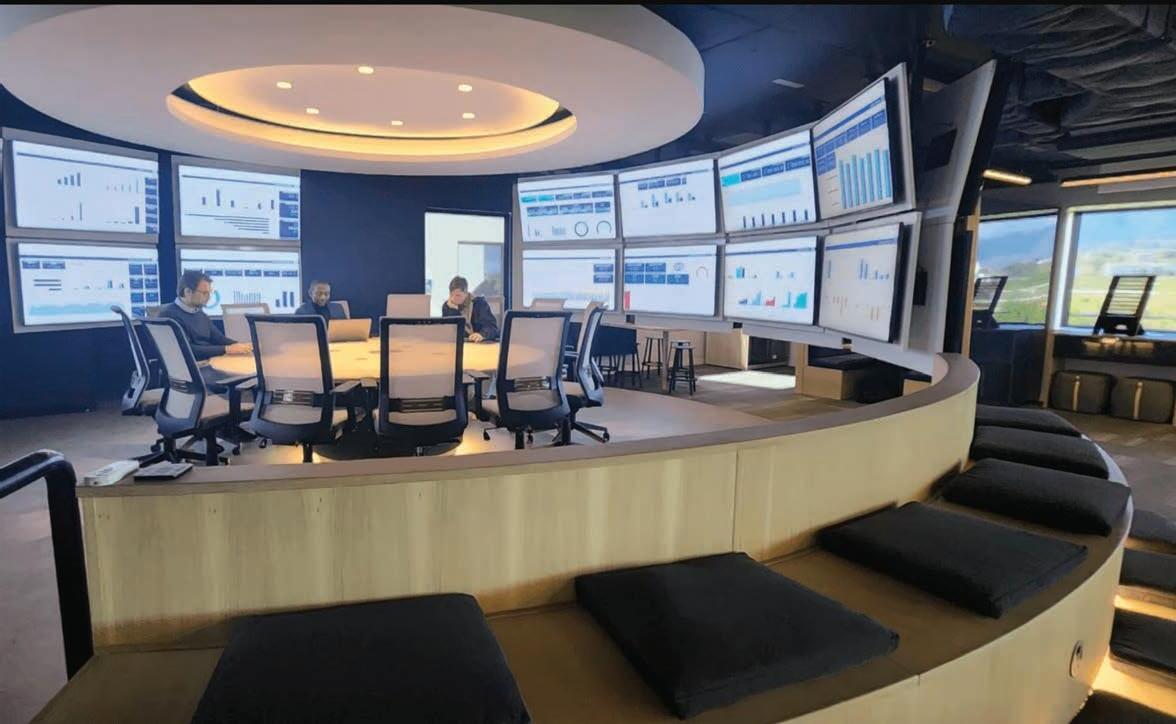
Transport operators frequently encounter risks in the challenging Southern African environment, ranging from unpredictable weather conditions to infrastructural challenges and security concerns, and are increasingly turning to collaboration and technology as critical pillars of their strategy to address these issues, writes
JACQUES GREEFF
, digital and solutions executive at Unitrans
Today’s market demands customised experiences while focusing on safety, risk management, operational efficiency and cost-effectiveness. Efficient supply chains hinge on the ability to access real-time data, swift analyses and prompt decision-making.
Freight and logistics services providers, such as Unitrans, are leveraging the power of big data to craft and deliver optimal solutions. By harnessing vast amounts of data, companies can gain deep insights into customer preferences and behaviours. This enables the development of products and services that meet individual needs and preferences, ultimately driving greater satisfaction and loyalty.
EFFECTIVE ADAPTATION
With the speed at which technology is developing, supply chain service providers have seen significant changes over the past decade. One of the key value propositions of big-data management has been the potential to provide real-time visibility and insights across the entire supply chain network. As a result, companies can now make faster, more informed decisions, optimise processes and proactively address issues before they escalate.
This shift towards real-time, data-driven management marks a significant departure from traditional approaches and underscores the transformative power of big data in reshaping the modern supply chain landscape.
Given South Africa’s vast geographical expanse and diverse logistics infrastructure, the ability to collect and analyse data from various sources, such as internet of things devices, sensors and enterprise systems, enables organisations to understand their supply chain activities comprehensively. This visibility, in turn, leads to improved operational performance, better inventory control and the ability to identify and address inefficiencies, ultimately driving cost savings and enhanced competitiveness.
Furthermore, big-data management empowers South African supply chain professionals with
COMPANIES CAN NOW MAKE FASTER, MORE INFORMED DECISIONS, OPTIMISE PROCESSES, AND PROACTIVELY ADDRESS ISSUES BEFORE THEY ESCALATE.
38 SUPPLY CHAIN MANAGEMENT
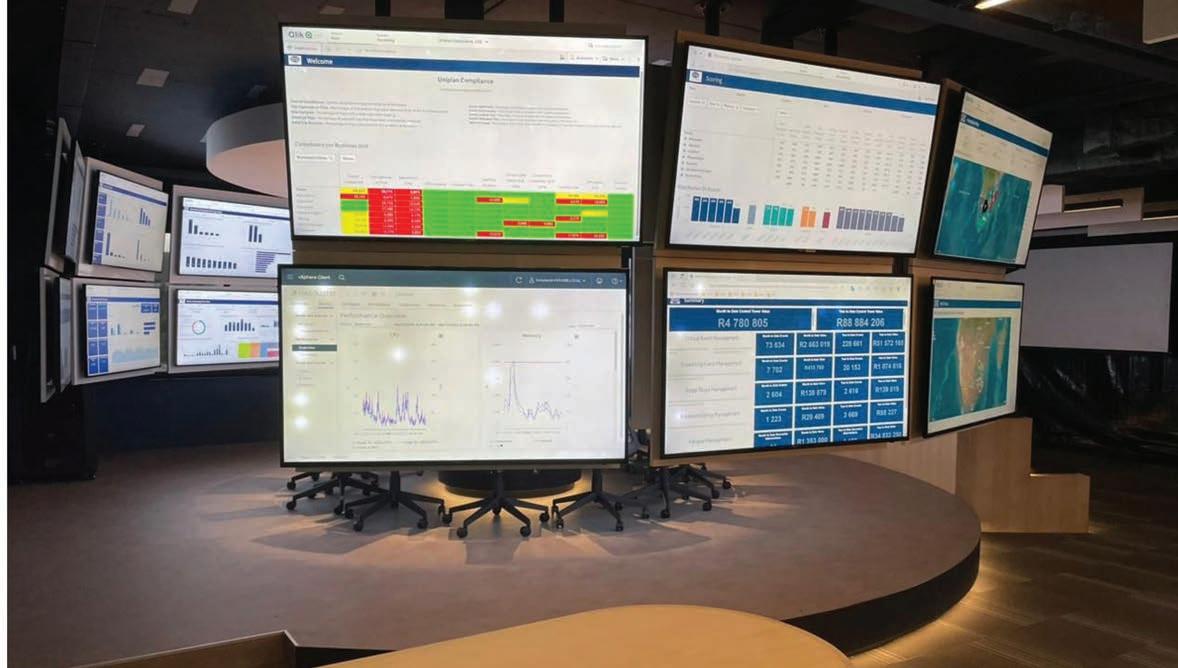
One of the key value propositions of big-data management has been the potential to provide real-time visibility and insights across the entire supply chain network.
advanced analytics and predictive modelling capabilities, allowing them to anticipate demand patterns, optimise routing and transportation and make data-driven decisions.
By leveraging historical data and applying machine learning algorithms, organisations can forecast demand more accurately, reduce stockouts and optimise inventory levels, improving customer satisfaction and reducing carrying costs in the unique South African market context.

SMOOTH OPERATIONS AND AGILITY
Another significant value proposition of big data management in South Africa is its potential to facilitate collaboration and synchronisation across the supply chain ecosystem. Companies can foster closer co-operation, streamline processes and enable more agile responses to market dynamics by sharing relevant data with suppliers, logistics partners and customers. This collaboration also improves response times and reduces lead times, adding value to the more customer-centric supply chain.
Companies operating in this environment therefore require continual evolution and adaptation to ensure optimal efficiency while mitigating risks. As responsible transporters and supply chain service providers, our
commitment must extend beyond the organisation to include accountability to customers, staff and the greater economy.
MOVING FORWARD
Predictive analytics is the next step. Harnessing robotics for information processing will enhance operational efficiency and customer experiences further, while reducing risk. Through cognitive analysis, for example, decision-making processes can be embedded within systems, enabling transactions and operations to proceed autonomously.
Extensive data management and improved collaboration hold tremendous potential for transforming the supply chain landscape in South Africa. As customers strive for higher delivery speed and transparency, it offers a compelling value proposition driving efficiency, resilience, and competitiveness in the country’s complex and diverse logistics environment.
Another significant value proposition of big data management in South Africa is its potential to facilitate collaboration and synchronisation across the supply chain ecosystem.
SUPPLY CHAIN MANAGEMENT 39 DATA
IMAGES: SUPPLIED
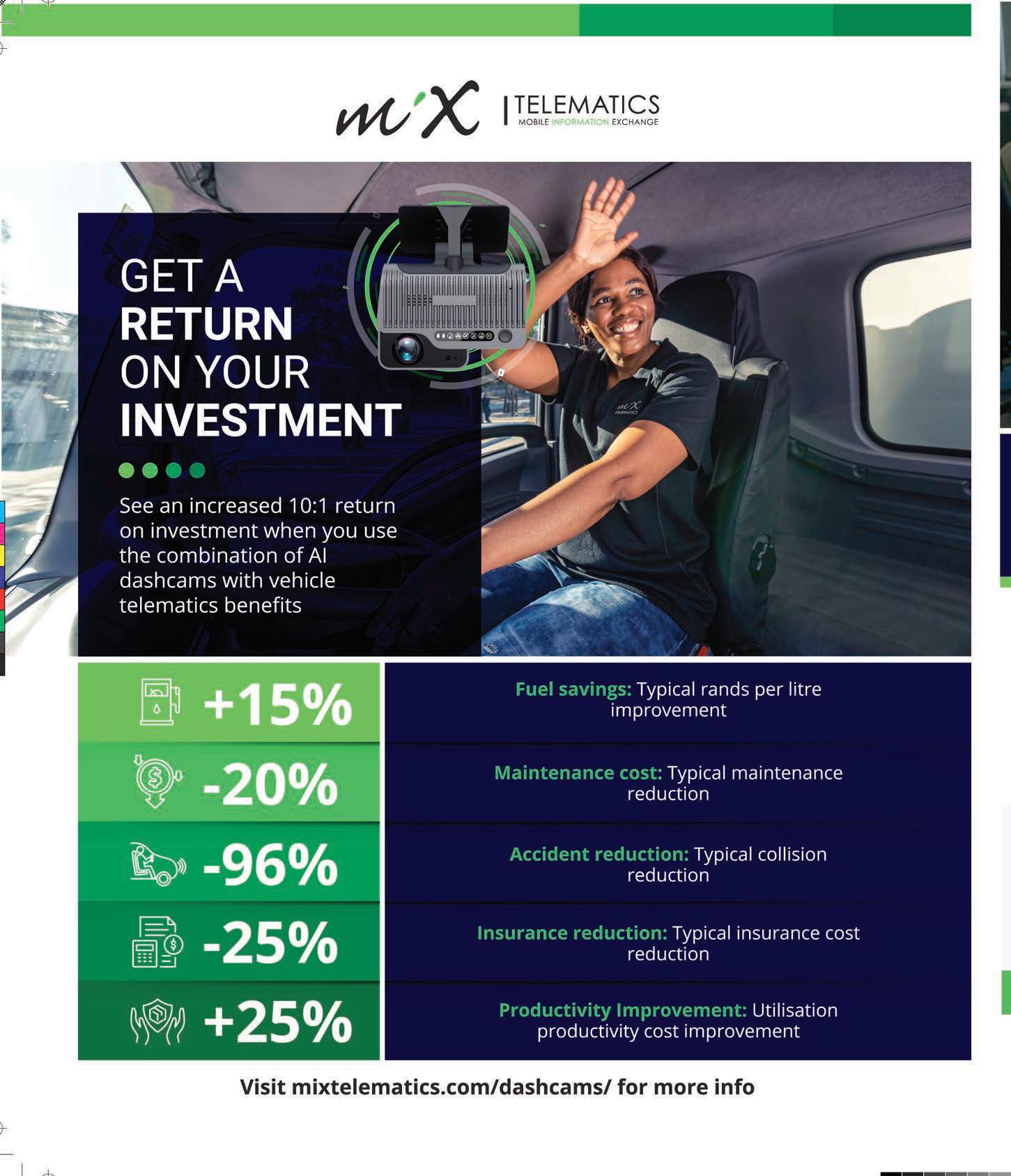

EVERY CLOUD HAS A SILVER LINING FOR SUPPLY CHAIN MANAGEMENT


Moving an organisation’s supply chain management functionality to the cloud offers numerous benefits, but is not without its challenges, as RODNEY WEIDEMANN discovers
The value of digitally transforming and leveraging cloud-based systems for supply chain management has been recognised by logistics providers, to the extent that many today are seeking to consolidate separate offerings into holistic supply chain platforms.
Pieter de Waal, solution advisory specialist for supply chain planning and manufacturing at SAP Africa Region, notes that successful modern companies are leveraging technology as a competitive differentiator to drive innovation and bring greater transparency and visibility over their end-to-end supply chains. “From our perspective, companies can access fully designed supply chain solutions that are integrated into the broader SAP landscape. These use transactional data from the enterprise resource platform – including supply chain planning data, logistics, manufacturing, procurement and financial information – to give companies access to agile and accurate data for real-time decision-making.”
De Waal says these innovations allow companies to automate business processes and generate insights like never before. “The applications are wide-ranging: from master data accuracy alerts and early warning analytics to machine learning deployed in forecasting where external factors are influencing sales.”
CONSOLIDATION CHALLENGES
Steve Orenstein, CEO and founder of Locate2u, suggests that in supply chain management, there remains a lot of legacy technology involved in the process of shipping freight to different locations. This makes it tougher for organisations to shift their supply chain management functions to the cloud. “Moving to the cloud can require rebuilding or reconfiguring of the legacy technology to make it cloud-ready. Nonetheless, we are witnessing increasing cloud adoption, mainly driven by the need to improve the user experience (UX).
“One challenge that shifting to the cloud actually reduces is the security issue, as hacking is often the result of bad actors taking advantage of legacy technologies. The levels of security built into the cloud are significantly improved, meaning your supply chain is more secure once you have undertaken the shift.”
Heinrich de Leeuw, MD of Seidor South Africa, says small and medium enterprises (SMEs) are broadly unable to leverage the benefits of digital supply chain management fully. “SMEs often have inadequate access


FAST FACT
Companies want the capabilities of “business without boundaries”, where they can easily adopt new technologies and capabilities to keep pace with market disruption. The answer is to implement an end-to-end supply chain technology platform that is supported by a single partner and a clear service-level agreement to ensure adequate support throughout their digital transformation effort.
Source: SAP
to the internet and digital infrastructure, they lack funding, have limited access to effective solutions or have a lack of internal technological expertise. Limited government support for digital innovation and a lack of investment in research and development further exacerbate the technology gap.”
De Leeuw says that without sufficient visibility across the extended supply network, companies are unable to see their risks.
“THE LEVELS OF SECURITY BUILT INTO THE CLOUD ARE SIGNIFICANTLY IMPROVED, MEANING YOUR SUPPLY CHAIN IS MORE SECURE ONCE YOU HAVE UNDERTAKEN THE SHIFT.” – STEVE ORENSTEIN
42 SUPPLY CHAIN MANAGEMENT
“COMPANIES THAT DO NOT CHANGE THEIR TECHNOLOGY CAPABILITIES TO A SINGLE, COHERENT PLATFORM WILL FIND IMMENSE DIFFICULTIES, COSTS AND INEFFICIENCIES IN INTEGRATING SUPPLY CHAIN MANAGEMENT TECHNOLOGIES FROM MULTIPLE DIFFERENT PROVIDERS.” – PIETER DE WAAL
“They don’t have the systems to understand the status of their inventory, project stock shortage of direct materials and optimise production or project stock shortages of finished goods to optimise customer allocation. They also lack the logistics flexibility they need to ensure the profitable movement of goods.”
THE BENEFITS OF CONSOLIDATION
It should also be obvious, says de Waal, that companies that do not change their technology capabilities to a single, coherent platform will find immense difficulties, costs and inefficiencies in integrating supply chain management technologies from multiple different providers. “Companies that move from an on-premise to a cloud environment for their supply chain management and broader enterprise resource planning capabilities gain greater speed and a reduction in costs associated with complex integration projects. Real-time data capabilities keep all partners in the supply chain aligned even as conditions change, ensuring the business operates on up-to-date information.
“This brings improvements to planning throughout the supply chain, eases collaboration with supplies – for example, regarding planned deliveries – and helps companies adapt their planning around their own and their supply chain partners’ manufacturing constraints.”
Orenstein points out that Locate2u’s area of expertise is the last mile or the delivery from warehouse to the end customer. “Our system often integrates with an order management system, is designed to help businesses manage their fleet of drivers across multiple locations and allows the user to undertake effective optimisation.
FAST FACT
“Essentially, this means business owners can determine exactly how many drivers are needed, according to the capacity of the deliveries. They can also undertake route optimisation, which saves fuel and provides greater clarity around exactly when it will arrive at the customer, thus allowing the customer to also be more prudent with their time. In the end, optimisation plays a major role in improving the UX.”
THE CLOUD JOURNEY
Ultimately, says Orenstein, UX remains the key. A good supply chain management solution offers customers a range of choices. Thus, it is important to think carefully about what services you offer, such as different speeds of delivery and different delivery times – for example, evenings or weekends. “When it comes to security and compliance, if you are operating in international markets, you will also need to ensure you remain compliant with specific data privacy laws, such as Europe’s General Data Protection Rule.
“Thus, when you choose your supply chain management technology provider, you must clearly understand where your data will be hosted and what infrastructure they are using to ensure that the technology is effective and that they are hosting your information in an appropriate territory,” Orenstein notes.
The journey must, however, start with leadership buy-in and support for a digital culture, and this must be driven from the top down throughout every layer of the organisation, says de Waal. “While many organisations have developed five-year digital transformation plans, my advice is to consider shortening these to three- or five-month plans and also take an approach of ongoing innovation and value generation.
The cloud enables businesses to provide customers with the specific experience they demand and to do so very quickly. This creates a cost-saving opportunity for the business in the form of smarter route planning. This delivers savings in fuel, maintenance costs and in terms of staff – both drivers and back-office employees.
Source: Locate2u
TECHNOLOGY IS THE TREND
Mohammed Akoojee, CEO and MD for sub-Saharan Africa at DP World, notes that one of the most prominent supply chain trends for sub-Saharan Africa in 2024 is “technology as a driver”.
“The digitisation of the supply chain will be an ongoing trend in sub-Saharan Africa, empowering the region to overcome historical infrastructure challenges and ushering in a new era of business. Africa’s growing youth population positions the continent as an ideal market for global players, with e-commerce acting as the catalyst.”
In addition, he adds, artificial intelligence and the internet of things will enable end-to-end visibility for customers and provide businesses with data for predicting disruptions and making insights-driven decisions, including on production and transport capacity.
“Leadership is also critical to shift to fast prototypes, fast failures and fast adjustments while adapting to remote collaboration. Those organisations with the right culture in place have been able to quickly pivot and adjust while continuing to move their organisations into the future.”
As new capabilities are released in the cloud, de Waal adds, companies can deploy them as needed without the need for complex implementation projects. This means that supply chain operations can be scaled and simplified through a unified supply chain landscape with new integrations available as the organisation grows.
“In the past five years, there have certainly been early adopters that have jumped into the cloud and begun using tools like we provide,” says Orenstein, “but we have now reached the point where it’s no longer about deciding to adopt or not, but rather a case of needing to be in the cloud to provide the UX that customers demand.
“Business leaders are now recognising the value of cloud in a supply chain management context, so adoption is really taking off. Ultimately, transitioning to a cloud-based supply chain management system is the answer to making your customers’ businesses run better, delivering a great UX to the end customer, and having the capability to easily integrate new developments into your platform as and when required,” Orenstein concludes.
SUPPLY CHAIN MANAGEMENT 43
TECHNOLOGY
IMAGES: ARTEMISDIANA/ISTOCKPHOTO.COM
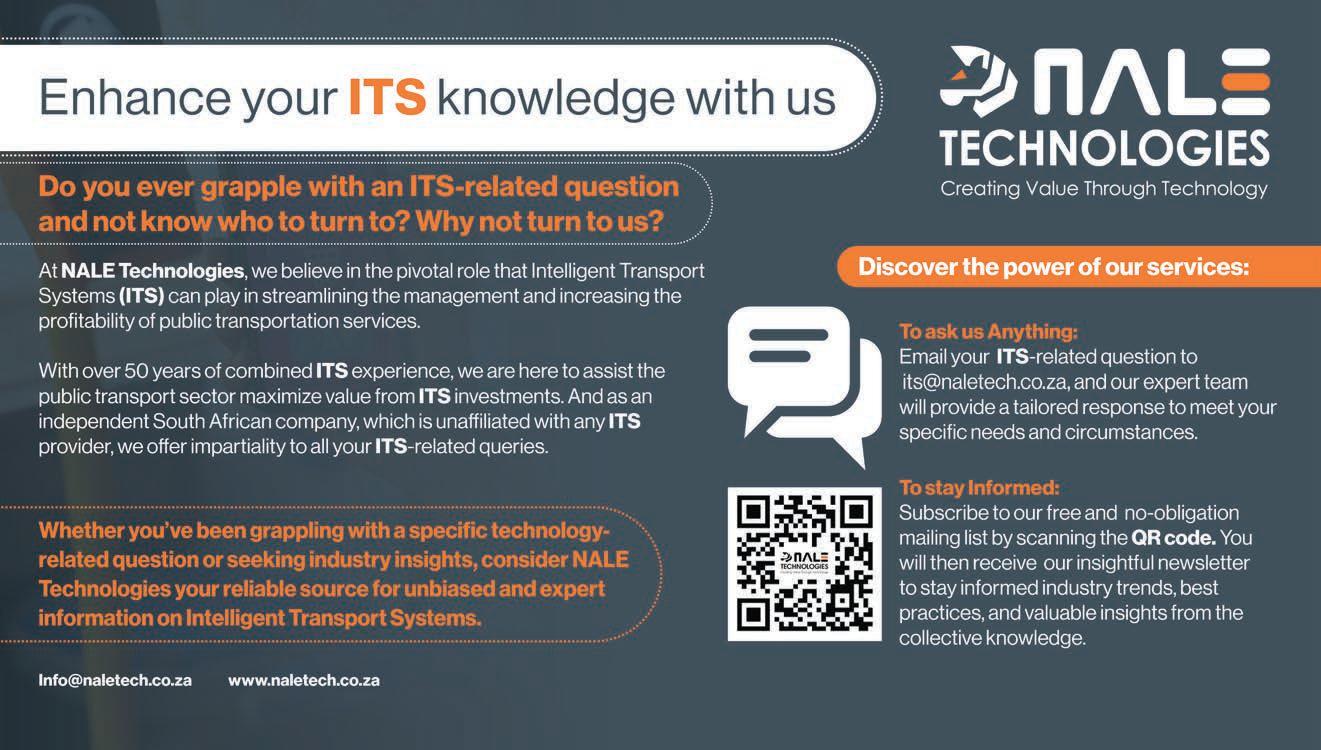

WHERE TECHNOLOGY MEETS COMMON SENSE
Technological advances coupled with good sense can have a range of benefits, writes
ELVIS MUTSEURA , product marketing manager at Iveco Group

Technology is advancing at a fast pace, and the advent and adoption of artificial intelligence (AI) will only accelerate the march of new technology. The potential benefits promised by the new gadgets, gizmos and apps at our disposal are myriad. It is therefore natural that decision-makers in road freight logistics are looking in this direction for a competitive breakthrough.
I argue that one must stay abreast of technological developments while concentrating on combining common sense and existing, mature technology to achieve best-in-class efficiency and effectiveness.
DRIVER AND VEHICLE EFFICIENCY
When drivers understand their vehicles, they realise engines have an operating range at which they run most efficiently. Good drivers will try to keep their engines running in the sweet spot by shifting gears and adjusting speed accordingly: it’s common sense. The trouble is that common sense is not always common
and, at times, must be taught and enforced by someone else. Fortunately, this is where technology can help.
Many new vehicles can be specified to include driver assistance technologies that “do the thinking” for the driver. GPS-enabled predictive powertrain control systems, for example, will “read the road” and autonomously shift gears as required to improve efficiency. That is great for new vehicles, however, the average age of vehicles in South Africa is estimated at 10.5 years and is increasing. Replacing the entire fleet of vehicles on our roads with versions featuring the latest “driver-proof” technologies will take a lot of time and money. Third-party telemetry offers ever-increasing capabilities that can be used to train drivers and entrench good behaviour.
AI is already alive and well in vehicles with wide adoption of systems that, for example, can detect driver fatigue and other forms of distracted driving. In this way, savvy fleet managers can access and use real-time and objective
THIRD-PARTY TELEMETRY OFFERS EVER-INCREASING CAPABILITIES THAT CAN BE USED TO TRAIN DRIVERS AND ENTRENCH GOOD BEHAVIOUR.
information to enforce and reward good driver behaviour and improve safety and efficiency – the ultimate source of competitive advantage.
THE BIG PICTURE
If one shifts focus to the macro, national level, the need to deploy existing technology to cultivate a common sense of road traffic safety and efficiency cannot be understated.
South Africa records more than 12 000 deaths annually due to road crashes. The societal toll of these deaths is very high. The Road Traffic Management Corporation reported that in 2022, the cost of 10 466 fatal crashes amounted to roughly R186.5-billion, equivalent to 3.3 per cent of gross domestic product (GDP). These expenses include lost productivity, medical treatment, clean-up, emergency services, police involvement, funeral costs and infrastructure damage. A significant proportion of those dying on our roads are economically active. The compound effect of the traumatic loss of life on their families and their lost contribution to productive output is beyond even the estimate of 3.3 per cent of GDP (roughly the same contribution as agriculture in South Africa).
South Africa runs a negative trade balance with respect to crude petroleum, meaning that money leaves our shores whenever we fill our fuel tanks. Reducing fuel consumption in general would thus impact the economy.
Autonomous driving and the many technologies piloted globally promise to reduce road fatalities and reduce and/or eliminate the use of fossil fuels. For the more than 12 000 people who die on South African roads annually, this technology will be too late. It will also take a long time to replace the more than 12 million vehicles active on South Africa’s roads. How difficult is it to use existing technology to analyse accident patterns to work out more effective policing? How can policing be used to nurture good driving habits and discipline and how can technology help?
Traffic congestion detection and traffic flow management are innovative applications of existing and mature technology that could be used by road agencies and authorities to avoid and reduce traffic congestion. This would improve the efficiency of the road network and create significant fuel savings, and it will not require a new fleet of vehicles on the road.
In our quest to keep up with the latest technological trends, we need a multifaceted approach that embraces existing technology while being receptive to new advances that can help.
SUPPLY CHAIN MANAGEMENT 45 TRANSPORT
IMAGES: ANDREYPOPOV/ISTOCKPHOTO.COM
THE AI-DRIVEN SUPPLY CHAIN
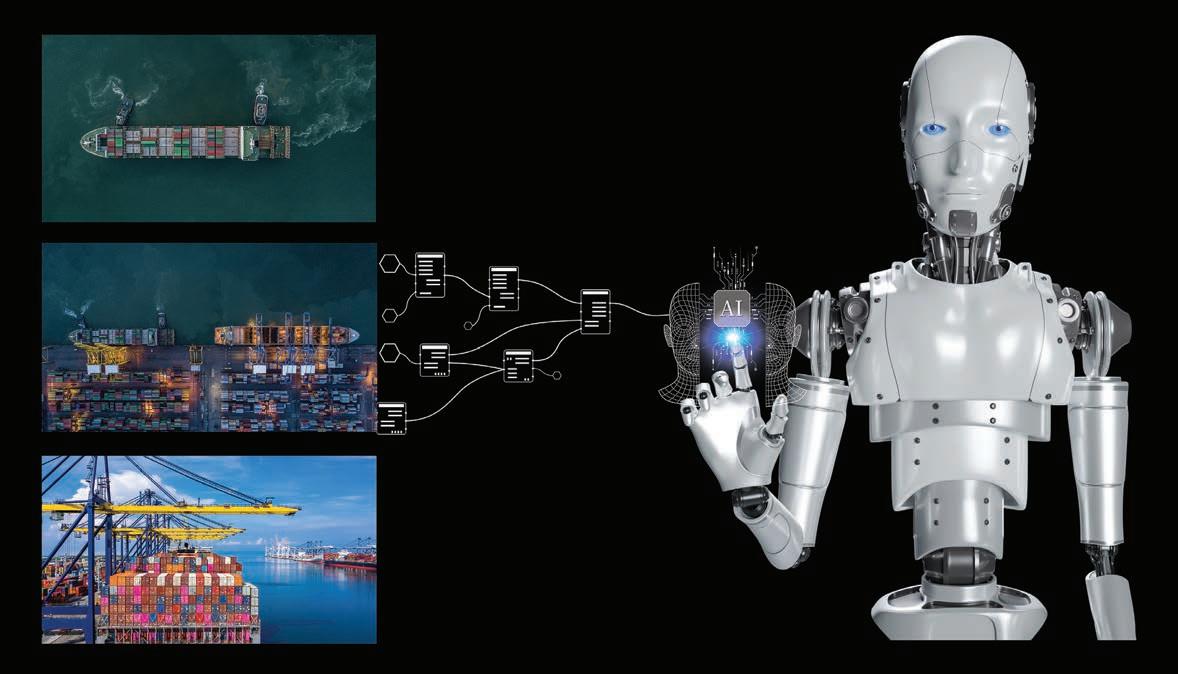
Artificial intelligence and supply chains are a natural fit, but careful consideration is required to unlock the full benefits of this technology, writes
ANTHONY SHARPE
There’s scarcely an industry on the planet that will remain unaffected by artificial intelligence (AI) in the near future. With its ability to ingest, process and analyse enormous quantities of data, AI is reshaping how decisions are made and the speed at which organisations can respond to change.
This makes it an obvious fit for supply chains, which generate increasingly vast amounts of data through a burgeoning array of sophisticated monitoring tools, including internet of things devices, that must be
able to adapt to more frequent and unpredictable disruptions.
A proliferation of AI-powered tools has appeared to help companies manage their supply chains, with features including demand forecasting, dynamic planning optimisation, integrated business planning and automation. McKinsey found that early adopters of such tools were able to achieve a 15 per cent reduction in logistics costs, a 35 per cent improvement in inventory levels and 65 per cent better customer service.
“ONE OF THE MOST GAME-CHANGING APPLICATIONS OF AI IN THE SUPPLY CHAIN IS HIGHLY ACCURATE AND FAR-SEEING DEMAND FORECASTING.” – DR CARL DU PLESSIS
FAST FACT
The global AI in supply chain and logistics market value was estimated to be R98-billion in 2022 and is predicted to grow to R200-billion by 2028.
Source: Market Research Guru
LOOKING INTO THE FUTURE
One of the most game-changing applications of AI in the supply chain is highly accurate and far-seeing demand forecasting, says Dr Carl du Plessis, machine learning engineer at Spatialedge. “The improvement in available tools and technologies has allowed quick iterations of complex models to be tested, verified and validated. The implication is that nuanced information can be more readily captured and incorporated into the models. AI thus allows
46 SUPPLY CHAIN MANAGEMENT

A PROLIFERATION OF AI-POWERED TOOLS HAS APPEARED TO HELP COMPANIES MANAGE THEIR SUPPLY CHAINS, WITH FEATURES INCLUDING DEMAND FORECASTING, DYNAMIC
PLANNING OPTIMISATION, INTEGRATED BUSINESS PLANNING AND AUTOMATION.
us to accurately model extremely complex environments and use these models to create realistic future states. While future states can then be used directly in procurement, they also present great opportunities in logistics and distribution as examples of other areas for both cost savings, waste reduction and innovation.”
STARTING ON THE RIGHT FOOT
Of course, an AI can’t just transform your supply chain straight out of the box; you need to train it first – on the right data. No AI system can ever effectively learn, analyse, predict or make recommendations for its use case if the correct data was not chosen in the first place, says Rheinhardt Schulze, Africa supply chain leader at EY.
“Supply chains are notorious for having myriad different internal and external stakeholders and systems. Key to the success of any AI platform is being able to integrate these,” he explains.
FAST FACT
Schulze says organisations should be cleaning, synthesising and maintaining their data, but adds that this role should be owned by supply chain management. “In the past, you could get away with the supply chain team focusing on operations and IT dealing separately with data, but actually supply chain plays a crucial role in training the models to do what you want in terms of decision-making and predictive analytics.”
Spatialedge data scientist

Dr Thorsten Schmidt-Dumont says their team starts by focusing on identifying and collecting the data for the AI model that needs to be developed. “You need to ensure that this data is collected and subsequently analysed to a high standard to understand nuances and intricacies within the data. This includes working with the business to understand the problem and the data source systems and exploring and experimenting with available datasets.”
Demand forecasting is the greatest digital investment priority for supply chains, followed by real-time product and parts tracking, capacity planning, dynamic inventory planning and real-time supply tracking.
Source: BCG digital transformation survey
PILLARS OF SUCCESS
Spatialedge identifies five organisational pillars to consider when developing an AI or machine learning model.
1. People and skills: the most important consideration for a company is to ensure you have a strong data engineering, data science and machine learning engineering team. To develop successful models that deliver business value, you need all three roles.
2. Organisational strategy and alignment: this considers the extent to which the organisational vision, strategy and funding support the AI initiatives of the organisation. It considers the level of advocacy and alignment within the organisational structure for the initiatives and evaluates the business case for AI.
3. Process: this is how the AI initiatives are planned, managed and evaluated. It needs to be well-defined and rooted in best practice.
4. Data management: how datasets are managed in support of AI initiatives – from data collection, to storage, to processing. Characteristics such as quality, accessibility and availability are vital.
5. Governance: the coherency of and compliance to the organisation’s data governance strategy in support of its AI initiatives, including technical standards, data protection and security.
Dr Schmidt-Dumont adds that as data scientists discover useful features within the information, they look to the data engineering team to move and structure the data within an organisation. “Data engineers also ensure that the data is available, accurate, up-to-date and trustworthy. The best practice is to start small, using relatively simple models that can be improved or replaced with more complex ones over time and not wait three years for a mature data lake before developing the AI models. Start executing, solving the problem as quickly as possible and improve over time.”
SHARING IS CARING
For supply chains to benefit from the enormous potential of AI solutions, stakeholders across them need to be willing to collaborate and
SUPPLY CHAIN MANAGEMENT 47 ARTIFICIAL INTELLIGENCE
Rheinhardt Schulze
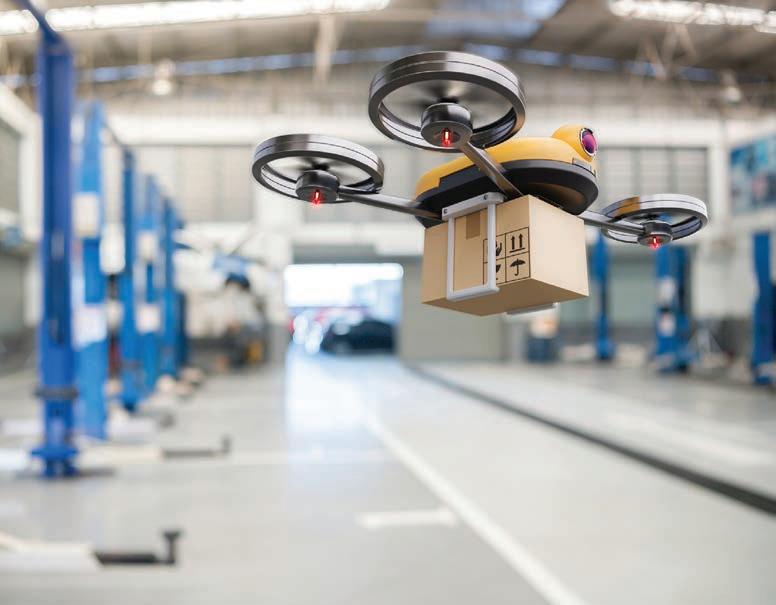

keep their data to themselves, allowing them to ‘upsell’ to the retailer. This can be counterproductive because the retailer would often own very rich sales datasets that, when combined with those of the logistics provider, could unlock enormous AI potential.”
Le Roux says this can be improved by finding a win-win situation to motivate two companies to share data between the two companies. “This needs to keep the confidentiality of the client data in mind, especially when working with a third-party provider that may gain access to multiple retailers’ data. In such a scenario, high-quality data governance will need to be established by both the retailer and the logistics supplier.”
It’s not just across companies where data sharing can be a challenge; sometimes this is not effectively done internally either, adds le Roux. “Typically, this is due to a lack of discoverability, technical skills or infrastructure. The team needs to put pressure on the different departments within the organisation to improve and share data internally –
LEARNING TO WORK WITH AI
As important as training your AI models on the right data is training your staff to work effectively with these tools. EY’s Rheinhardt Schulze says that, at its core, AI brings a continuous evolution of learning, so continuous skills development for people is essential. “The operational skills currently used in supply chain management will remain relevant, but I think we’ll see a shift towards programming, data analysis, visualisation and problem-solving skills. You want your user to be in more of a supervisory role, solving for exceptions, for things that the AI, based on its prior learning, can’t.”
this decision will need to be supported from a strategic business perspective as well to ensure that the value can be unlocked.”
THE BUSINESS CASE
That strategic business perspective should be the crux of any AI deployment, says Schulze. “You have to ask: what value is this going to bring to the organisation? There’s often a drive to do something in business just for the sake of it because it’s popular, but you should always focus on the business value, then allow that to shape your roadmap.”
The next question to ask, says Schulze, is whether or not you have the infrastructure, data and people to exploit that value fully. “Convincing supply chain managers of AI’s potential power isn’t necessarily the challenge, but these three elements might be an obstacle to adoption.”
Schulze encourages organisations to prove that value or use case, then expand on it to get further buy-in. “That’s how I’d approach any tech transformation in the supply chain. Proving value, or failing to do so, quicker is much more successful than waiting for the big, ‘AI is the only way’ approach.”
“ORGANISATIONS SHOULD BE CLEANING, SYNTHESISING AND MAINTAINING THEIR DATA, BUT THIS ROLE SHOULD BE OWNED BY SUPPLY CHAIN MANAGEMENT.” – RHEINHARDT SCHULZE
ARTIFICIAL INTELLIGENCE 48 SUPPLY CHAIN MANAGEMENT
IMAGES: AVIGATORPHOTOGRAPHER/ISTOCKPHOTO.COM, GORODENKOFF/ISTOCKPHOTO.COM, JSHUTTER2U/ISTOCKPHOTO.COM



TOWARDS A MORE VISIBLE, AUTOMATED SUPPLY CHAIN
The multiplying complexities of the omnichannel landscape are driving technological developments in supply chains.
By NEIL GOUVEIA , director for Africa at Zebra Technologies
With e-commerce fulfilment occurring from brick-and-mortar stores, warehouses/distribution centres and even manufacturing facilities in some direct-to-consumer models, all supply chain stakeholders are finding fulfilment and shipping complex. They must think about how they can better support buy online/pick up in store and buy online/return in store as well as direct fulfilment and return paths.
Rising investment in physical automation solutions and new product profiles, packaging levels and paths to market are expected as supply chain players further refine operations, and as consumers today demand previously siloed experiences related to how they browse, learn about, acquire and consume a retailer’s product to be seamless and interchangeable. This tectonic shift is driving a rethink of all retail operations, and most retailers have at least begun the transition.
There are several key foundational elements to increase the profitability of the omnichannel retailer. These include modernising in-store fulfilment with real-time inventory views to streamline order fulfilment tasks and a
broadened view of the distribution network. This means a more versatile view of stores, warehouses and distribution centres where e-commerce distribution and store fulfilment capabilities overlap.
FACTORS AFFECTING THE SUPPLY CHAIN REDESIGN
Customer expectations, costs and inventory in brick-and-mortar stores will drive the need for a redesigned supply chain. Look for customer expectations to drive service in assortment and turnaround time or “what has to be achieved”. Changing cost elements will dictate new priorities and can be seen as the “how to achieve”.
For instance, higher fuel costs will cause an increase in over-the-road transportation fees and higher cost of capital spurs reluctance to stock more than minimum safety stock. Determining how to leverage brick-and-mortar store inventory will be part of the supply chain solution for retail. Uncertainty is an important factor and will drive more enterprises to partner with third-party logistics where appropriate.
With supply chains becoming more complex and fragmented, the number of supply chain nodes will increase. Each node holds its own data
THIS YEAR WILL SEE CHANGED SOURCING AND PROCUREMENT PATTERNS, REQUIRING NEW INBOUND NETWORKS AND ROUTES. NEARSHORING MANUFACTURING WILL HAVE AN IMPACT ON THE FLOW OF GOODS.
in legacy systems of record. Unlocking this local data and accessing it for an end-to-end view will impact the state of visibility of goods flowing from manufacturing to the final consumer.
Closing visibility gaps will become more important, if not imperative. This year will see changed sourcing and procurement patterns, requiring new inbound networks and routes. Nearshoring manufacturing will have an impact on the flow of goods.
NEW LAST-MILE DELIVERY MODELS
In the last-mile space, more companies will use multiple employment models for deliveries. The fastest-growing trend is outsourcing to flexible, hourly delivery contractors. However, some retailers and restaurants could try to bring services back in-house by adding more payroll employees or in-sourced contractors. They’re tired of paying third-party service fees, and outsourcing deliveries introduces greater risk in the customer experience.
If something goes wrong, the third-party service typically isn’t the one that suffers; it’s the retailer. For the online shopper, the last-mile delivery experience might be the only interaction with the brand, and temporary gig workers might not portray the image a retailer carefully crafted into its marketing efforts. Ship-from-store, shipping from manufacturing or distribution (drop shipping) and new modes of transportation to deliver to the consumer (cargo bikes, electric vehicles) will augment the traditional van-based, last-mile delivery landscape.
REAL-TIME DATA WILL DRIVE DECISIONS
Given the high-profile nature of supply chain breakdowns, words won’t be enough. Leaders will have to get these intelligent technologies online as fast as solution providers can support the deployments. Customers and partners will demand to see what’s happening on the road, in the skies, at ports and in all staging areas. They want to understand what’s happening, why it’s happening and what they can do about it. This will become easier with the right artificial intelligence/machine learning platform, radio frequency identification, electronic data loggers and other advanced vision and tracking technologies, for example, platforms such as FourKites that give an “air traffic control”-type view of supply chain movements.
In other words, 2024 will be the year transport and logistics co-ordination and supply chain orchestration become simpler, more straightforward and, to a certain extent, automated.
SUPPLY CHAIN MANAGEMENT 51 OMNICHANNEL
IMAGES: GREENBUTTERFLY/ISTOCKPHOTO.COM
SUPPLY CHAIN COMPLEXITIES AMID RISING CUSTOMER DEMANDS
As e-commerce in South Africa grows and competition intensifies among online retailers, it is becoming imperative for brands to leverage advanced technologies to cater to personalised demands, writes ITUMELENG MOGAKI
Convenience is the new normal for retail customers locally and globally, says Thomas Kingombe, MD and partner at Boston Consulting Group Johannesburg. “Their expectations of receiving products faster, no matter how and where they want them, has risen dramatically over the past decade and, as brick-and-mortar retailers jump into the fray, supply chain complexities rise because of increasing customer expectations of convenience.
“In today’s omnichannel world, demand is far less predictable than it was in the past. As more retailers expand their channels online, pickups at the store, shipping from the store, drop shipping from the manufacturer or shipping from an intermediate storage facility, inventory and delivery costs are escalating.”

Consumers have more options in terms of promotions, pricing, and fulfilment, but this only fuels complexity for the supply chain, Kingombe explains. “The number of ‘flows’ in the distribution network has multiplied, and companies have gone from a few deliveries weekly to a handful of distribution centres to almost daily deliveries to hundreds of fulfilment centres, dark stores, brick-and-mortar stores and private addresses.”
Additionally, the increasing costs of these added complexities can, unfortunately, only land in one place given the low margins of most retailers – and that is with the consumer.
DIGITAL LOGISTICS
On the supply chain side, Antonio Calvo, director for EMEA: Global Retail and CPG Practice at SAS, points out that challenges to meet personalised demand from e-commerce include managing and maintaining optimal inventory levels for a diverse product range while trying to manage business profitability.
“Meeting dynamic demand in manufacturing operations while ensuring product availability throughout the supply chain is a major challenge for brands,” says Calvo. “Digital logistics provides brands with more than a virtual model of operations. By harnessing analytical optimisation, digital logistics platforms deliver strategic advantages to empower businesses with advanced insights to inform production and supply chain strategies and meet dynamic customer demand. Proactive planning is key to building supply chain resilience. But when unexpected challenges suddenly arise, the ability to swiftly correct course becomes critical.”
He adds that by digitally connecting factories, brands can link supply chain planning, material needs and production scheduling, ensuring a seamless flow of goods. “This approach integrates real-time data and analytics, enabling brands to make informed decisions, optimise manufacturing performance and predict demand more accurately.”
REVERSE LOGISTICS
E-commerce players are also under pressure to make product return policies as quick and easy as possible for customers, says Nathalie Schooling, CEO of nlightencx. “Consumers
FAST FACT
Following a sharp rise during the pandemic, online sales growth has begun to slow, growing by 30 per cent in 2022, down from 40 per cent in 2021. Sales growth is still signifi cantly faster than total retail sales, which grew just 1.7 per cent in 2022.
Source: Online Retail in South Africa 2023 Report
demand convenience from every aspect of their online shopping experience, including easily returning the goods they don’t want. So, e-tailers wishing to remain competitive need to take this part of the customer journey seriously.”
Schooling explains that some local e-commerce platforms regard “reverse logistics” (sending goods back along the supply chain to the original supplier) as a costly and unwanted burden. “Consequently, customers are sometimes charged for returns, or the process is made unwieldy and complicated to deter shoppers, leading to major frustration.”
She adds that if the process of returning items isn’t hassle-free, customers won’t shop online again, or they’ll switch to a different e-commerce platform. “Effective returns management shouldn’t be a chore or a cost centre for the business; it must be a critical part of a customer acquisition and retention strategy.”

“BY DIGITALLY CONNECTING FACTORIES, BRANDS CAN LINK SUPPLY CHAIN PLANNING, MATERIAL NEEDS AND PRODUCTION SCHEDULING, ENSURING A SEAMLESS FLOW OF GOODS.” – ANTONIO CALVO

Technology, such as automation, artificial intelligence and machine learning, should be harnessed for more cost-effective reverse logistics that serve the customers’ interests, says Schooling. “To truly streamline the returns process, businesses must gather ongoing customer insights to find out where the customer concerns are, as well as understand bottlenecks in the logistics process – technology is a great enabler for this. There is an upward trend in companies using machine learning to increase visibility and predict supply chain disruptions. We are also noticing the benefit of advanced technologies in breaking down silos and communication barriers across the supply chain.”

52 SUPPLY CHAIN MANAGEMENT E-COMMERCE
Thomas Kingombe
IMAGES: SUPPLIED
Nathalie Schooling







THE MAIL IN THE COFFIN?
There remains a place for the South African Post Office in the digital world, but it’s unclear how its operational challenges can be fixed.
By TREVOR CRIGHTON
That it took until July 2023 for the South African Post Office (SAPO) to be declared insolvent, having been placed in provisional liquidation in February 2023, is somewhat miraculous. The entity has been operating at a loss for close to two decades. Its reported annual losses more than quadrupled from R1.2-billion in 2018 to R5.3-billion in 2019, and have remained between R2.2-billion and R2.4-billion in subsequent years. Business rescue practitioners Anoosh Rooplal and Juanito Damons declared its current losses totalling R12.5-billion as of 31 July 2023.
SAPO hasn’t met delivery standards mandated by the Independent Communications
Authority of South Africa in over a decade, despite the communications authority lowering the bar. The target was initially 95 per cent delivery success, but the regulating authority dropped it to 92 per cent during the 2014/15 financial year. SAPO achieved its highest level of delivery success in six years during the 2019/20 financial year at 89.25 per cent, but its decline is starkly illustrated in its 2022 annual report, which indicates that delivery success was just 68.36 per cent (up from 52.95 per cent in 2021).
FAST FACT
Research indicates that revenue in the courier and logistics industry in South Africa was estimated at R44-billion in 2022 and is expected to grow to R60-billion by 2027 at a compound annual growth rate of 7.0 per cent.
Source: Who Owns Whom
FILLING THE GAPS
This decline has seen logistics companies step into the breach to make up for SAPO’s inefficiency, spawning many new kinds of
SAPO’S APPROVED BUSINESS RESCUE PLAN INVOLVES RESTRUCTURING THE ENTITY TO ENSURE IT CAN PROVIDE ITS MANDATED SERVICES ACROSS SOUTH AFRICA.
SUPPLY CHAIN MANAGEMENT 59 COURIER SERVICES

“OUR FOCUS AS A BUSINESS IS TO CREATE A CONVENIENT DELIVERY SERVICE TO ALLOW E-COMMERCE COMPANIES TO SERVE THEIR ONLINE BUYERS AFFORDABLY.” – LARS VEUL
delivery services and seeing existing courier and logistics services increasing their service scope. Pargo was founded in 2015 by e-commerce entrepreneurs Lars Veul and Derk Hoekert, who moved to Cape Town from the Netherlands in 2012 to join one of the country’s leading online retail companies. A few days into their roles, they were instructed to make as little use of the local Post Office as possible, as the organisation was experiencing tremendous strain and service levels were dropping rapidly. Their insights encouraged them to start Pargo in an attempt to solve these challenges, building a network of more than 4 000 convenient pickup points that help thousands of people send and receive parcels every day.
STILL A PLACE FOR SAPO IN LOCAL LOGISTICS
Despite the business taking large bites out of SAPO’s lunch, Pargo’s Veul believes there
FAST FACT
is a place for a post office system in South Africa. “Accessibility to this service grows the economy, which we so desperately need, but not in the way it’s been run over the last twenty years. This needs to change. The demise of the SAPO has been ongoing for years and private business has long been stepping in to fill this gap. Does current-day private-sector service fulfil the needs of the everyday consumer?
I would say probably not – there is still some friction. Having said that, we are working hard on solving this and making sure digital commerce and the reliable movement of parcels are accessible to all.”
Veul says in an ideal world, private-sector delivery companies would be a supplementary service, with pickup points having greater reach and a stronger convenience factor. “However, our focus as a business is to create a convenient delivery service to
With the increasing adoption of digital forms of communication, there’s unsurprisingly been a concomitant reduction in the number of sent letters. Nevertheless, in 2019, conventional mail still accounted for 40 per cent of post revenues worldwide. Globally, the volume ratio of letters to parcels declined from 13:1 in 2005 to 4:1 in 2015, with that figure expected to reach parity by 2025.
Source: The Postal Performance of the South African Post Office: An International and Local Perspective, Hans Wittmann, Journal of Transport and Supply Chain Management
MORE THAN MAIL
SAPO isn’t only responsible for delivering mail, its branches also serve as payout points for social grants. According to its 2022 annual report, SAPO oversaw 7.2 million South African Social Security Agency beneficiary payments monthly, helped 15.2 million beneficiaries receive Social Relief of Distress grants, assisted 362 465 qualifying households register for the Digital Terrestrial Television (DTT) subsidised programme and facilitated the distribution of approximately 356 000 DTT set-top boxes to qualifying households.
allow e-commerce companies to serve their online buyers affordably and in areas that are typically hard to reach. Additionally, many of the customers using Pargo combine their order collections while shopping or filling the car up at the forecourt near home. These are unique service propositions a post office service cannot fill.”
Veul says consolidated delivery and “click and collect” are, in many cases, the only way to reach far corners of the country, especially in the lower segments of the market. “Home delivery is often out of reach to this consumer, hence a low-cost ‘click and collect’ model is vital to ensuring this important market sector can access digital commerce.”
60 SUPPLY CHAIN MANAGEMENT

CHANGE IS CONSTANT
While SAPO has demonstrated a tremendous decline in revenue and an increase in debt over the last two decades, Veul says no business is immune to challenging environments, particularly the kind of rising inflationary environment the world is going through at the moment. “This situation has forced everyone to review cost structures in great detail. On average, up to a third of all courier home deliveries are unsuccessful and require two to three attempts before a parcel is delivered to its owner. This is causing huge frustration and cost.
“In addition, a significant consumer sector in South Africa remains unable to receive courier home deliveries. Costs of delivering to townships, small towns or outlying areas are exorbitant and deliveries infrequent – all against the backdrop of a consumer landscape where people demand better and faster service and transparency. Something in this model has to change.”
SAVING SAPO
SAPO’s approved business rescue plan involves restructuring the entity to ensure it can provide its mandated services across South Africa. It plays a critical role in providing communication services to all households, particularly in rural areas where it offers largely the only communication system. Rooplal is quoted as saying that “a restructured Post Office can do this affordably and conveniently, given certain regulatory pricing and geographic reach of the branch network. This includes cutting thousands of jobs during the plan’s first phase to reduce SAPO’s headcount to around five thousand employees”. That means job cuts of around 6 000, more than half the organisation’s staff. During the 2021/22 financial year, 146 branches were officially closed, another 122 were closed during the 2022/23 financial year, and 58 branches were amalgamated.
The second phase of the plan will see the launch of the “Post Office of Tomorrow” strategy, which hopes to include offering diversified
DURING THE 2021/22 FINANCIAL YEAR, 146 BRANCHES WERE OFFICIALLY CLOSED, ANOTHER 122 WERE CLOSED DURING THE 2022/23 FINANCIAL YEAR.
A QUICK HISTORY LESSON
The first signs of a postal service in South Africa go back more than half a millennium. On 7 July 1501, the captain of a Portuguese ship placed a letter in the ancient “post office tree” in Mossel Bay, reporting damage and loss of some of his fleet during a storm off the southern Cape coast. The first post office in South Africa was opened formally on 2 March 1792 by the acting governor of the Cape, Johan Isaac Rhenius. On 1 October 1991, the then-Department of Posts and Telecommunications was split into three separate entities – Telkom, SAPO and a smaller government entity. SAPO has largely operated in its current form since then.
Source: The Postal Performance of the South African Post Office: An International and Local Perspective, Hans Wittmann, Journal of Transport and Supply Chain Management
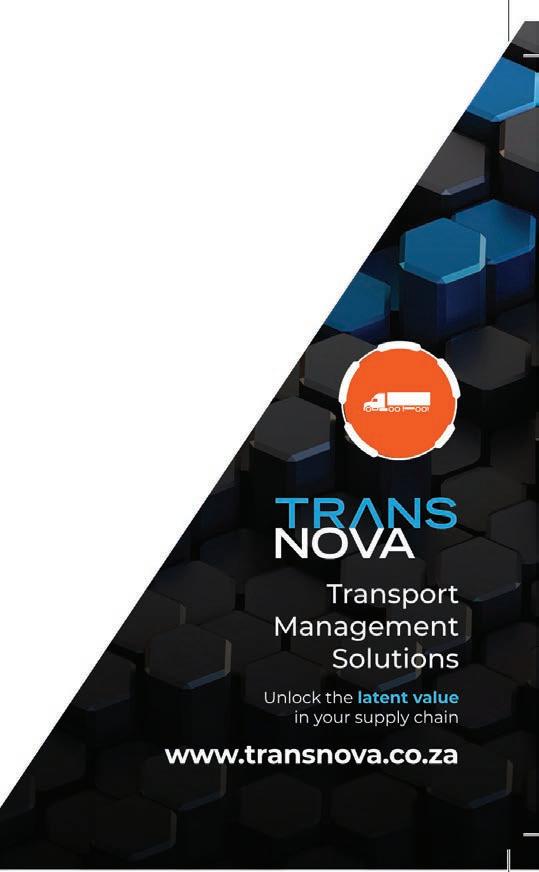
COURIER SERVICES SUPPLY CHAIN MANAGEMENT 61
IMAGES:
PROSTOCK-STUDIO/ISTOCKPHOTO.COM
GORODENKOFF/ISTOCKPHOTO.COM, SHIRONOSOV/ISTOCKPHOTO.COM,


FINDING THE WAY THROUGH THE MAZE OF LOGISTICS COSTS
Determining appropriate transport rates is a challenge facing manufacturers and their distribution partners, writes
CARSTEN SCHUBERT,
chief operating offi cer at Transnova

Transportation costs play a significant role in the ever-changing world of logistics in South Africa and remain a constant source of pressure for both goods manufacturers and transport companies that distribute these goods to the market. These costs impact supply chains, affect profit margins and ultimately influence the competitiveness of the entire economy. It is essential for any business wanting to succeed in this environment to understand how transport costs are determined and how to navigate their complexities.
A QUEST FOR VALUE IN A COSTLY MAZE
South African companies across all industries are always on the lookout for effi cient transportation solutions, but it is a constant struggle. Infl ation has a signifi cant impact, fuel prices are continuously on the rise, and the ongoing challenges of crime and a lack of investment in key infrastructure put immense pressure on manufacturers to get the most value out of every rand spent on transportation.
A clear correlation between the diesel price, Consumer Price Index (CPI) and Steel and Engineering Industries Federation of Southern Africa (SEIFSA) indices is evident in the graphic below. While most companies apply the CPI as the nonfuel inflationary metric when negotiating






transportation contracts, the SEIFSA L2 index better represents the actual transport cost basket. The SEIFSA L2 index comprises labour, tyres and tubes, spares/stores, amortisation and indirect costs – the real-world costs transporters deal with daily. The more applicable SEIFSA L2 index has averaged 2.4 per cent higher than CPI over the previous three years, impacting the profitability of transport companies that must absorb this differential in real transport cost increases.
For South African transport companies, the rising cost of labour, procuring new and replacement fl eet, fuel, tyres and vehicle maintenance eat into already tight margins. The impact of crime on their operations is ever-present, with hijackings, looting and cargo theft adding a layer of uncertainty and cost, resulting in signifi cant increases in insurance premiums.
According to the South African Road Freight Association Vehicle Cost Index, a prime mover (truck tractor) and semi-trailer cost increased from R2.6-million in 2021 to R3.55-million in 2023. This means that in only three years, the cost of purchasing a new, replacement vehicle combination increased by 36 per cent, while the cost of capital increased




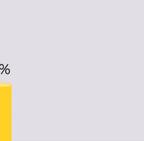






64 SUPPLY CHAIN MANAGEMENT
by a staggering 137 per cent. Two other large expense items, tyres and maintenance, increased by 56 per cent and 51 per cent respectively over the same three-year period.
Another significant challenge transport companies face is the cost of diesel. Many operating on a COD basis have, at best, secured 14- or 30-day terms with fuel suppliers, while the trend from manufacturers is to extend payment terms from 30 to 60 days. Some global corporations only offer 120-day payment terms, which makes managing cash flow a nightmare for transport owners.
The specific cost items that comprise owning and operating a truck tractor and trailer combination are illustrated below (note that the increase in the cost of capital in 2022 is largely due to increases in the asset price and higher interest rates).
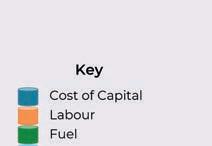



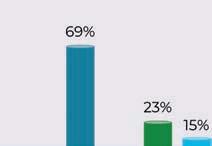




Road Freight Association Vehicle Cost Index Concept, 18 December 2023
RATES BENCHMARKING OFFERS A BEACON OF HOPE


BEYOND RATES: A HOLISTIC APPROACH TO COST REDUCTION
However, rate benchmarking is just one piece of the puzzle. A holistic approach to cost reduction requires a collaborative effort from both manufacturers and transporters.
Manufacturers can optimise their processes by:
• Centralising transportation management: defining a robust transport strategy that complements the overall business strategy and consolidating volume with fewer providers can lead to better rates and improved efficiency.
• Adopting leading technology solutions: utilising platforms for load allocation, route optimisation and real-time tracking can streamline operations and reduce costs.
• Collaborating with transporters: building strong relationships, open communication and transparent reporting can lead to mutually beneficial solutions.
• Improving supply chain efficiencies: removing nonvalue-adding processes to eliminate waste and improve vehicle turnaround times at loading and offloading points.
Transporters can:
• Invest in efficient equipment: newer trucks with fuel-efficient technologies and proper maintenance can significantly reduce fuel costs.
• Diversify revenue streams: exploring specialised services, such as refrigerated transport or door-to-door delivery, can offer new growth opportunities.
Rates benchmarking is a valuable tool for companies and their transport service providers to gain better insights into the murky waters of transport costs. By comparing transport rates to market averages, both parties can identify potential issues and negotiate more effectively.
Transport rates benchmarking involves analysing actual transport rates against market averages for similar shipments – a like-for-like comparison is essential here. This process requires collecting data on relevant shipments, including origin, destination, cargo type, volume, lead times and any special requirements. Then, benchmarking platforms, industry reports or specialised logistics consultancies can be used to access market data for comparable routes and scenarios.
It is essential to consider several crucial factors while comparing actual rates to benchmark rates. Are the shipments exactly alike? Do they both involve the same type of transport and lead time? How do the compared regions’ fuel prices, infrastructure conditions and regulatory environments differ? These nuances must be factored in to ensure a balanced and meaningful comparison.
Interpreting the results goes beyond identifying deviations from the benchmark. It is necessary to consider the reasons behind any discrepancies. Are higher rates justified by exceptional service, specialised equipment or faster delivery times? Conversely, always bear in mind that the lowest market rates might carry hidden costs or potential risks that are not immediately apparent.
Ultimately, rates benchmarking is a powerful tool for understanding your position in the market, negotiating with your transport service providers or customer and optimising your transport costs. By meticulously analysing the data and factoring in the broader context, you can confidently navigate the complex world of transport pricing and make informed decisions that drive cost efficiency and business success.
• Embrace technology: adopting telematics, integrated mobile applications and route planning tools can improve efficiency and reduce risk.
HOW TECHNOLOGY EMPOWERS COST-EFFICIENT TRANSPORT IN SOUTH AFRICA
In South African logistics, where every rand counts, technology is emerging as a potent weapon in the battle against soaring transport costs. Embracing digital solutions isn’t just a fad; it’s a strategic imperative for both manufacturers and transporters seeking to optimise operations, trim expenses and stay ahead of the curve.
Manufacturers: harnessing the power of transport management systems
For South African manufacturers, a robust transport management system (TMS) is an indispensable companion. A TMS unlocks
SUPPLY CHAIN MANAGEMENT 65 RATES
a treasure trove of cost-saving features, from streamlined procurement and route optimisation to real-time shipment tracking and automated invoice reconciliation.
• Centralised visibility: no more juggling spreadsheets, WhatsApp groups and phone calls. A TMS provides a single platform for managing all transportation needs, offering holistic visibility into routes, costs and performance. This empowers companies to identify inefficiencies, negotiate better rates and optimise transportation budgets.
• Route optimisation: gone are the days of inefficient, meandering routes. Advanced algorithms in TMS software suggest the most cost-effective and time-efficient paths, considering factors such as traffic patterns, fuel consumption and driver compliance. This translates to reduced fuel costs, less CO2 emissions due to fewer kilometers travelled, faster delivery times and happier customers.
• Real-time visibility: companies no longer need to hold their breath, anxiously awaiting updates on their cargo. Real-time tracking offered by TMS solutions reveals the exact location of shipments, providing peace of mind and enabling proactive interventions in case of delays or unforeseen events.
Transporters: mobile
apps fuelling operational efficiency
For South African transporters, mobile apps have become more than just convenient tools; they are catalysts for operational efficiency and cost reduction.
• Driver management: apps can streamline driver communication, dispatch assignments and track hours of service, ensuring compliance and optimising driver resource allocation. This promotes driver satisfaction, minimises overtime costs and enhances overall efficiency.
• Paperless workflows: ditch the mountains of paperwork. Mobile apps enable digital document capture, invoice processing and expense management, eliminating manual effort and reducing administrative costs. This translates to faster turnaround times, improved accuracy and happier drivers.
• Predictive maintenance: proactive maintenance is key to avoiding costly breakdowns and delays. Mobile apps with

artificially powered features can monitor vehicle health, predict potential issues and schedule preventive maintenance, minimising downtime and maximising vehicle uptime.
Real-time execution management tools
For both manufacturers and transporters, real-time execution management tools act as a bridge, fostering seamless collaboration and cost-effective execution.
• Shared visibility: a single platform allows both parties to see the same real-time data on shipments, enabling proactive problem-solving and efficient communication. This promotes trust, builds strong partnerships, and eliminates finger-pointing in case of delays or issues.
• Exception management: unexpected events are inevitable. Real-time software solutions provide instant alerts for deviations from planned routes, delays or potential security threats. This allows both parties to react quickly, minimise disruptions, and mitigate potential losses.
• Continuous improvement: data is the lifeblood of improvement. These tools capture valuable data on routes, performance and costs, providing insights for manufacturers and transporters to continuously optimise their operations and identify areas for further cost reduction.
EMBRACING TECHNOLOGY FOR A COLLABORATIVE FUTURE
By embracing technology and putting the right business processes in place, manufacturers and transporters can transform the South African logistics landscape from a minefield of inefficiencies
into a highway of cost-effective excellence. Collaboration, data-driven decisions, and shared commitment to digital solutions are the cornerstones of future success.
The future belongs to those companies that embrace innovation and agility. In the face of rising costs and a dynamic economic landscape, South African logistics can only thrive by harnessing the power of technology, one TMS platform, one mobile app and one real-time data point at a time. Let’s pave the way for a future where transport costs are not roadblocks, but catalysts for growth, spurred by the shared vision of a lean, efficient, and globally competitive South African logistics ecosystem.
A CALL FOR COLLECTIVE ACTION
The unique challenges of the South African landscape demand a collective approach to tackling transport costs. Government intervention in infrastructure development, crime reduction and fuel price regulation can provide a much-needed boost.
Manufacturers and transporters can collaborate to advocate for these changes while fostering a culture of open communication and transparency within the industry. By working together, the industry can create a more efficient and cost-effective transport ecosystem that benefits all stakeholders and drives South Africa’s economic growth.
In conclusion, finding your way through the maze of transport costs in South Africa requires a nuanced understanding of the challenges facing manufacturers and transporters.
By embracing transparency, leveraging technology and fostering collaboration, we can unlock cost-saving opportunities and build a more resilient and competitive logistics sector. Only then can we truly harness the power of efficient transport to drive South Africa’s economic engine forward.
66 SUPPLY CHAIN MANAGEMENT RATES REAL-TIME EXECUTION MANAGEMENT TOOLS ACT AS A BRIDGE, FOSTERING SEAMLESS COLLABORATION AND COST-EFFECTIVE EXECUTION. IMAGES: MILOS-MULLER/ISTOCKPHOTO.COM, ANDREYPOPOV/ISTOCKPHOTO.COM, SUPPLIED

OPTIMISING LIQUIDITY IN SUPPLY CHAINS
Organisations need to adopt innovative strategies to navigate economic challenges,
writes MIKE BRANDON, MD of Merchant West Working Capital Solutions
The South African business landscape has faced substantial challenges and changes in recent decades, from global economic fluctuations, geopolitical shifts and conflicts and, more recently, the current disruptions to shipping in the Red Sea, to domestic infrastructural constraints and the lingering effects of the COVID-19 pandemic.
The impact of climate change has added another layer of complexity, disrupting global and local supply chains. Notably, extreme weather events, such as droughts affecting vessel movements through the Suez Canal, have highlighted the additional vulnerability of supply chains to environmental factors.
Amid these challenges, monetary policy adjustments aimed at addressing them have altered market dynamics, creating cost of living pressures for consumers globally. The heightened cost of capital has intensified the pressure on businesses striving for growth and competitive advantage in an unpredictable environment.
LIQUIDITY WOES
One method that businesses employ to preserve liquidity is negotiating extended payment terms with suppliers. However, this places a financial burden on suppliers, forcing them to borrow to meet the extended payment demands and constraining their growth potential.
In response, larger buyers, particularly corporates, are proactively investing in their supply chains by providing technical advice or funding support. Many of these businesses are actively nurturing their suppliers to foster growth and safeguard the availability of essential inputs.
Despite these efforts, a potential conflict arises in the supply chain due to the absence of innovative financing solutions that can effectively address the competing cash flow needs of both suppliers and buyers. The market has responded with various traditional and digitally enabled supply chain financing solutions. However, there is often confusion surrounding their operation and the value they bring to the supply chain ecosystem on a sustainable and mutually beneficial basis.
USING THE RIGHT INSTRUMENTS
Contrary to common perception, we assert that supply chain finance is not a product; instead, it comprises a set of techniques optimising liquidity for suppliers and buyers. These techniques accelerate cash inflows for suppliers and delay cash outflows for buyers, facilitated by a finance intermediary assuming payment risk on behalf of the buyer. This intermediary
operates on either a “with” or “without” recourse basis to the supplier for a specified period based on the transaction terms.
These techniques, encompassing various product forms, such as “invoice discounting”, “factoring” and “purchase order finance”, are offered by banks, independent finance houses and fintech firms. In essence, supply chain finance simplifies the process of cash flow optimisation in the supply chain, using instruments such as invoices or promissory notes, which can be assigned, purchased or endorsed.
NEGOTIATING TERMS
At its core, supply chain finance involves a negotiation between a supplier and a buyer, reflecting their relative negotiating power. The finance intermediary steps in, providing the supplier with funds in advance, allowing them to trade without liquidity constraints. The buyer keeps its cash for an extended period, balancing the needs of both parties. While variations exist in disclosure levels and recourse arrangements, the fundamental purpose is still to facilitate liquidity flow in the supply chain ecosystem.
At Merchant West Working Capital Solutions, we take pride in our ability to advise both buyers and sellers on the strategic application of these techniques to optimise their liquidity profile, empowering businesses to flourish, benefitting stakeholders and fostering the health of their supply chains. By contributing to the restoration of the South African economy to higher growth rates, we aspire to make a meaningful difference in the lives of its people, simplifying the understanding of these solutions to encourage wider adoption.
SUPPLY CHAIN MANAGEMENT 67
IMAGES: IPOPBA/ISTOCKPHOTO.COM, SUPPLIED SUPPLY CHAIN FINANCE INVOLVES A NEGOTIATION BETWEEN A SUPPLIER AND A BUYER, REFLECTING THEIR RELATIVE NEGOTIATING POWER.
FINANCE




BETTER PLANNING FOR BETTER SUPPLY CHAINS
Enterprise resource planning solutions can play a significant role in optimising Africa’s supply chains to a global standard, writes
STEPHEN HOWE , director of Times 3 Technologies

With the technology sector increasingly looking to the continent’s vast resources to service demand, particularly for minerals, such as aluminium, cobalt, copper and manganese, African companies will be required to adhere to international supply chain management best practice. No less an authority than the United Nations Conference on Trade and Development has highlighted Africa’s potential as a key player in global supply chains by virtue of advantages, such as shorter and simpler access to primary inputs, a younger, technology-aware and adaptable labour force and a burgeoning middle class.
Enterprise resource planning (ERP) intelligence can give African supply chain managers real-time insights into demand patterns, inventory, supplier performance and even distribution so they can make the best possible decision for the company – and ultimately the continent.
Procurement professionals also benefit, as this software offers tremendous visibility into aspects such as raw material availability and supplier delivery. It puts them in the enviable position of being able to improve sourcing strategies and negotiate the best terms with suppliers.
What is important to note is that ERP systems benefit everyone, from production managers to quality control and inventory teams. With the greater insights these systems can help yield, they can all optimise their performance to build an even stronger supply chain.
The advanced analytics tools embedded in the solution process analyse real-time data, meaning that trends, patterns and any anomalies can be quickly identified and addressed. Furthermore, the intelligence tracks key performance indicators such as lead times, on-time delivery rates and inventory turnover. Dashboards and reports visualise these metrics, enabling quick assessment of performance.
BEING ABLE TO INTEGRATE DATA FROM VARIOUS STAGES OF THE SUPPLY CHAIN TO CREATE A HOLISTIC VIEW OF THE ENTIRE PROCESS IS MAKING A HUGE DIFFERENCE TO COMPANIES.
KNOWLEDGE IS POWER
All these advantages can aid African organisations in anticipating fluctuations in demand and adjusting production and procurement accordingly. This is essential given the dramatic shifts seen in the global landscape currently.
Tensions in the Red Sea region and commercial vessels coming under attack from the Houthi militia, for example, have raised concerns over these shipping lanes.
As the South African Association of Freight Forwarders points out, sailing via the Cape of Good Hope means unavoidable extra nautical mileage. For example, the distance from Singapore to Rotterdam via the Cape, with no other ports in between, is nearly 3 600nm longer than going via the Suez Canal at 8 300nm. Vessels could steam at faster speeds, but this will incur significant extra fuel and maintenance costs.
At the same time, the economic downturn in China is affecting global markets in various ways. While Europe is feeling the pinch of rising prices, North America is once again on the up.
In the global supply chain, everyone is impacted, so the ability to offer accurate and up-to-the-minute forecasting becomes much more crucial. External forecast integration is excellent in this regard.
Internal ERP data can be integrated with external information such as weather predictions and the latest financial indices from the world’s governments. Knowledge is power, and the more contained in an ERP solution, the better for Africa’s businesses.
GETTING THE FULL PICTURE
Once a forecast is created, a growth expectation is generated, facilitating the finalisation of an accurate, achievable sales budget for the following year at a volume and value level.
Being able to integrate data from various stages of the supply chain to create a holistic view of the entire process is making a huge difference to companies, and we certainly expect to see more African firms making use of this technology as they gain a greater foothold in the global market.
It is essential that a targeted and systematic approach is used, however. Attempting to take shortcuts will draw the wrong kind of attention and create distrust in Africa’s ability to play its part in the global supply chain.
SUPPLY CHAIN MANAGEMENT 71 ENTERPRISE RESOURCE PLANNING
IMAGES: ARTEMISDIANA/ISTOCKPHOTO.COM
FORTIFYING AGAINST ESCALATING VEHICLE CRIME
Logistics and fleet management companies are increasingly at risk of hijacking and theft and need to take security and safety measures to protect their assets, writes
JUNAID EBRAHIM,
executive: operations at Afrirent
Every year, the South African Police Service releases statistics that paint a grim picture of the scourge of vehicle-related crimes facing our country. The latest crime figures show that 60 vehicles are hijacked in South Africa daily, most of them business-owned vehicles.
Police and security companies are struggling to contain armed criminals committing cash-in-transit heists, hijacking trucks and courier vehicles transporting valuable cargo, and stealing cargo-carrying vehicles. These crimes not only threaten the lives of drivers, but also cause businesses to suffer significant financial losses.
The magnitude of the problem came into sharp focus in early 2021 when two security guards, Leo Prinsloo and Lloyd Mtombeni, were attacked by several gunmen while travelling in an armoured truck that was escorting a courier vehicle transporting cellphones. The attempted heist, foiled by the two security guards, was captured by a dashcam and a camera mounted outside their armoured truck. Dramatic footage of the armoured vehicle being pelted with bullets by the robbers went viral worldwide, showing the lengths criminals are prepared to go to steal valuable cargo.
PRIME TARGET
Last year, vehicle tracking and recovery group Tracker released statistics that showed that business-owned vehicles have a higher chance of being hijacked (65 per cent)
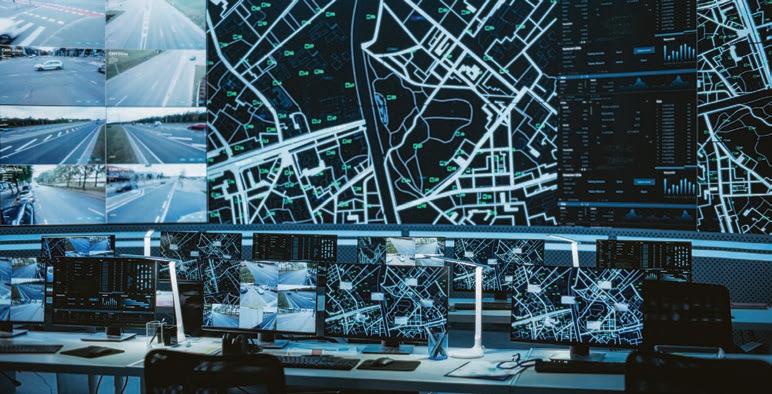
than stolen (35 per cent), compared with personal vehicles. This means that logistics and fleet management companies must take precautionary security and safety measures to mitigate risks and protect vehicles and drivers from criminal activities.
For this reason, we have fitted our fleets with state-of-the-art vehicle management technology such as Afritracker, a web-based smartphone app linked to a control room. The GPS-enabled system allows live tracking of vehicles that are equipped with dashcams and outside cameras to record footage for use in the event of criminal prosecution. The system provides GPS co-ordinates and the time and date of the videos, making it possible to track the vehicles and provide information about their whereabouts.
The system has a geofencing capability that advises drivers about crime hotspots (“no-go” zones) and alerts the fleet management operators when vehicles veer off the planned routes. This is valuable information given that 60 per cent of vehicle crimes occur in Gauteng, followed by KwaZulu-Natal at 17 per cent and the Western Cape at 9 per cent.
CLOSER CO-OPERATION BETWEEN INDUSTRY STAKEHOLDERS, LOGISTICS COMPANIES, LAW ENFORCEMENT AND PRIVATE SECURITY FIRMS IS CRUCIAL TO COMBATTING VEHICLE-RELATED CRIMES EFFECTIVELY.
ADDITIONAL SECURITY
Fleet managers can take further precautionary measures. Afrirent’s system, for example, includes in-vehicle panic buttons that drivers can use to alert the control room when they are in distress or faced with unforeseen emergencies. These panic buttons are automated and can be pressed remotely to call for an emergency response team to be dispatched to locate a vehicle.
Designed to identify any efforts by thieves or criminals trying to manipulate or interfere with it in an attempt to steal vehicles, the system also uses either a radio frequency identification key tag driver monitoring system or biometric reader technology, giving each driver a unique driver identification before starting a vehicle.
While fleet management companies implement robust measures at the company level, there’s a pressing need for collaborative efforts. Closer co-operation between industry stakeholders, logistics companies, law enforcement and private security firms is crucial to combatting vehicle-related crimes effectively.
South Africa stands at a crucial juncture where collective action, technological innovation and strategic partnerships can turn the tide against vehicle crimes. By fortifying our defences, we pave the way for a safer, more secure future.
72 SUPPLY CHAIN MANAGEMENT SECURITY
IMAGES: GORODENKOFF/ISTOCKPHOTO.COM

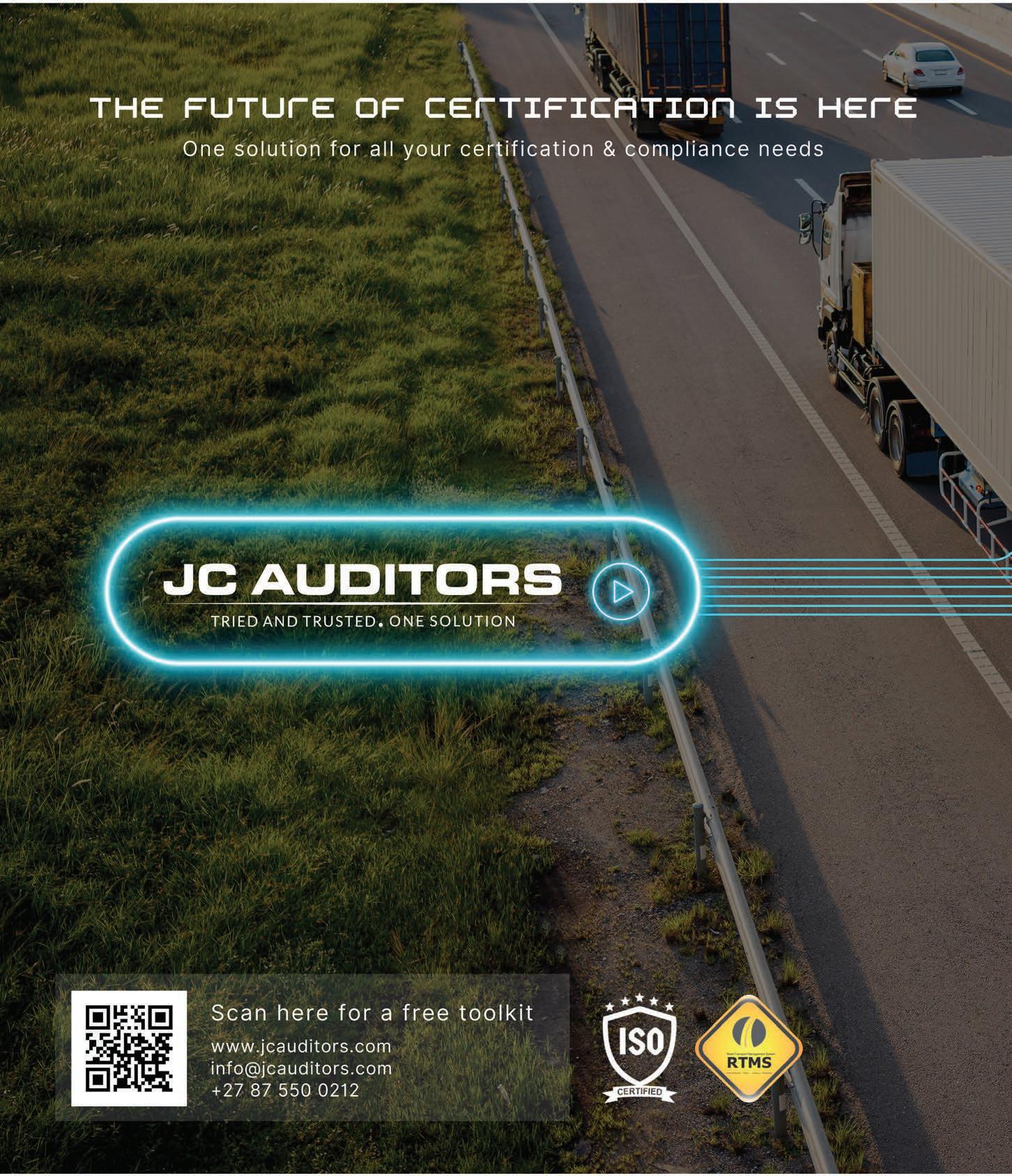

SAFETY AND SUSTAINABILITY THROUGH BETTER STANDARDS
Implementing ISO standards enhances operational excellence, improves product quality and ensures sustainability in the supply chain,
writes OLIVER NAIDOO, MD of JC Auditors
ISO standards have long been recognised as essential tools for achieving excellence in quality, safety, environmental sustainability and overall good governance.
By encouraging all players in the supply chain to embrace and uphold these standards, all stakeholders can create a more resilient, efficient and responsible global supply chain.
THE STAKEHOLDERS AND HOW THEY CAN BENEFIT
Suppliers: the foundation of any supply chain begins with suppliers. Encouraging them to adhere to ISO standards, such as ISO 9001 (Quality Management), ISO 14001 (Environmental Management) and ISO 45001 (Occupational Health and Safety), ensures the consistent delivery of high-quality products and the promotion of sustainable practices.
Manufacturers: ISO standards guide manufacturers in streamlining processes, reducing waste and maintaining product quality. Compliance with ISO 9001 not only benefits manufacturers, but also instils trust in their supply chain partners
Logistics and transportation: adherence to standards, including SANS 1395 Road Transport Management System (RTMS), plays a vital role in securing cargo and minimising risks during transportation, contributing to smoother logistics operations. Case studies presented by transport companies have demonstrated exceptional safety gains and reduced accidents due to the implementation of the South African National RTMS standard. This is especially notable considering the efforts to improve poor road safety in South Africa.
Distributors and retailers: distributors and retailers are the last touchpoints before products reach consumers. Implementing ISO
standards ensures consistent product quality and responsible environmental practices, reinforcing customer satisfaction.
Consumers: informed consumers increasingly seek products from supply chains that uphold ISO standards as it signifies a commitment to quality, safety and environmental responsibility. Their choices drive demand for ISO-compliant products.
STANDARDS MAKING WAVES
Organisations recognise that the adoption of ISO standards cannot occur in isolation. There is a need to encourage the widespread adoption of these standards throughout the supply chain. ISO standards provide a common language and framework that transcends borders and industries, allowing businesses to streamline operations, reduce risks and enhance their competitive edge. In the supply chain, ISO 9001 and ISO 14001 are two standards widely adopted internationally. ISO 9001 is the gold standard for quality management systems. It empowers organisations to establish robust processes, enhance customer satisfaction and drive continuous improvement. ISO 9001 is a linchpin for delivering products and services that consistently meet or exceed customer expectations. ISO 9001 fosters a culture of quality, reducing defects and ensuring that products move through the supply chain without disruptions. Standardisation of processes across suppliers, manufacturers and distributors improves co-ordination, reduces lead times and minimises errors. Adherence to ISO 9001 standards strengthens relationships with suppliers, promoting trust and reliability.
ISO STANDARDS PROVIDE A COMMON LANGUAGE AND FRAMEWORK THAT TRANSCENDS BORDERS AND INDUSTRIES, ALLOWING BUSINESSES TO STREAMLINE OPERATIONS, REDUCE RISKS AND ENHANCE THEIR COMPETITIVE EDGE.
Amid growing environmental consciousness, ISO 14001 is the bedrock for sustainable supply chain management. It guides organisations in managing their environmental impact and compliance with environmental regulations. ISO 14001 encourages sustainable practices throughout the supply chain, reducing waste, emissions and resource consumption. Adherence to environmental standards helps identify and mitigate environmental risks that could disrupt the supply chain. Companies with strong environmental credentials attract eco-conscious consumers and stakeholders, fostering brand loyalty and trust.
ENSURING COMPLIANCE
While adopting ISO standards within an organisation is a crucial first step, ensuring that suppliers and stakeholders also adhere to these standards can be a complex endeavour in today’s expansive and intricate supply chains. It is important to promote adherence using various strategies, including:
• Education and training: develop educational programmes to impart ISO standards knowledge to suppliers and customers. Sharing resources and best practices can also foster understanding and commitment.
• Collaborative initiatives: establish partnerships and initiatives with key supply chain partners to align practices and jointly work towards ISO compliance goals.
• Certification requirements: consider making ISO certification a prerequisite for supplier selection.
• Technology integration: leverage digital tools and platforms for real-time monitoring and reporting of ISO compliance across the supply chain.
ISO standards serve as invaluable guides for optimising supply chain performance. By fostering adherence to these standards across the supply chain and adopting a collaborative approach, businesses can ensure that they meet their ISO commitments and elevate the entire supply chain to new heights of efficiency, quality and sustainability. ISO standards provide a robust and proven framework for building sustainable supply chains.
76 SUPPLY CHAIN MANAGEMENT STANDARDS
IMAGES: GORODENKOFF/ISTOCKPHOTO.COM

A STRATEGIC PARTNER




Armscor is a strategic partner for defence and security solutions
The Armaments Corporation of South Africa SOC Limited (Armscor) is an acquisition agency for the South African Department of Defence (DOD) and other organs of state and entities.
Armscor’s mandate is to provide the armed forces with state-of-the-art defence material, delivering innovative defence solutions efficiently and effectively. The organisation manages the strategic capabilities of the DOD, producing research and vanguard technological solutions required for the safety and security for South Africa, its citizens and the continent.
GEROTEK TEST FACILITIES
Gerotek Test Facilities (Gerotek), an Armsor subsidiary, is an internationally accredited multidisciplinary facility offering various ISO 17025-accredited tests. The facility primarily aims to meet South Africa’s needs in the testing of defence-related and commercial vehicles and products.
Gerotek’s well-maintained facilities are located just 20km west of Pretoria in Gauteng Province on a 520ha site designed and built according to international standards to offer unparalleled
technical and service excellence to local and international markets.
Who we serve
Gerotek’s ISO-accredited and -certified facilities and services are available to both local and international clients to test and evaluate the performance of their vehicles and products. Services are designed to cater for the exact requirements of clients and to meet and exceed customer expectations.
Services offered
• Vehicle and product testing: Gerotek offers ISO 17025-accredited testing that adheres to international standards to promote repeatability and accuracy of tests. It offers a broad range of vehicle and product testing services including vehicle characterisation, endurance testing, evaluation/qualification of electronic, electrical and mechanical systems and components, fatigue testing and analysis, electromagnetic compatibility, antenna testing, and so forth.
• Advanced driver training: Gerotek’s advanced driver training focuses on safe
GEROTEK’S ISO-ACCREDITED AND -CERTIFIED FACILITIES AND SERVICES ARE AVAILABLE TO BOTH LOCAL AND INTERNATIONAL CLIENTS TO TEST AND EVALUATE THE PERFORMANCE OF THEIR VEHICLES AND PRODUCTS.

driving practice in a safe and controlled environment under expert supervision. Training interventions on offer include defensive-, advanced-, high-performance-, offensive- and 4x4-driver training. Gerotek offers TETA- and SASETA-accredited and other noncredit-bearing driver training courses.
• Facilities hire: the well-maintained Gerotek facility is suited for work and play. It is a unique venue for conferences, product launches, seminars, team-building activities, exhibitions, on- and off-road test tracks, and accredited shooting ranges, among others. Gerotek facilities are ISO 14001- and ISO 45001-certified.
• Events, recreation and conferencing: Gerotek’s event services are tailored to clients’ unique needs to enable corporate clients to get down to serious business in the conference venues and then have fun outdoors as they take advantage of the many recreational pursuits the facility offers.
• Restaurant and catering: the African-themed Sidibane Restaurant venue offers excellent catering facilities to suit any occasion, from a relaxed cocktail party or a spit braai to more formal events.

For more information:
+27 (0) 12 371 2000/2065/2059/2052
+27 (0) 82 800 5932 info@gerotek.co.za
ADVERTORIAL ARMSCOR 78 SUPPLY CHAIN MANAGEMENT

AB LOGISTICS
AB Logistics (AB Log), a corporate service division of Armscor, is a shipping and travel company, providing clearing and freight forwarding plus travel management services to Armscor, the Department of Defence (DOD), the defence industry and commercial clients both domestic and global. Freight services include road, rail, sea and air. AB Log is a specialist in domestic and international transportation and distribution. The travel division manages flights, car rentals, bus bookings, shuttle services and accommodation for Armscor and the DOD.
Services offered
Clearing and freight forwarding: provision of state-of-the-art freight services. Customs clearances and requisite embargo clearances.
AB LOG IS A SPECIALIST IN DOMESTIC AND INTERNATIONAL TRANSPORTATION AND DISTRIBUTION.
• Road, rail, sea and airfreight services: transportation of goods and cargo via road, rail, sea and/or air, depending on clients’ needs and requirements.
• Transportation of explosive and sensitive cargo: adherence to all relevant regulatory provisions in the transportation of such sensitive cargo.
• Travel management services: provision of travel requirements, such as flights/bus and/ or coach transportation, accommodation, shuttle services and car rental hire.

ARMSCOR



For more information:
+27 (0) 12 428 2455/(0) 82 467 1818
(senior manager)
+27 (0) 12 428 2484/(0) 82 467 1822
(shipping manager)
+27 (0) 12 428 2164/(0) 82 467 1821
(warehouse supervisor)
+27 (0) 31 337 7647/(0) 83 252 1012
(branch manager, Durban Of ce)
+27 (0) 12 428 2038/(0) 83 655 6702
(travel manager)
www.armscor.co.za
SUPPLY CHAIN MANAGEMENT 79 Images: Supplied ADVERTORIAL ARMSCOR
Scan this QR code to go directly to the Armscor website


HARD TO PORT
Why are South Africa’s ports perennial underperformers?
By JAMES FRANCIS
In the last week of November 2023, congestion brought Africa’s second-largest container port to its knees. An estimated 79 vessels carrying over 61 000 containers sat at outer anchorage waiting for a spot at Durban port. Local businesses suffered considerably – retailer Pepkor reported up to R700-million of stock stuck on ships during November and December.
The problem has eased but is not gone. The latest snarl-ups at Durban and Cape Town harbours are due to years of problems that don’t stop at the sea ports. South Africa’s rail capacity is as much to blame as are the usual culprits of corruption, poor management and political interference.
STORMY SEAS
Durban port ranks as one of the busiest in the world, ranked 79 th globally in traffic (Lloyd’s List One Hundred Ports 2023). Port cargo traffic is measured in the number of containers handled, expressed as twenty-foot equivalent units (TEUs). According to the Department of Transport, Durban’s port handled 1.26 million TEUs during 2023, while Logistics Cluster reports it handles 60 per cent of the country’s container traffic.
But South Africa’s ports also rank among the worst in performance. The World Bank Container Port Performance Index consistently rates Durban and Cape Town in the bottom 10 of its 350-plus ranking. Most other major
THERE HAVE BEEN WARNINGS ABOUT SOUTH AFRICA’S WANING PORT CAPABILITIES FOR SEVERAL YEARS, BUT THESE APPEAR UNHEEDED. POOR MAINTENANCE AND A LACK OF EQUIPMENT INVESTMENT ARE TAKING THEIR TOLL.
SOUTH AFRICA’S PORTS VERSUS THE CONTINENT’S
How do South Africa’s ports compare to other major African ports? Using rankings for the World Bank Container Port Performance Index 2022 and container traffic reports (measured in TEUs, or twenty-foot equivalent units), South Africa’s ports lag behind their continental peers.
Durban handles roughly 2 million TEUs annually and ranks 341th (out of 348). Cape Town handles 777 000 TEUs and ranks 344th. Port Elizabeth is South Africa’s highest-ranking port (291), but handles only around 160 000 TEUs.
Africa’s largest port is Port Said in Egypt, linked to the Suez Canal. It ranks 10th and handles 4.7 million TEUs. The port of Mombasa in Kenya handles 1.6 million TEUs and ranks 326th. Lagos’ port in Nigeria handles around the same number of TEUs and ranks 260th.
Dar Es Salaam in Tanzania handles 1.4 million TEUs and ranks 312th. South Africa’s closest port competitors in Namibia and Mozambique handle between 300 000 and 750 000 TEUs each, all ranking higher than 300
SUPPLY CHAIN MANAGEMENT 81
PORTS
The port of Cape Town.
African ports don’t reach stellar rankings, but consistently outperform the local ports.
There have been warnings about South Africa’s waning port capabilities for several years, but these appear unheeded. Poor maintenance and a lack of equipment investment are taking their toll, and matters came to a head in 2023 when Durban’s (already long) ship waiting times quadrupled. Transnet, which operates the country’s major ports, warned it could take up to 15 weeks to clear the congestion. Delays at Cape Town were even higher, but not as noticeable since it handles less than a third of Durban’s traffic.
The impact has been resoundingly negative. Shipping lines increasingly favour other ports over local choices, and several have added surcharges to cover congestion costs, leading to more expensive shipping. Transnet lost hundreds of millions in revenue, adding to its debt mountain, and South African media outlets reported that the surcharges had cost local businesses around R560-million. A GAIN Group report estimates that Transnet’s port and rail problems cost SA R1-billion daily and removed five per cent of gross domestic product growth. These problems, alongside the failures at Eskom, are partly responsible for massive rises in local food and goods prices.
WORKING TO TURN THE SITUATION AROUND
Recently, the congestion has eased. But it’s too soon to start celebrating, says Jacob van Rensburg, head of research and insights at the South African Association of Freight Forwarders (SAAFF). “Based on numbers only, it is true to say that there have been some improvements, but this doesn’t take into account the way the
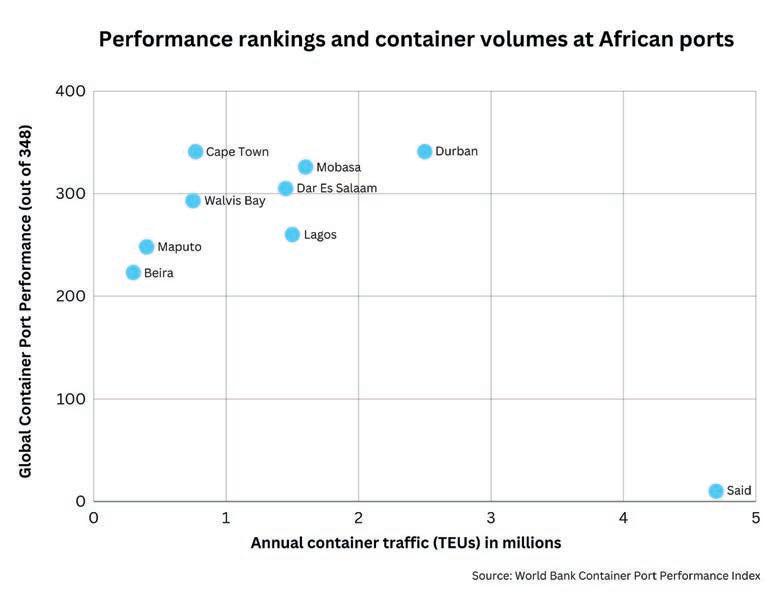
shipping lines have reacted by putting fewer vessels in. For me, the key measure is in port productivity, and I don’t think there have been any noticeable improvements in that regard.”
Mxolisi Mgojo, a CEO Sponsor of B4SA’s Transport and Logistics Focal Area (which collaborates with the National Logistics Crisis Committee, or NLCC), agrees, adding that the crisis is receiving substantial attention through public and private sector collaboration.

“There is no denying that performance is still poor as we continue to face many and varied challenges, but we are working hard to turn the situation around. The challenges facing the freight logistics system in South Africa cannot be solved overnight or in isolation, but we can work together and assume collective responsibility towards achieving a common goal, and we are confident that we are doing the right things,” Mgojo explains.
CAN WE BLAME THE PANDEMIC?
The COVID-19 pandemic has severely affected port performance, and some ports still struggle to recover from its impact. But those logistical problems only worsened existing issues at South Africa’s ports, while ports, such as Lagos and Maputo, improved on their pre-pandemic performance. Los Angeles, one of the lowest-ranked developed economy ports, dipped lower than local ports, but recovered to surpass them again. The Chinese port of Yangshan did not lose ground during the pandemic, moving from 15th to 1st globally.
Source: World Bank Container Port Index
82 SUPPLY CHAIN MANAGEMENT
Durban port’s container terminal.

THE QUESTION OF STATE CAPTURE
In a rare candid admission for a state-owned enterprise, Transnet Board chairperson Andile Sangqu cited “many years of underinvestment in equipment and its maintenance” as the leading cause for the port congestion. Some lay the blame at the feet of former Transnet CEO Portia Derby, who resigned in late 2023.
Derby’s era did mark a decline in revenue from R75-billion in 2020 to R68-billion in 2023, but it’s not the whole picture. Derby might have inherited a poisoned chalice, as the problems at our ports and railways precede her tenure. Transnet’s fortunes grew considerably under CEOs Brian Molefe and Syabinga Gama, rising from R37-billion in 2011 to R72-billion in 2018. Gama then resigned after being implicated in state capture fraud to the value of R405-million. The case is still ongoing.
Likewise, Molefe’s tenure brought growth to Transnet, but remains tainted with accusations of considerable corruption. The Zondo Commission’s State Capture report found that Molefe was one of the “primary architects and implementers of state capture at Transnet”. Molefe was also briefly at Eskom in another tenure tainted with corruption allegations. Were Transnet’s gains hiding mismanagement, severe corruption and long-term problems?
Hopefully, heads will roll, and several managers and executives have left under dark clouds.
While Transnet is clearing out some of its ineffective management, it does create a leadership vacuum. “There have been several departures of managers at various levels so, to some extent, there has been an acknowledgement of failure,” says Mike Walwyn, the SAAFF’s Western Cape representative.

PORT COMPETITION IN AFRICA
A lack of maintenance and investment characterises South African ports. Despite some recent improvements, local ports are falling behind the expansion of their continental competitors, putting South Africa at risk of losing its standing as Africa’s gateway. The International Maritime Bureau ranks South African ports among Africa’s worst performers.
Walvis Bay in Namibia recently completed an expansion that doubled its capacity, and it started developing the Walvis Bay corridor of road and rail links to bring goods to landlocked neighbours. Maputo in Mozambique has made numerous upgrades, including dredging a new deep-water channel, and its sister port at Beira has invested substantially in additional land rail capacity and natural gas facilities. Last year, Lagos in Nigeria opened the Lekki Deep Sea Port, its first deepwater facility, quadrupling the size of vessels that can berth in the country.
“The downside is that we haven’t seen any permanent appointments to replace them. The replacements are all there on an acting basis, so it’s difficult to assess what the long-term impact may be.”
STAYING AFLOAT
Fortunately, the crisis at Transnet is encouraging the state and private sectors to collaborate more closely. Local business leaders collaborate with the NLCC to implement remedies such as the Freight Logistics Roadmap and Transnet Recovery Plan. It’s one of several examples of government and business working together to tackle the country’s more pressing problems, such as energy and crime. This new era of trust is what can prevent South Africa’s ship from beaching.
“We must remember that within the transport and logistics industry, the state typically acts as the providers of infrastructure and spatial connectivity, whereas the private sector is made up of the business entities using these networks,” says Mgojo. “The two parties cannot exist without each other; therefore, collaboration is a necessary aspect of functioning logistics.”
SUPPLY CHAIN MANAGEMENT 83 PORTS
IMAGES: SKYPIXELS/WIKIMEDIA\, PICASA/WIKIMEDIA, OJAS NARAPPANAWAR/PEXELS
A bird’s-eye view of Durban port.
SUPPLY CHAIN PROFESSION’S TOUGHEST YEAR EVER?
Supply chain managers may experience their toughest year yet in 2024. Change has been the only constant in the sector for some time now, and the volatility is set to continue, fuelled by geopolitical tensions, climate crises and economic instability, according to SAPICS (The Professional Body for Supply Chain Management)
SAPICS president MJ Schoemaker says that the following trends will shape supply chains this year and should be on the agendas of savvy supply chain practitioners.
RISK MANAGEMENT
Risk management and supply chain resilience will be prioritised in 2024. Diversification of suppliers, production capabilities and transportation processes are some key strategies. Alternative materials and nontraditional partnerships will be explored. Many supply chains will become more compact and localised. Resilient supply chain design will be critical to mitigating disruptive events faster than the competition, providing excellent customer service and generating value and market share.
In South Africa, the electricity crisis, looming water crisis and decaying infrastructure will exacerbate supply chain challenges and uncertainty. South African businesses will become increasingly self-sufficient regarding electricity, with most organisations investing in alternative energy sources, such as solar, and implementing water backup solutions. The cost of managing this is high and will roll over to the consumer at some point.
DIGITISATION
The future of supply chain is innovative and realtime through digitisation. Digitised supply chains enable unprecedented visibility across the network. Digital technologies can alleviate the
IN 2024, SUPPLY CHAIN LEADERS WILL ACCELERATE THEIR INVESTMENT IN APPLICATIONS THAT SUPPORT ARTIFICIAL INTELLIGENCE AND ADVANCED ANALYTICS CAPABILITIES.
uncertainty and help supply chain professionals predict, plan for and protect their businesses against disruptions.
Digitisation has been a supply chain priority for some years. In 2024, supply chain leaders will accelerate their investment in applications that support artifi cial intelligence and advanced analytics capabilities.
ARTIFICIAL INTELLIGENCE
Artifi cial Intelligence (AI) is proving an extremely useful tool for supply chain managers. It is being used successfully in several practical applications in the supply chain, including demand forecasting, risk, inventory and quality management, and transport and distribution optimisation. AI is advancing at an unprecedented rate and will be used in many more supply chain applications in 2024.
BIG DATA AND ANALYTICS
Data is vital for optimising supply chains. It is more important than ever in the current uncertain and disruption-fraught business environment. Through supply chain big data and analytics, organisations can identify inefficiencies.

ENVIRONMENTAL, SOCIAL AND GOVERNANCE
In 2024, supply chains will be more humancentric and sustainable. Environmental, social and governance (ESG) considerations have become integral to supply chain management. As stakeholders demand greater transparency and accountability, integrating ESG factors into supply chain strategies has become imperative for companies seeking to thrive in a socially conscious marketplace.
SKILLS DEVELOPMENT
Supply chain management is a constantly evolving and changing profession with rapid introduction of new technologies. Businesses are struggling to find people with the required skill sets. Educating and upskilling supply chain professionals is key to ensuring that all investments in innovation have a return on investment. Areas, such as planning, risk management, sustainability and the basics of supply chain, especially in the health sector, are crucial.
CONFERENCE TO FOCUS ON CHALLENGES
Recognising these factors, this year’s annual SAPICS Conference – which takes place in Cape Town in June in association with the Southern African Association of Freight Forwarders (SAAFF) – has sessions dedicated to global health supply chain challenges. The panel discussions, presentations, workshops and networking opportunities will help attendees to learn from one another and lead to collaborations that will benefit the supply chain workforce, health systems and ultimately populations on the African continent.


To maximise the potential of big data and analytics, supply chain professionals must prioritise data exchange and information-sharing. Integration of data, data analytics and key metrics across the supply chain will enable early identification of potential disruptions and opportunities.

84 SUPPLY CHAIN MANAGEMENT ADVERTORIAL SAPICS
Supplied
Images:
Learning, sharing knowledge and networking at the annual SAPICS Conference for supply chain professionals.
SAPICS For more information: +27 (0) 10 013 3442 info@sapics.org.za www.sapics.org
Scan this QR code to go directly to the SAPICS website
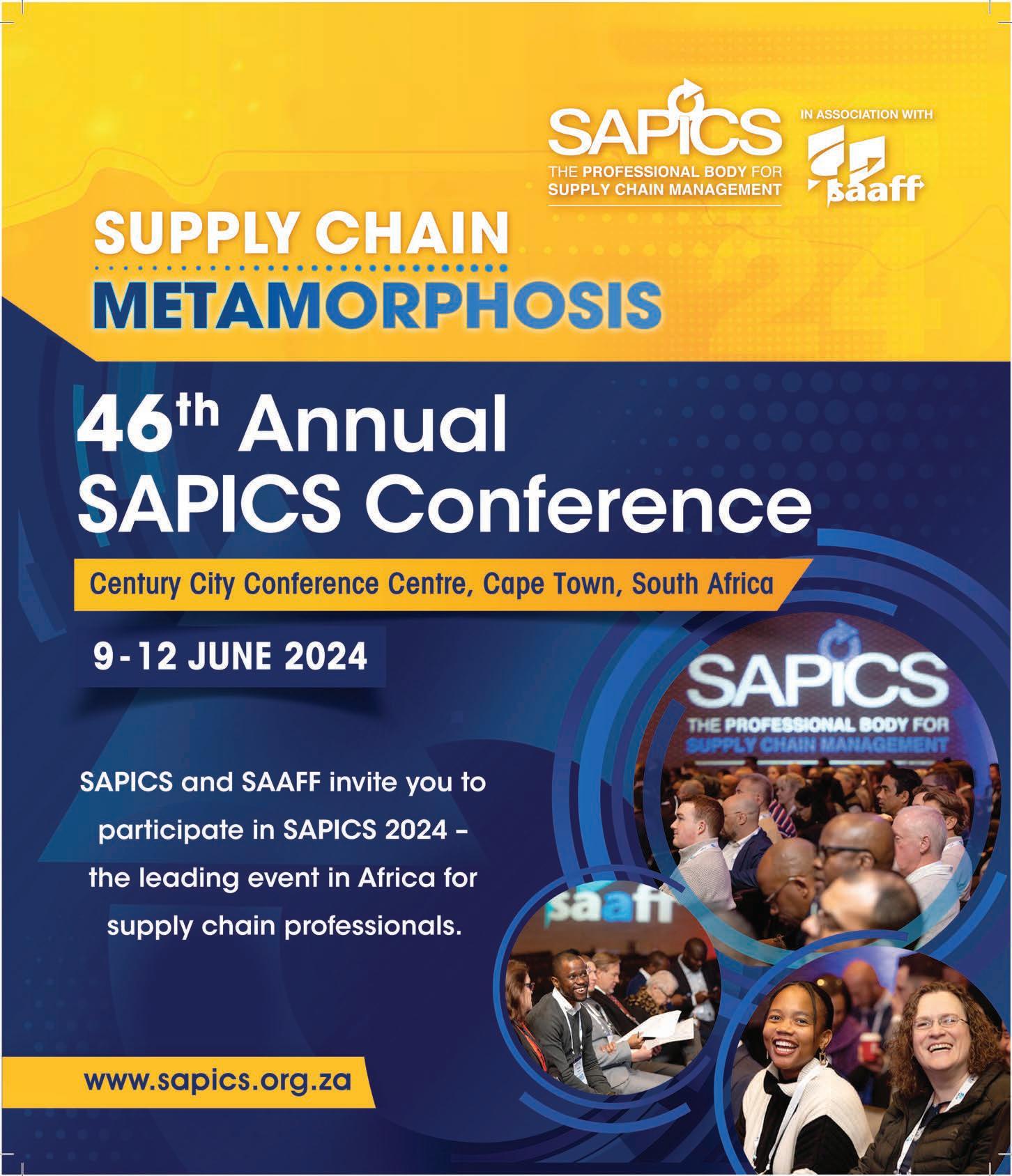
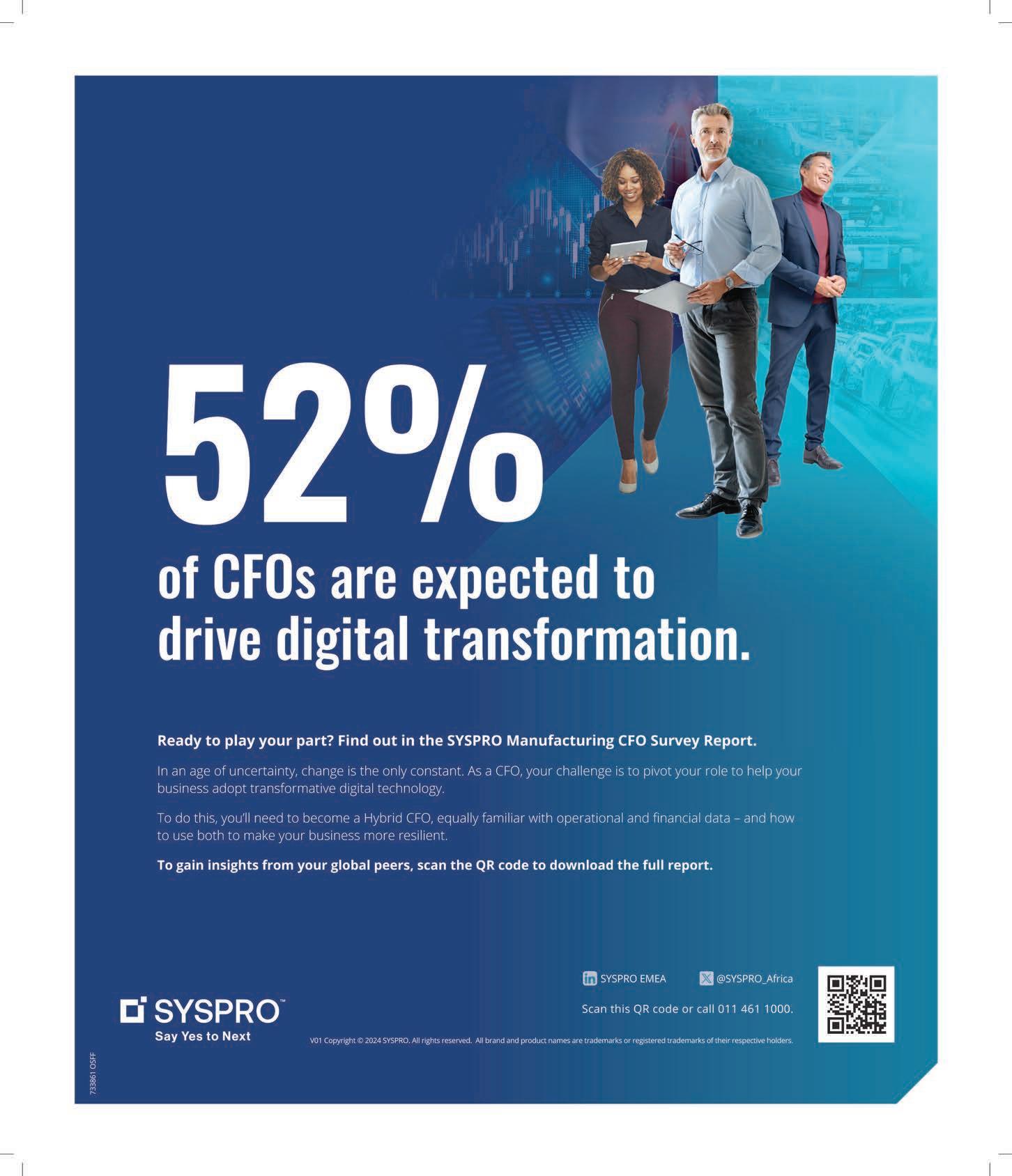
































 Eric Gower-Winter
Eric Gower-Winter





























































































































































